VR Architecture Design Process in Transformation: Big Data Era
VerifiedAdded on 2023/03/17
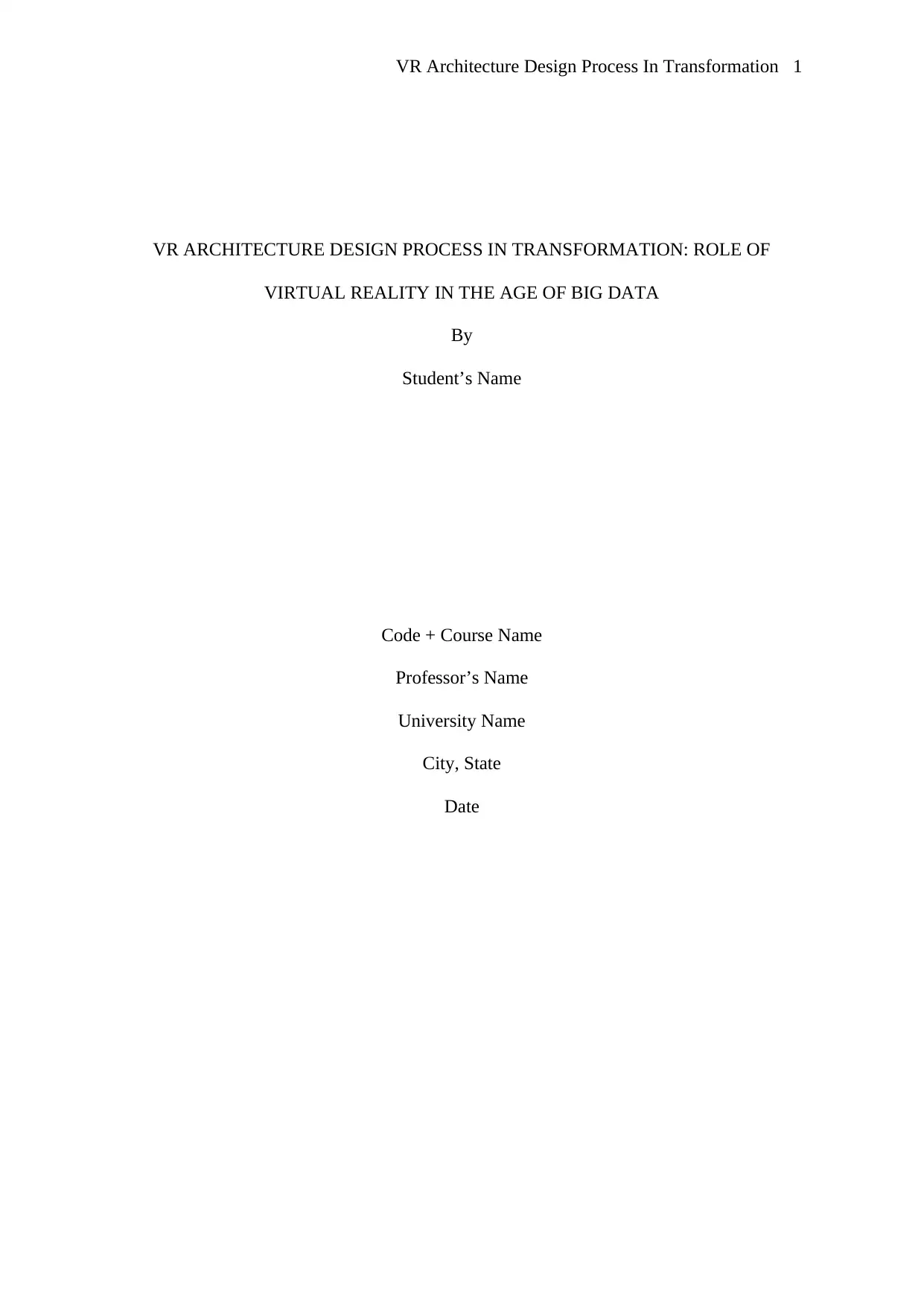
VR ARCHITECTURE DESIGN PROCESS IN TRANSFORMATION: ROLE OF
VIRTUAL REALITY IN THE AGE OF BIG DATA
By
Student’s Name
Code + Course Name
Professor’s Name
University Name
City, State
Date
Paraphrase This Document
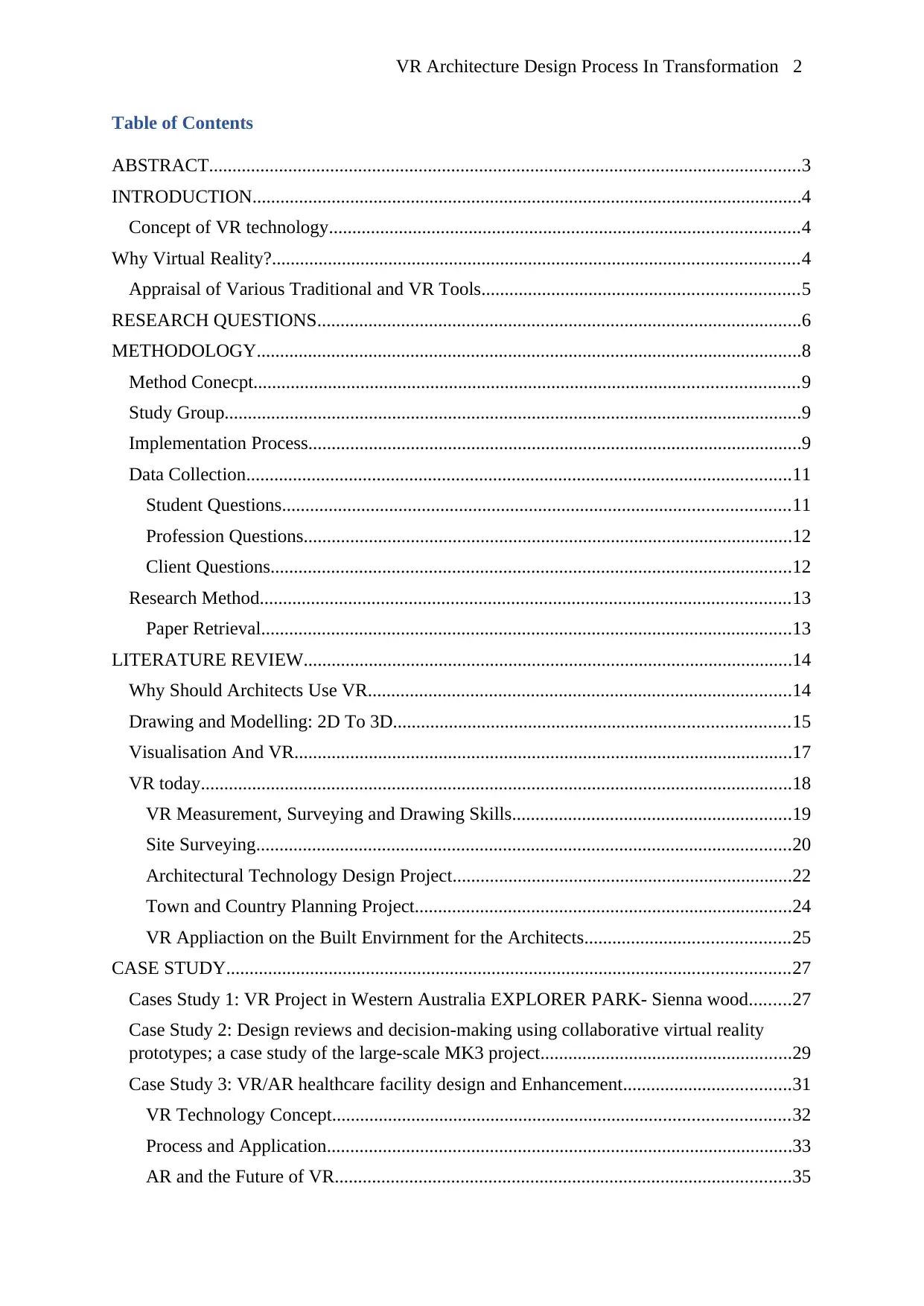
Table of Contents
ABSTRACT...............................................................................................................................3
INTRODUCTION......................................................................................................................4
Concept of VR technology.....................................................................................................4
Why Virtual Reality?.................................................................................................................4
Appraisal of Various Traditional and VR Tools....................................................................5
RESEARCH QUESTIONS........................................................................................................6
METHODOLOGY.....................................................................................................................8
Method Conecpt.....................................................................................................................9
Study Group............................................................................................................................9
Implementation Process..........................................................................................................9
Data Collection.....................................................................................................................11
Student Questions.............................................................................................................11
Profession Questions.........................................................................................................12
Client Questions................................................................................................................12
Research Method..................................................................................................................13
Paper Retrieval..................................................................................................................13
LITERATURE REVIEW.........................................................................................................14
Why Should Architects Use VR...........................................................................................14
Drawing and Modelling: 2D To 3D.....................................................................................15
Visualisation And VR...........................................................................................................17
VR today...............................................................................................................................18
VR Measurement, Surveying and Drawing Skills............................................................19
Site Surveying...................................................................................................................20
Architectural Technology Design Project.........................................................................22
Town and Country Planning Project.................................................................................24
VR Appliaction on the Built Envirnment for the Architects............................................25
CASE STUDY.........................................................................................................................27
Cases Study 1: VR Project in Western Australia EXPLORER PARK- Sienna wood.........27
Case Study 2: Design reviews and decision-making using collaborative virtual reality
prototypes; a case study of the large-scale MK3 project......................................................29
Case Study 3: VR/AR healthcare facility design and Enhancement....................................31
VR Technology Concept..................................................................................................32
Process and Application....................................................................................................33
AR and the Future of VR..................................................................................................35
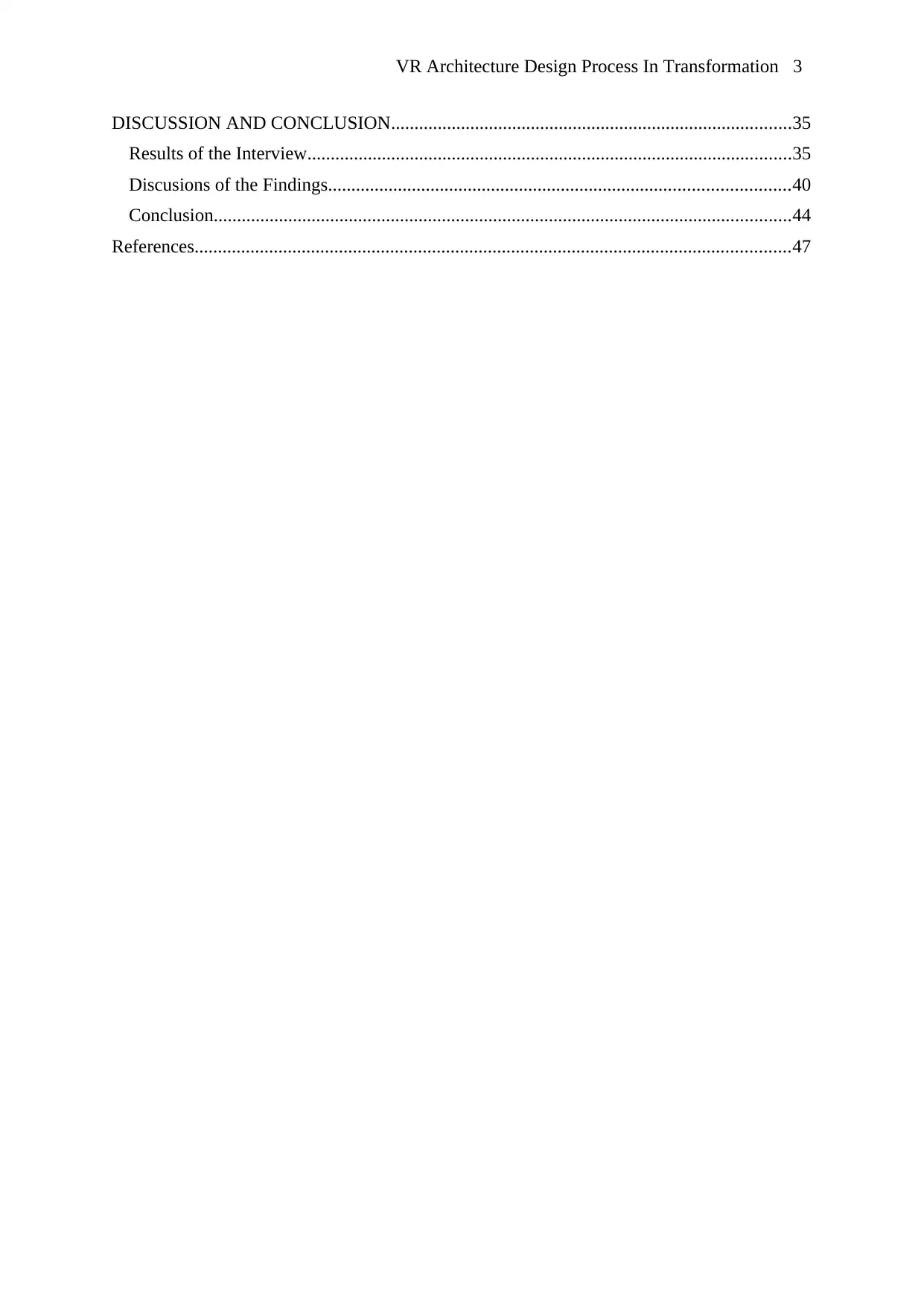
DISCUSSION AND CONCLUSION......................................................................................35
Results of the Interview........................................................................................................35
Discusions of the Findings...................................................................................................40
Conclusion............................................................................................................................44
References................................................................................................................................47
⊘ This is a preview!⊘
Do you want full access?
Subscribe today to unlock all pages.

Trusted by 1+ million students worldwide

Paraphrase This Document

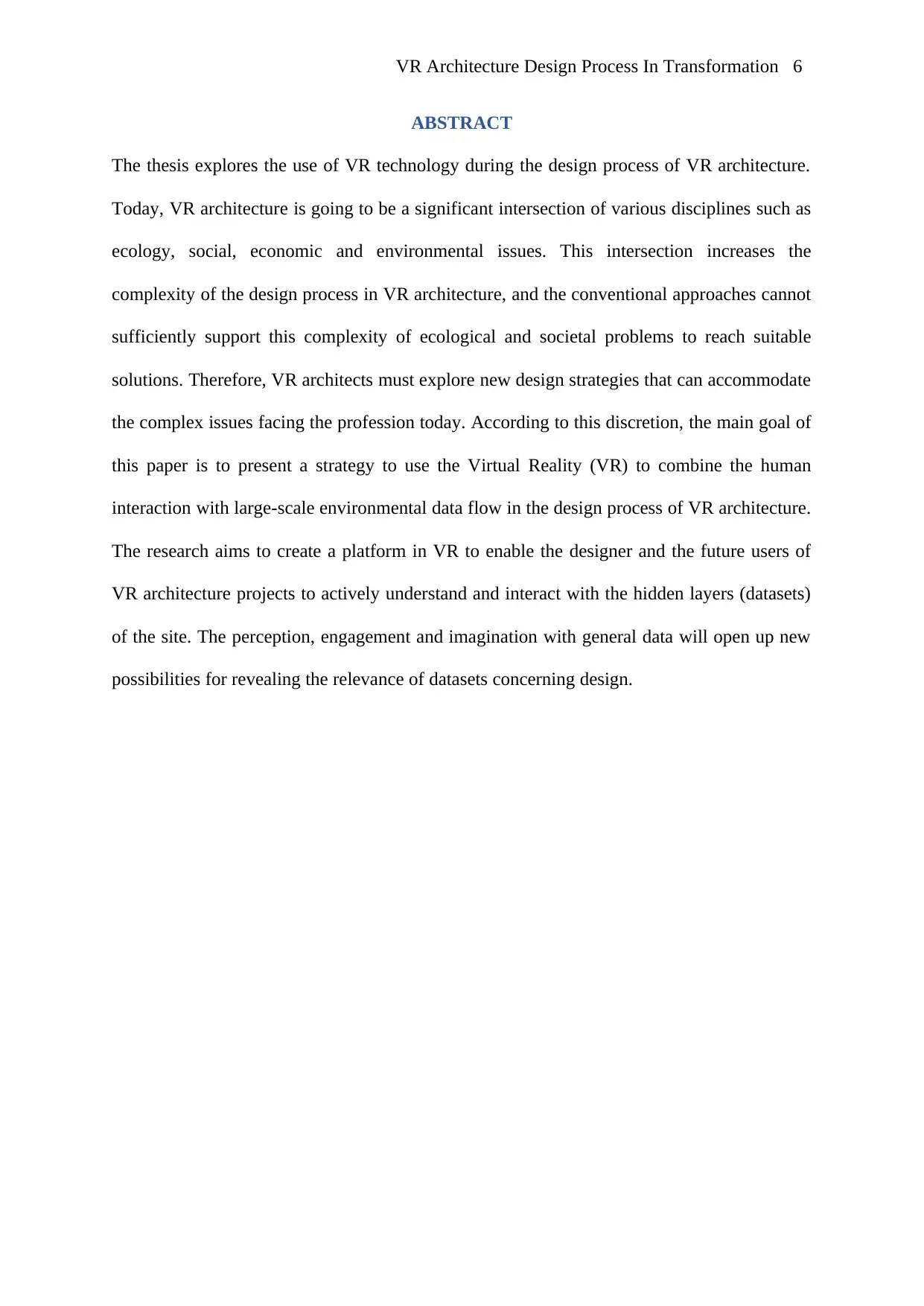
ABSTRACT
The thesis explores the use of VR technology during the design process of VR architecture.
Today, VR architecture is going to be a significant intersection of various disciplines such as
ecology, social, economic and environmental issues. This intersection increases the
complexity of the design process in VR architecture, and the conventional approaches cannot
sufficiently support this complexity of ecological and societal problems to reach suitable
solutions. Therefore, VR architects must explore new design strategies that can accommodate
the complex issues facing the profession today. According to this discretion, the main goal of
this paper is to present a strategy to use the Virtual Reality (VR) to combine the human
interaction with large-scale environmental data flow in the design process of VR architecture.
The research aims to create a platform in VR to enable the designer and the future users of
VR architecture projects to actively understand and interact with the hidden layers (datasets)
of the site. The perception, engagement and imagination with general data will open up new
possibilities for revealing the relevance of datasets concerning design.
⊘ This is a preview!⊘
Do you want full access?
Subscribe today to unlock all pages.

Trusted by 1+ million students worldwide
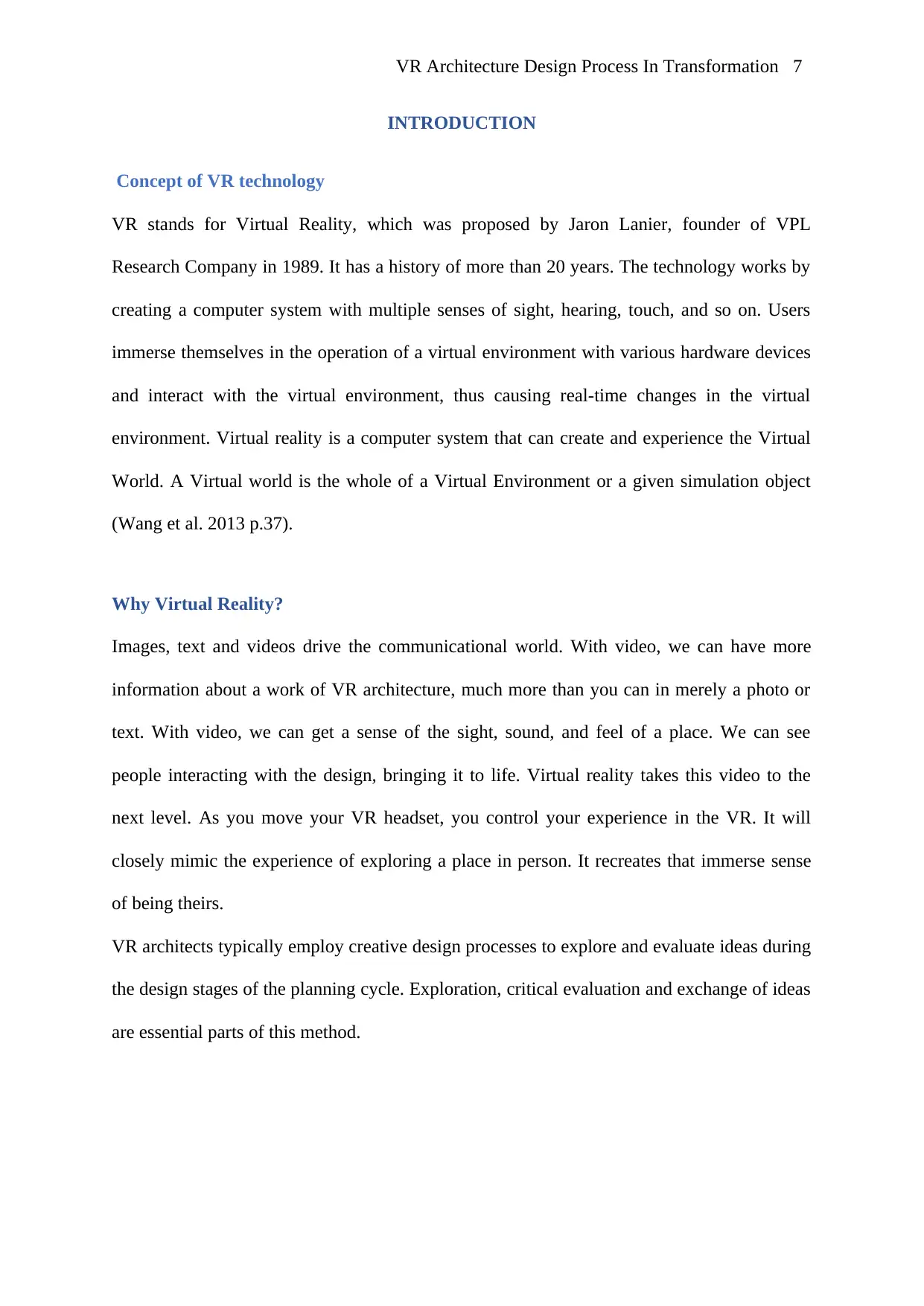
INTRODUCTION
Concept of VR technology
VR stands for Virtual Reality, which was proposed by Jaron Lanier, founder of VPL
Research Company in 1989. It has a history of more than 20 years. The technology works by
creating a computer system with multiple senses of sight, hearing, touch, and so on. Users
immerse themselves in the operation of a virtual environment with various hardware devices
and interact with the virtual environment, thus causing real-time changes in the virtual
environment. Virtual reality is a computer system that can create and experience the Virtual
World. A Virtual world is the whole of a Virtual Environment or a given simulation object
(Wang et al. 2013 p.37).
Why Virtual Reality?
Images, text and videos drive the communicational world. With video, we can have more
information about a work of VR architecture, much more than you can in merely a photo or
text. With video, we can get a sense of the sight, sound, and feel of a place. We can see
people interacting with the design, bringing it to life. Virtual reality takes this video to the
next level. As you move your VR headset, you control your experience in the VR. It will
closely mimic the experience of exploring a place in person. It recreates that immerse sense
of being theirs.
VR architects typically employ creative design processes to explore and evaluate ideas during
the design stages of the planning cycle. Exploration, critical evaluation and exchange of ideas
are essential parts of this method.
Paraphrase This Document
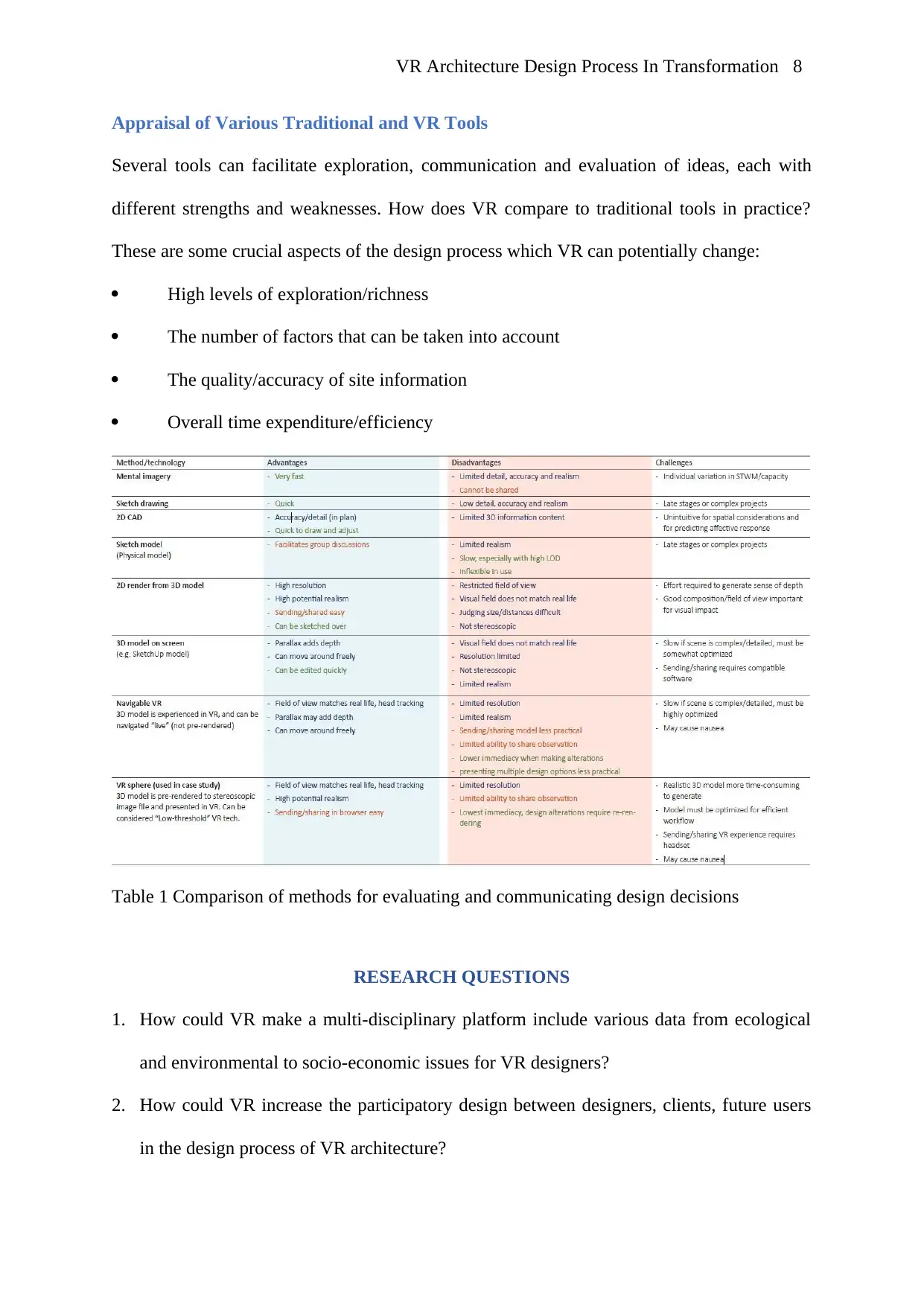
Appraisal of Various Traditional and VR Tools
Several tools can facilitate exploration, communication and evaluation of ideas, each with
different strengths and weaknesses. How does VR compare to traditional tools in practice?
These are some crucial aspects of the design process which VR can potentially change:
High levels of exploration/richness
The number of factors that can be taken into account
The quality/accuracy of site information
Overall time expenditure/efficiency
Table 1 Comparison of methods for evaluating and communicating design decisions
RESEARCH QUESTIONS
1. How could VR make a multi-disciplinary platform include various data from ecological
and environmental to socio-economic issues for VR designers?
2. How could VR increase the participatory design between designers, clients, future users
in the design process of VR architecture?
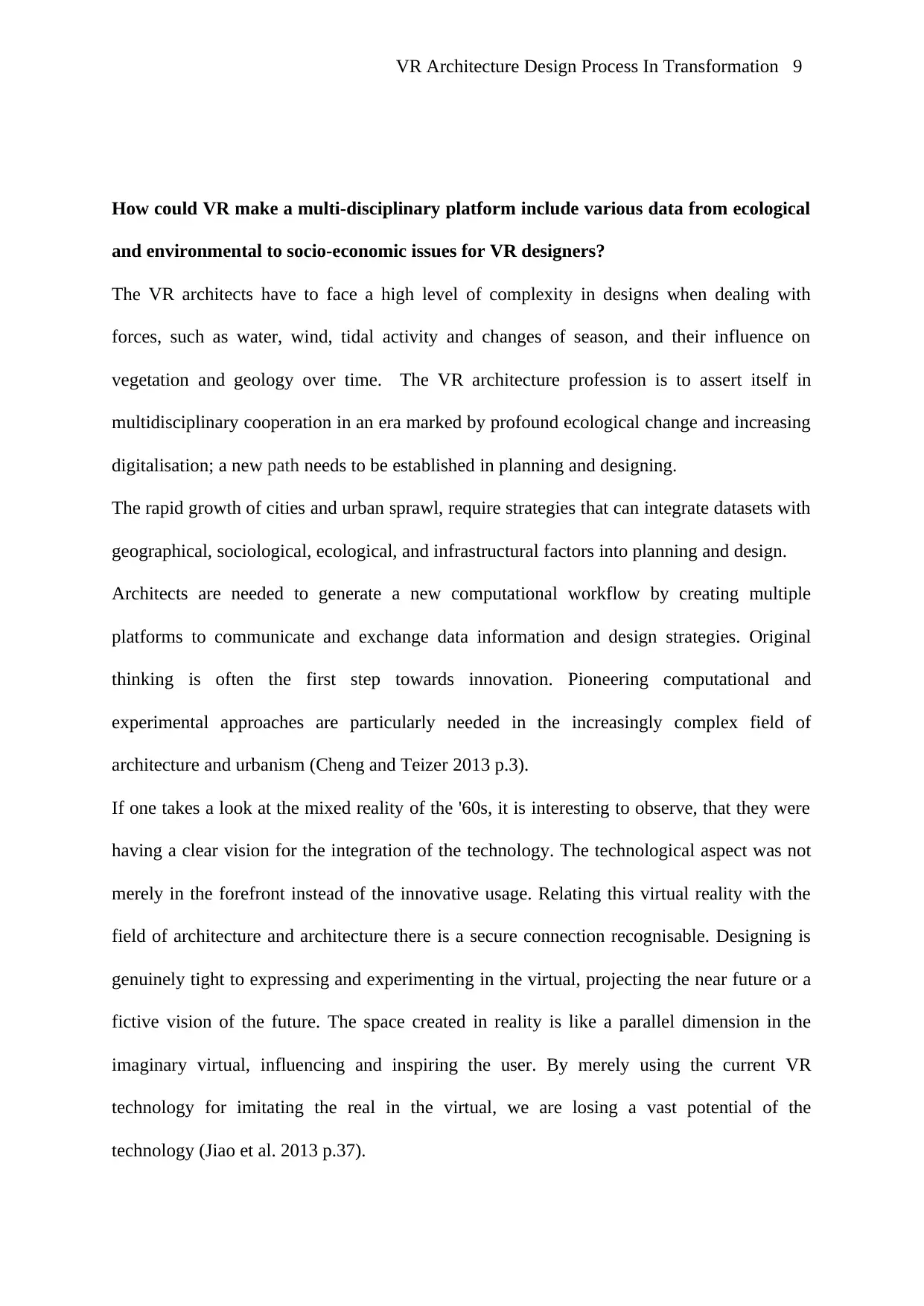
How could VR make a multi-disciplinary platform include various data from ecological
and environmental to socio-economic issues for VR designers?
The VR architects have to face a high level of complexity in designs when dealing with
forces, such as water, wind, tidal activity and changes of season, and their influence on
vegetation and geology over time. The VR architecture profession is to assert itself in
multidisciplinary cooperation in an era marked by profound ecological change and increasing
digitalisation; a new path needs to be established in planning and designing.
The rapid growth of cities and urban sprawl, require strategies that can integrate datasets with
geographical, sociological, ecological, and infrastructural factors into planning and design.
Architects are needed to generate a new computational workflow by creating multiple
platforms to communicate and exchange data information and design strategies. Original
thinking is often the first step towards innovation. Pioneering computational and
experimental approaches are particularly needed in the increasingly complex field of
architecture and urbanism (Cheng and Teizer 2013 p.3).
If one takes a look at the mixed reality of the '60s, it is interesting to observe, that they were
having a clear vision for the integration of the technology. The technological aspect was not
merely in the forefront instead of the innovative usage. Relating this virtual reality with the
field of architecture and architecture there is a secure connection recognisable. Designing is
genuinely tight to expressing and experimenting in the virtual, projecting the near future or a
fictive vision of the future. The space created in reality is like a parallel dimension in the
imaginary virtual, influencing and inspiring the user. By merely using the current VR
technology for imitating the real in the virtual, we are losing a vast potential of the
technology (Jiao et al. 2013 p.37).
⊘ This is a preview!⊘
Do you want full access?
Subscribe today to unlock all pages.

Trusted by 1+ million students worldwide
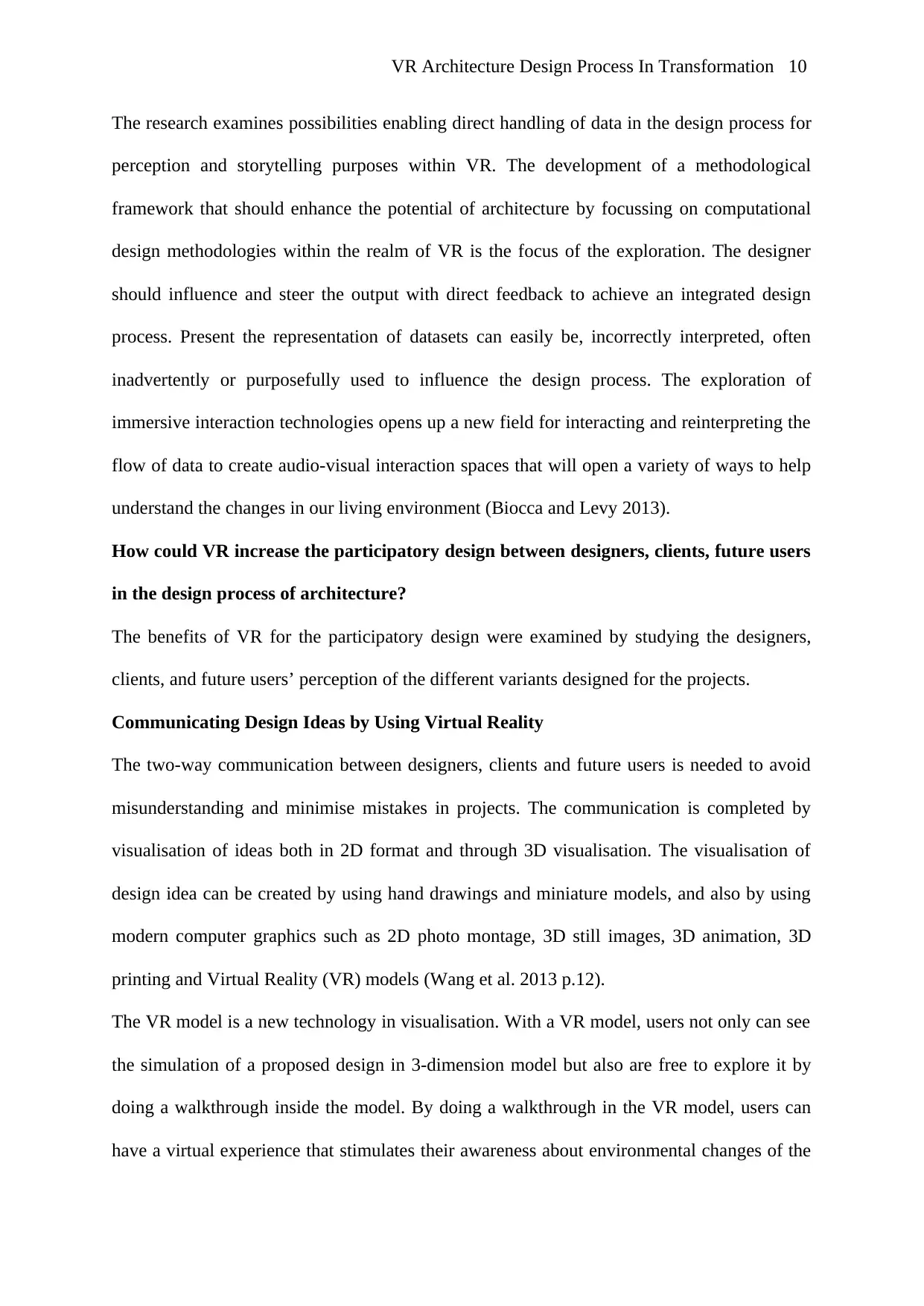
The research examines possibilities enabling direct handling of data in the design process for
perception and storytelling purposes within VR. The development of a methodological
framework that should enhance the potential of architecture by focussing on computational
design methodologies within the realm of VR is the focus of the exploration. The designer
should influence and steer the output with direct feedback to achieve an integrated design
process. Present the representation of datasets can easily be, incorrectly interpreted, often
inadvertently or purposefully used to influence the design process. The exploration of
immersive interaction technologies opens up a new field for interacting and reinterpreting the
flow of data to create audio-visual interaction spaces that will open a variety of ways to help
understand the changes in our living environment (Biocca and Levy 2013).
How could VR increase the participatory design between designers, clients, future users
in the design process of architecture?
The benefits of VR for the participatory design were examined by studying the designers,
clients, and future users’ perception of the different variants designed for the projects.
Communicating Design Ideas by Using Virtual Reality
The two-way communication between designers, clients and future users is needed to avoid
misunderstanding and minimise mistakes in projects. The communication is completed by
visualisation of ideas both in 2D format and through 3D visualisation. The visualisation of
design idea can be created by using hand drawings and miniature models, and also by using
modern computer graphics such as 2D photo montage, 3D still images, 3D animation, 3D
printing and Virtual Reality (VR) models (Wang et al. 2013 p.12).
The VR model is a new technology in visualisation. With a VR model, users not only can see
the simulation of a proposed design in 3-dimension model but also are free to explore it by
doing a walkthrough inside the model. By doing a walkthrough in the VR model, users can
have a virtual experience that stimulates their awareness about environmental changes of the
Paraphrase This Document

project site. Nowadays, high visual qualities and realism are becoming increasingly available
in real-time software.
Virtual reality such as in-game technology is essential for architecture works because it can
help to make a lot of technical problems more comfortable to understand by providing tools
and information handled.
Public participation is one of the methods to gather information about the user’s response to
the design proposed. Public participation is essential because it influences environmental
mediation and decision making. The location of the designer and stakeholders can even be on
different continents. Here, the Internet is an appropriate tool to do two way-communications
between designers and stakeholders located in various places.
METHODOLOGY
This section encompasses on the method which one can employ to gather the information
regarding the application and the utilization of the VR technology and overall utilization in
the architectural works and design. The gathering of the information incorporates the
utilization of both the qualitative and quantizes data analysis. The information grounded for
this study largely obtained from the literature reviews, case studies as well as the qualitative
research conducted in the process. The qualitative method applied in this process is the
interview technique. This section therefore, carried out in various sub sections as follows
Method Concept
In the examination and the evaluation of the VR technologies, various case studies associated
with the qualitative research method was applied. There was the determination of the general
opinions of the different participants as well as the analysis on in-depth norms associated
with the selected method. Also, the reasons behind the opinions of the various participants as
far as the VR application in the architect was also compounded and detailed. Grounded on the
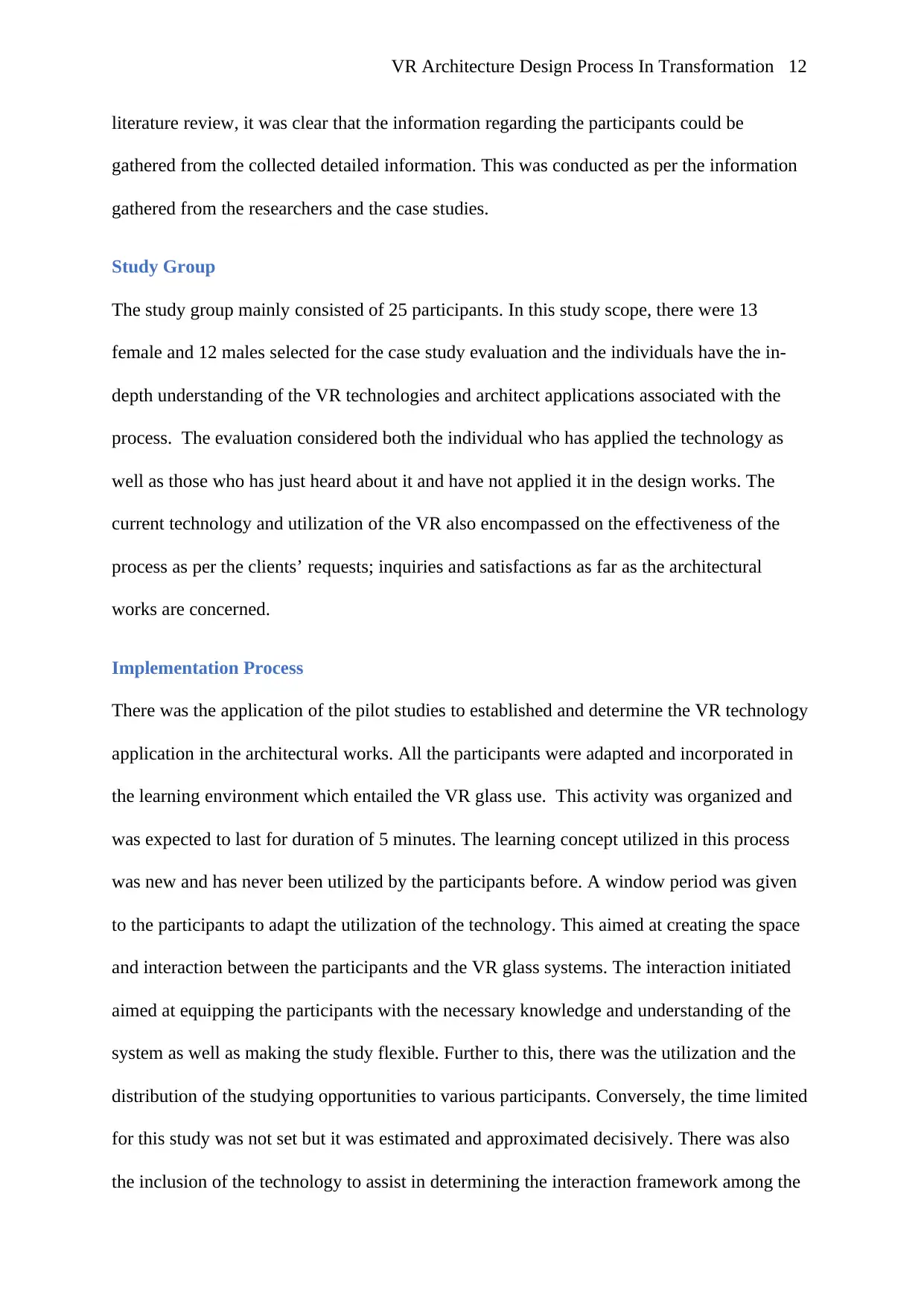
literature review, it was clear that the information regarding the participants could be
gathered from the collected detailed information. This was conducted as per the information
gathered from the researchers and the case studies.
Study Group
The study group mainly consisted of 25 participants. In this study scope, there were 13
female and 12 males selected for the case study evaluation and the individuals have the in-
depth understanding of the VR technologies and architect applications associated with the
process. The evaluation considered both the individual who has applied the technology as
well as those who has just heard about it and have not applied it in the design works. The
current technology and utilization of the VR also encompassed on the effectiveness of the
process as per the clients’ requests; inquiries and satisfactions as far as the architectural
works are concerned.
Implementation Process
There was the application of the pilot studies to established and determine the VR technology
application in the architectural works. All the participants were adapted and incorporated in
the learning environment which entailed the VR glass use. This activity was organized and
was expected to last for duration of 5 minutes. The learning concept utilized in this process
was new and has never been utilized by the participants before. A window period was given
to the participants to adapt the utilization of the technology. This aimed at creating the space
and interaction between the participants and the VR glass systems. The interaction initiated
aimed at equipping the participants with the necessary knowledge and understanding of the
system as well as making the study flexible. Further to this, there was the utilization and the
distribution of the studying opportunities to various participants. Conversely, the time limited
for this study was not set but it was estimated and approximated decisively. There was also
the inclusion of the technology to assist in determining the interaction framework among the
⊘ This is a preview!⊘
Do you want full access?
Subscribe today to unlock all pages.

Trusted by 1+ million students worldwide
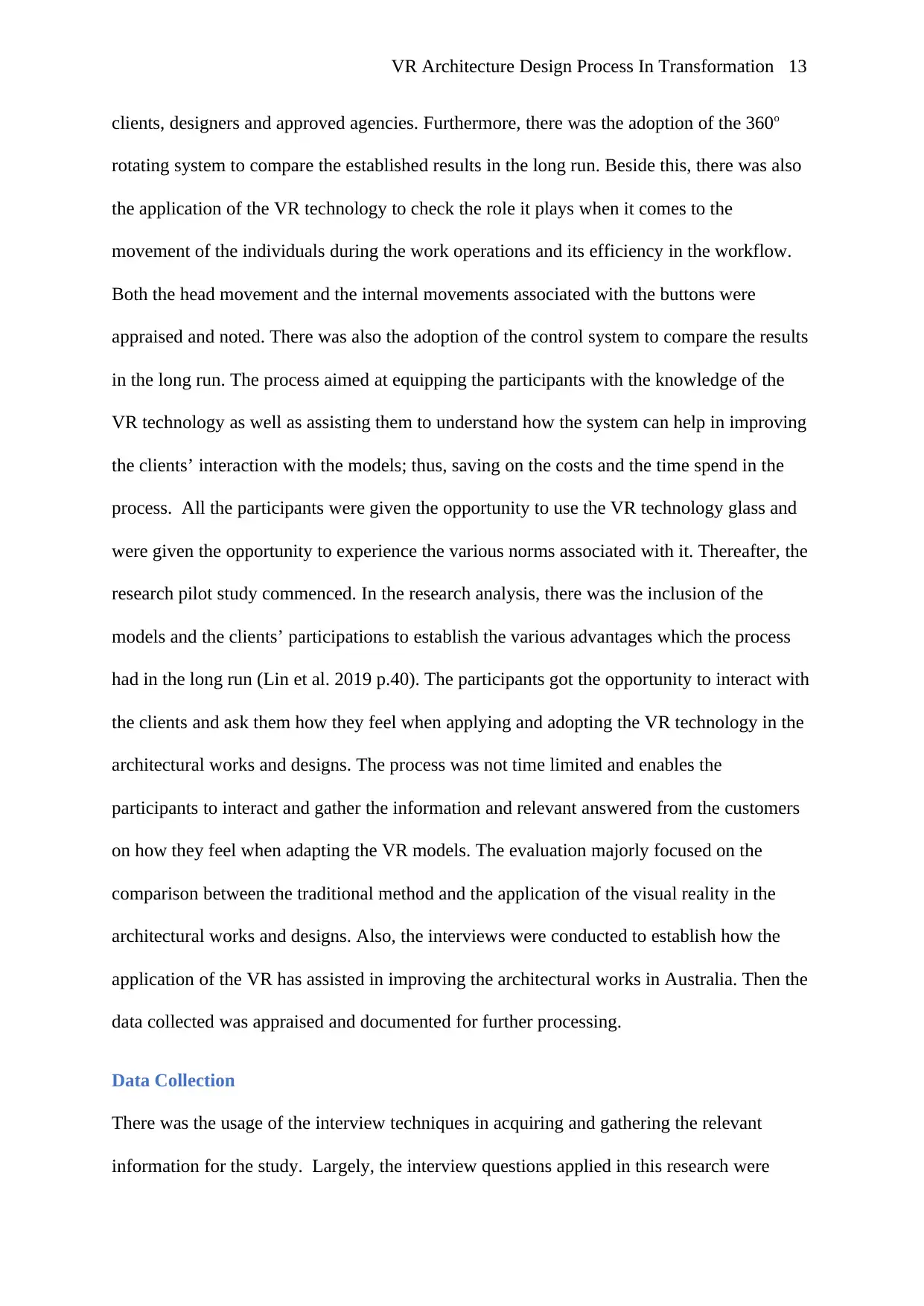
clients, designers and approved agencies. Furthermore, there was the adoption of the 360o
rotating system to compare the established results in the long run. Beside this, there was also
the application of the VR technology to check the role it plays when it comes to the
movement of the individuals during the work operations and its efficiency in the workflow.
Both the head movement and the internal movements associated with the buttons were
appraised and noted. There was also the adoption of the control system to compare the results
in the long run. The process aimed at equipping the participants with the knowledge of the
VR technology as well as assisting them to understand how the system can help in improving
the clients’ interaction with the models; thus, saving on the costs and the time spend in the
process. All the participants were given the opportunity to use the VR technology glass and
were given the opportunity to experience the various norms associated with it. Thereafter, the
research pilot study commenced. In the research analysis, there was the inclusion of the
models and the clients’ participations to establish the various advantages which the process
had in the long run (Lin et al. 2019 p.40). The participants got the opportunity to interact with
the clients and ask them how they feel when applying and adopting the VR technology in the
architectural works and designs. The process was not time limited and enables the
participants to interact and gather the information and relevant answered from the customers
on how they feel when adapting the VR models. The evaluation majorly focused on the
comparison between the traditional method and the application of the visual reality in the
architectural works and designs. Also, the interviews were conducted to establish how the
application of the VR has assisted in improving the architectural works in Australia. Then the
data collected was appraised and documented for further processing.
Data Collection
There was the usage of the interview techniques in acquiring and gathering the relevant
information for the study. Largely, the interview questions applied in this research were
Paraphrase This Document

largely prepared and appraised as per the study to meet the set criteria and help in answering
all the related questions in the long run. There was the application of the semi-structure
interview question which at least 6 questions attached to the VR applications and the
comparison to the traditional methods in the long run. The validations of the questions were
conducted to ensure that they meet the set standards. This process involved the utilization of
the system which included the three experts. Also, there were controlled developed answered
which was applied in validating the overall process. The interview process largely conducted
after the implementations process was carried out. Also, the interview included the appraisal
of the advantages of the VR technique in the architectural works as far as the clients and the
approved agencies are concerned. The questions asked during the interview mainly sub-
divided into three categories for the students, clients and professions. Some of the interview
question asked and appraised in the process included the following
Student Questions
Which work methods do you use occasionally & Daily?
Hand drawing
Physical model
2D cad
Digital 3D
VR
Are you familiar with the concept of Virtual reality?
Have you gone through a virtual reality experience before?
Have you used VR tools in your design work before?
How useful do you expect VR to be in your design process?
Why do you imagine VR is not more widely used within landscape architecture?
How VR could increase the participation in Design process?

What are the main barriers which might keep you from adopting VR technology?
Profession Questions
1. How VR could increase the participation in Design process?
2. How useful do you expect VR to be in your design process?
3. Is your firm started using VR in Landscape architecture Projects? If yes which tools
you use if not why still not started using
Client Questions
1. What are some of the advantages associated with the VR technology in the
architectural field?
2. What is the comparison and the relations which the traditional method have when
compared to the Visual Reality method?
3. What are the customers’ benefits which one obtains when utilizing the VR technique?
4. What are some of the economic viability of using the VR technology in the
architectural designs?
5. Do clients, architects and approved agencies agreed to the adoptions of the VR
technology over traditional method?
6. What recommendation can one recommend as far as the application of the VR over
the Traditional method is concerned?
Preferably, it is important to note that the questions asked were open ended and thus, the
participants were not restricted to the answers. Thus, variety of answers was expected to be
obtained from the process. However, the use of the literature reviews was employed as the
control process for the data collection and interpretation of the obtained information in the
long run.
⊘ This is a preview!⊘
Do you want full access?
Subscribe today to unlock all pages.

Trusted by 1+ million students worldwide
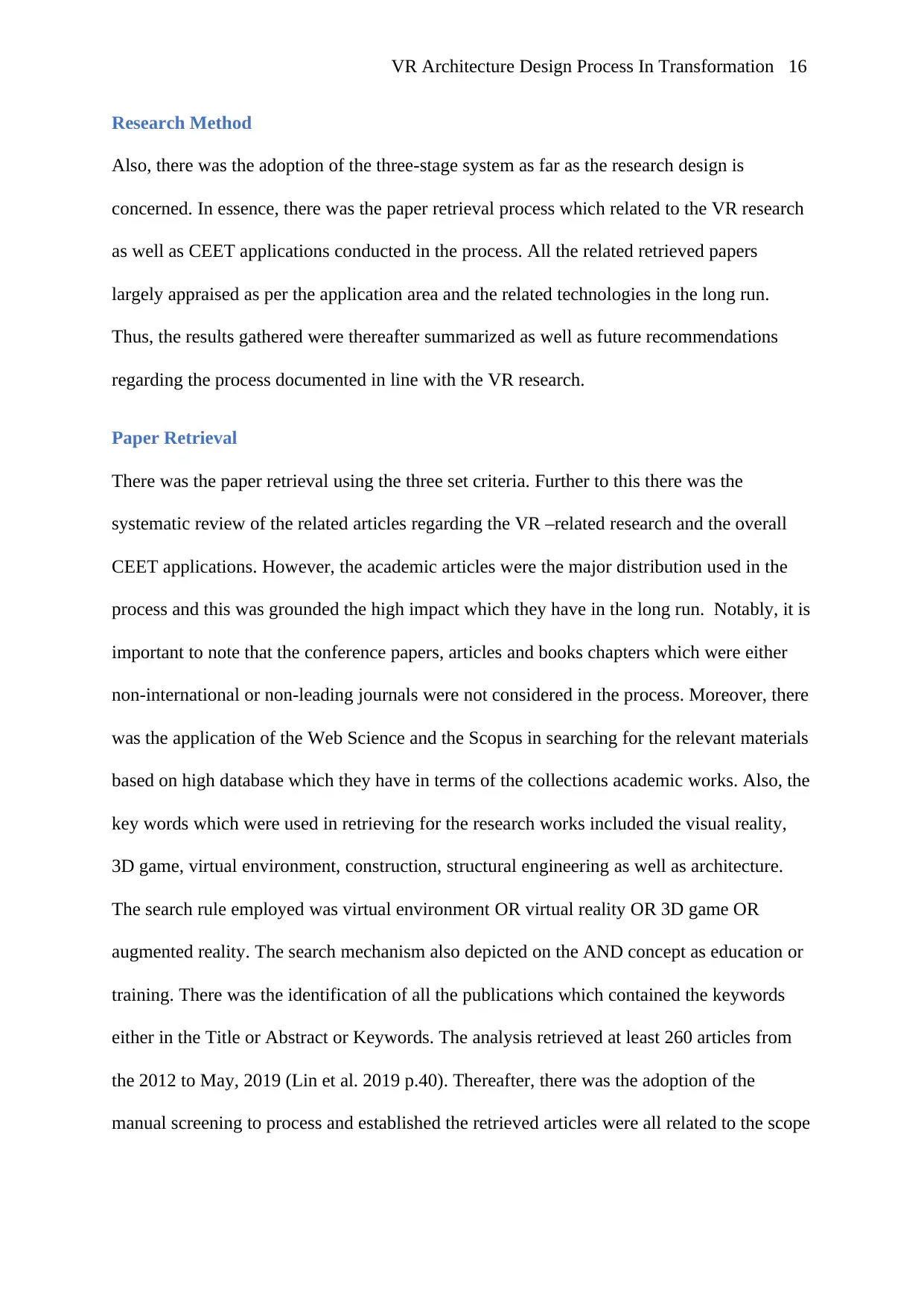
Research Method
Also, there was the adoption of the three-stage system as far as the research design is
concerned. In essence, there was the paper retrieval process which related to the VR research
as well as CEET applications conducted in the process. All the related retrieved papers
largely appraised as per the application area and the related technologies in the long run.
Thus, the results gathered were thereafter summarized as well as future recommendations
regarding the process documented in line with the VR research.
Paper Retrieval
There was the paper retrieval using the three set criteria. Further to this there was the
systematic review of the related articles regarding the VR –related research and the overall
CEET applications. However, the academic articles were the major distribution used in the
process and this was grounded the high impact which they have in the long run. Notably, it is
important to note that the conference papers, articles and books chapters which were either
non-international or non-leading journals were not considered in the process. Moreover, there
was the application of the Web Science and the Scopus in searching for the relevant materials
based on high database which they have in terms of the collections academic works. Also, the
key words which were used in retrieving for the research works included the visual reality,
3D game, virtual environment, construction, structural engineering as well as architecture.
The search rule employed was virtual environment OR virtual reality OR 3D game OR
augmented reality. The search mechanism also depicted on the AND concept as education or
training. There was the identification of all the publications which contained the keywords
either in the Title or Abstract or Keywords. The analysis retrieved at least 260 articles from
the 2012 to May, 2019 (Lin et al. 2019 p.40). Thereafter, there was the adoption of the
manual screening to process and established the retrieved articles were all related to the scope
Paraphrase This Document

of the study. This led to the identification of 60 publications which encompassed on the
analysis and were considered for this research.
LITERATURE REVIEW
The literature review section is not only important for this project equally fundamental in the
long run. Chapter encompassed on the various sections as far as the evaluation of the Visual
Reality in the architectural works are concerned. The analysis ranges from the history of the
VR, the benefits associated with the adoption, the importance as far as the clients as
reconvened as well as the future needs to be incorporated in the architecture works. This
section thus, mainly evaluated and appraised as by the sections below
Why Should Architects Use VR
Virtual Reality (VR) is a useful tool for architects, architects, and developers – really anyone
involved in designing natural environments. For architecture firms, this is an excellent way to
show clients that a place they’ve created works – that people enjoy hanging out there, that
kids love playing there, that people are going to the events there. Architecture is a unique
position to apply both scientific knowledge and creative thinking to the complex social and
environmental challenges of the modern era. Digital technologies are now critically important
in crafting the most, intelligent and sophisticated designs that are important for the creation of
active and dynamic forms. The CAD (Computer-aided design) began to emerge in the 1980s,
but it wasn’t until the following decade that it became influential to the architecture
profession (Behzadan and Kamat 2013 p.3).
Virtual Reality (VR) in Architecture has certain advantages compared to other representation
tools traditionally used (2D drawings, images and video). VR exceeds the capability of
visualising of the present situation and offers a medium to examine the future and the past of
VR scenes as the computer graphics hardware, and software is getting cheaper and more
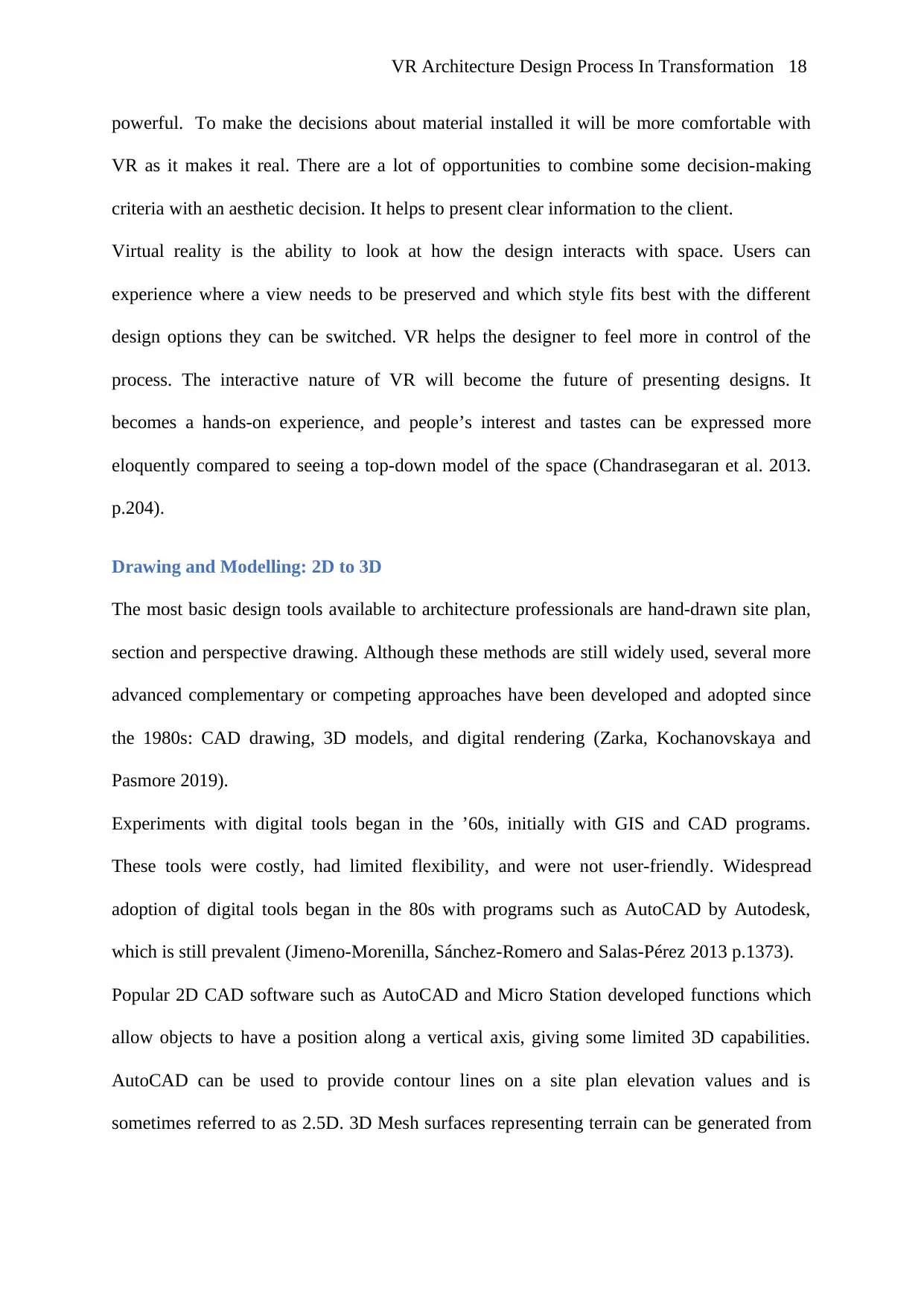
powerful. To make the decisions about material installed it will be more comfortable with
VR as it makes it real. There are a lot of opportunities to combine some decision-making
criteria with an aesthetic decision. It helps to present clear information to the client.
Virtual reality is the ability to look at how the design interacts with space. Users can
experience where a view needs to be preserved and which style fits best with the different
design options they can be switched. VR helps the designer to feel more in control of the
process. The interactive nature of VR will become the future of presenting designs. It
becomes a hands-on experience, and people’s interest and tastes can be expressed more
eloquently compared to seeing a top-down model of the space (Chandrasegaran et al. 2013.
p.204).
Drawing and Modelling: 2D to 3D
The most basic design tools available to architecture professionals are hand-drawn site plan,
section and perspective drawing. Although these methods are still widely used, several more
advanced complementary or competing approaches have been developed and adopted since
the 1980s: CAD drawing, 3D models, and digital rendering (Zarka, Kochanovskaya and
Pasmore 2019).
Experiments with digital tools began in the ’60s, initially with GIS and CAD programs.
These tools were costly, had limited flexibility, and were not user-friendly. Widespread
adoption of digital tools began in the 80s with programs such as AutoCAD by Autodesk,
which is still prevalent (Jimeno-Morenilla, Sánchez-Romero and Salas-Pérez 2013 p.1373).
Popular 2D CAD software such as AutoCAD and Micro Station developed functions which
allow objects to have a position along a vertical axis, giving some limited 3D capabilities.
AutoCAD can be used to provide contour lines on a site plan elevation values and is
sometimes referred to as 2.5D. 3D Mesh surfaces representing terrain can be generated from
⊘ This is a preview!⊘
Do you want full access?
Subscribe today to unlock all pages.

Trusted by 1+ million students worldwide
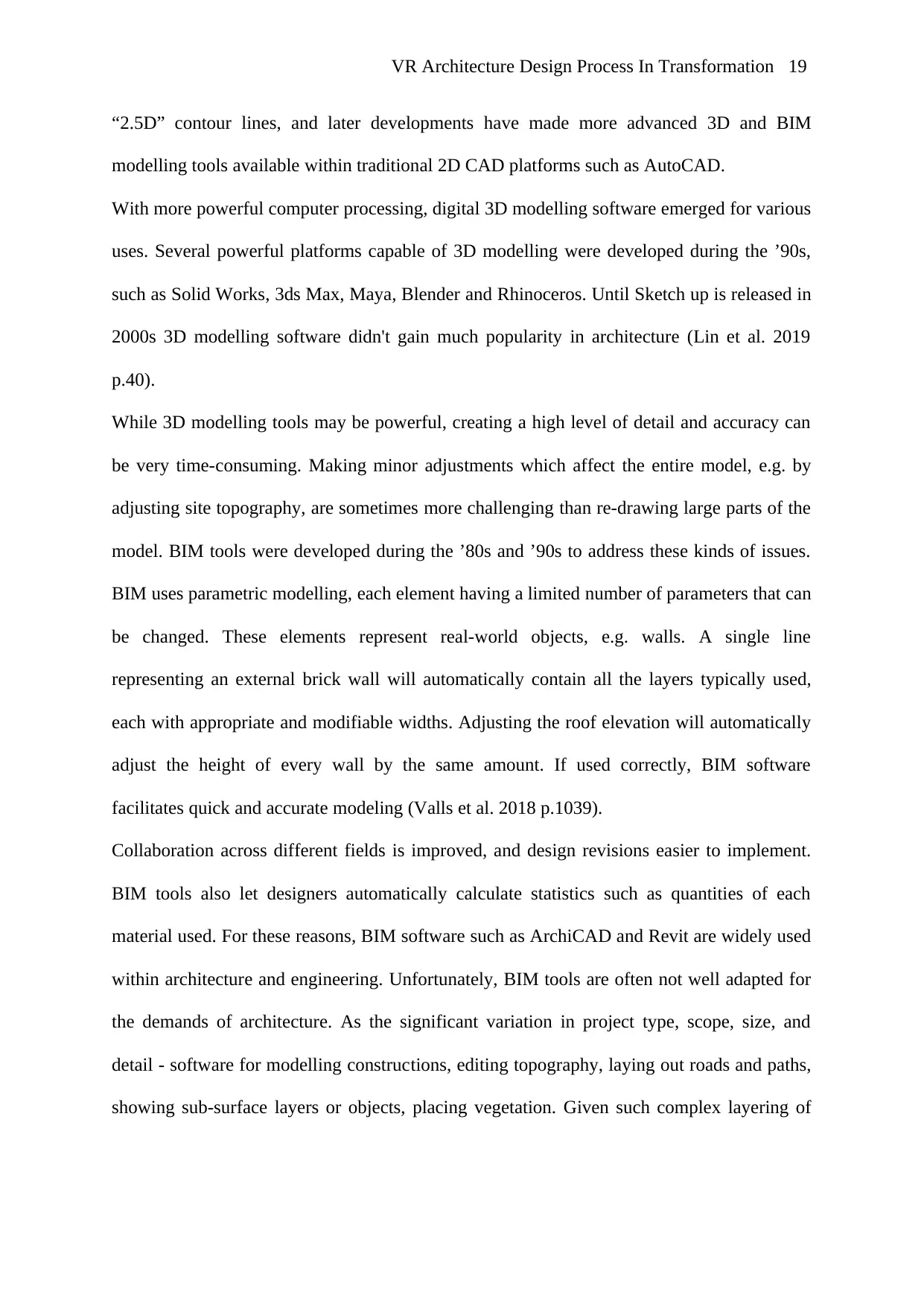
“2.5D” contour lines, and later developments have made more advanced 3D and BIM
modelling tools available within traditional 2D CAD platforms such as AutoCAD.
With more powerful computer processing, digital 3D modelling software emerged for various
uses. Several powerful platforms capable of 3D modelling were developed during the ’90s,
such as Solid Works, 3ds Max, Maya, Blender and Rhinoceros. Until Sketch up is released in
2000s 3D modelling software didn't gain much popularity in architecture (Lin et al. 2019
p.40).
While 3D modelling tools may be powerful, creating a high level of detail and accuracy can
be very time-consuming. Making minor adjustments which affect the entire model, e.g. by
adjusting site topography, are sometimes more challenging than re-drawing large parts of the
model. BIM tools were developed during the ’80s and ’90s to address these kinds of issues.
BIM uses parametric modelling, each element having a limited number of parameters that can
be changed. These elements represent real-world objects, e.g. walls. A single line
representing an external brick wall will automatically contain all the layers typically used,
each with appropriate and modifiable widths. Adjusting the roof elevation will automatically
adjust the height of every wall by the same amount. If used correctly, BIM software
facilitates quick and accurate modeling (Valls et al. 2018 p.1039).
Collaboration across different fields is improved, and design revisions easier to implement.
BIM tools also let designers automatically calculate statistics such as quantities of each
material used. For these reasons, BIM software such as ArchiCAD and Revit are widely used
within architecture and engineering. Unfortunately, BIM tools are often not well adapted for
the demands of architecture. As the significant variation in project type, scope, size, and
detail - software for modelling constructions, editing topography, laying out roads and paths,
showing sub-surface layers or objects, placing vegetation. Given such complex layering of
Paraphrase This Document
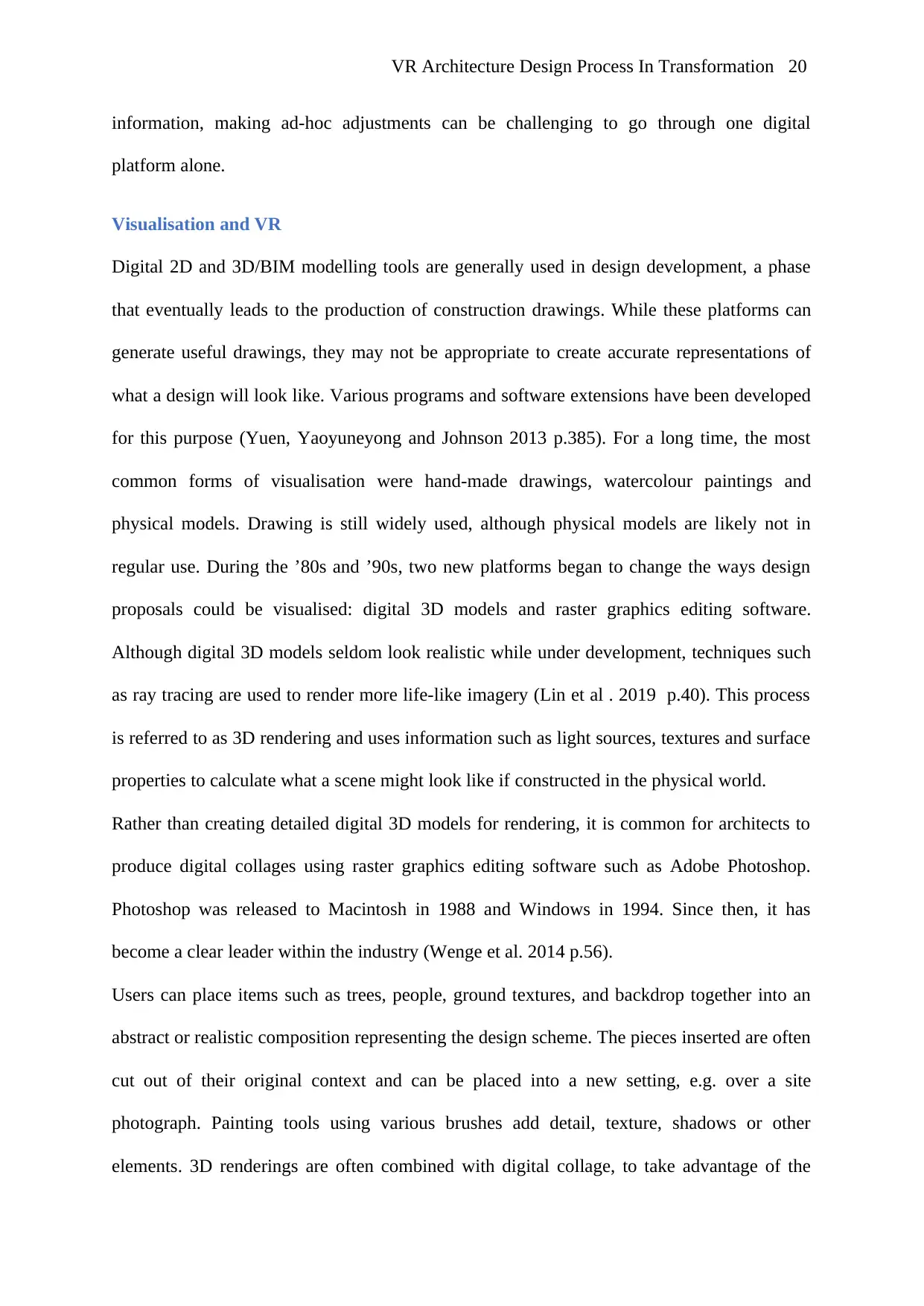
information, making ad-hoc adjustments can be challenging to go through one digital
platform alone.
Visualisation and VR
Digital 2D and 3D/BIM modelling tools are generally used in design development, a phase
that eventually leads to the production of construction drawings. While these platforms can
generate useful drawings, they may not be appropriate to create accurate representations of
what a design will look like. Various programs and software extensions have been developed
for this purpose (Yuen, Yaoyuneyong and Johnson 2013 p.385). For a long time, the most
common forms of visualisation were hand-made drawings, watercolour paintings and
physical models. Drawing is still widely used, although physical models are likely not in
regular use. During the ’80s and ’90s, two new platforms began to change the ways design
proposals could be visualised: digital 3D models and raster graphics editing software.
Although digital 3D models seldom look realistic while under development, techniques such
as ray tracing are used to render more life-like imagery (Lin et al . 2019 p.40). This process
is referred to as 3D rendering and uses information such as light sources, textures and surface
properties to calculate what a scene might look like if constructed in the physical world.
Rather than creating detailed digital 3D models for rendering, it is common for architects to
produce digital collages using raster graphics editing software such as Adobe Photoshop.
Photoshop was released to Macintosh in 1988 and Windows in 1994. Since then, it has
become a clear leader within the industry (Wenge et al. 2014 p.56).
Users can place items such as trees, people, ground textures, and backdrop together into an
abstract or realistic composition representing the design scheme. The pieces inserted are often
cut out of their original context and can be placed into a new setting, e.g. over a site
photograph. Painting tools using various brushes add detail, texture, shadows or other
elements. 3D renderings are often combined with digital collage, to take advantage of the
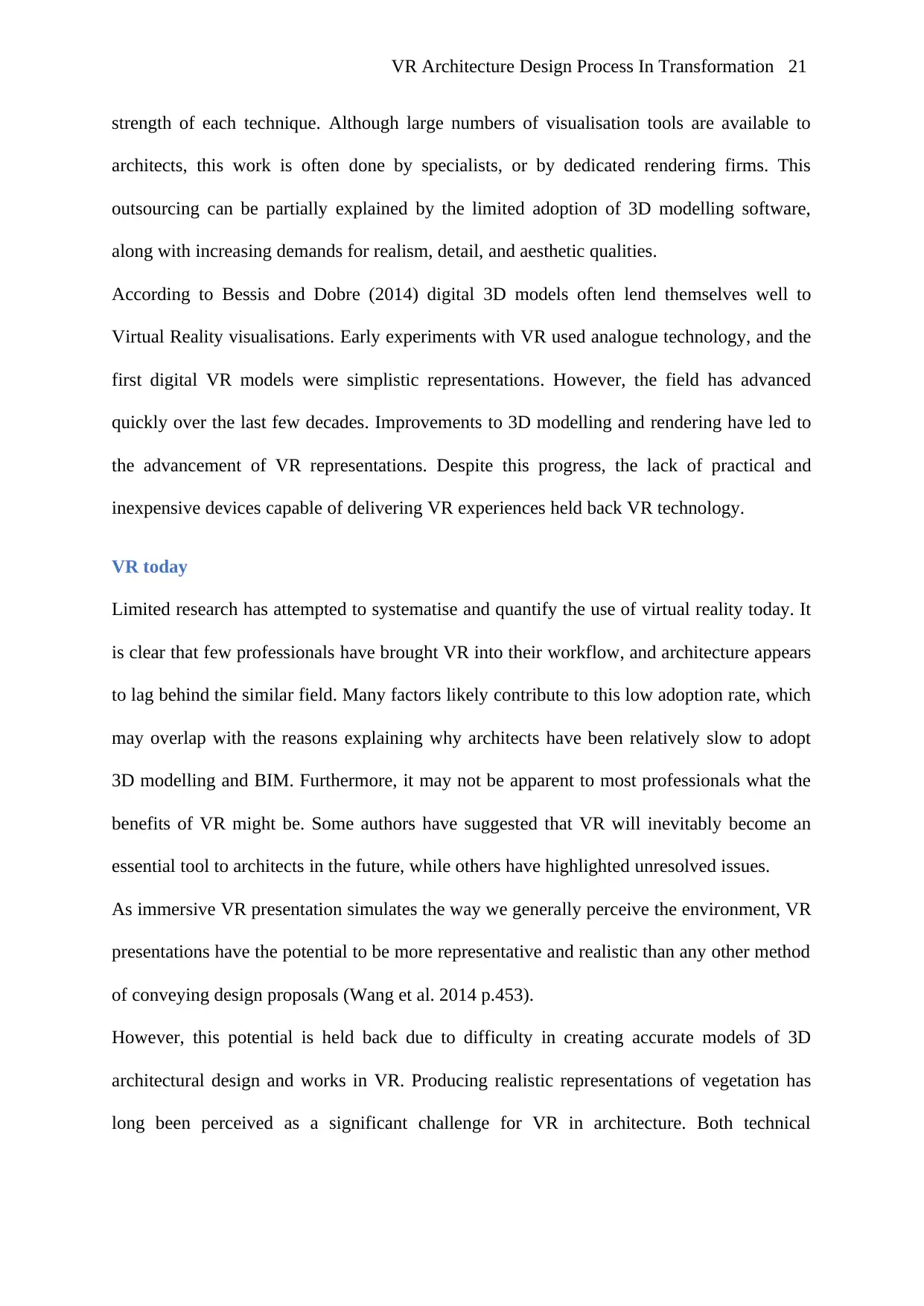
strength of each technique. Although large numbers of visualisation tools are available to
architects, this work is often done by specialists, or by dedicated rendering firms. This
outsourcing can be partially explained by the limited adoption of 3D modelling software,
along with increasing demands for realism, detail, and aesthetic qualities.
According to Bessis and Dobre (2014) digital 3D models often lend themselves well to
Virtual Reality visualisations. Early experiments with VR used analogue technology, and the
first digital VR models were simplistic representations. However, the field has advanced
quickly over the last few decades. Improvements to 3D modelling and rendering have led to
the advancement of VR representations. Despite this progress, the lack of practical and
inexpensive devices capable of delivering VR experiences held back VR technology.
VR today
Limited research has attempted to systematise and quantify the use of virtual reality today. It
is clear that few professionals have brought VR into their workflow, and architecture appears
to lag behind the similar field. Many factors likely contribute to this low adoption rate, which
may overlap with the reasons explaining why architects have been relatively slow to adopt
3D modelling and BIM. Furthermore, it may not be apparent to most professionals what the
benefits of VR might be. Some authors have suggested that VR will inevitably become an
essential tool to architects in the future, while others have highlighted unresolved issues.
As immersive VR presentation simulates the way we generally perceive the environment, VR
presentations have the potential to be more representative and realistic than any other method
of conveying design proposals (Wang et al. 2014 p.453).
However, this potential is held back due to difficulty in creating accurate models of 3D
architectural design and works in VR. Producing realistic representations of vegetation has
long been perceived as a significant challenge for VR in architecture. Both technical
⊘ This is a preview!⊘
Do you want full access?
Subscribe today to unlock all pages.

Trusted by 1+ million students worldwide
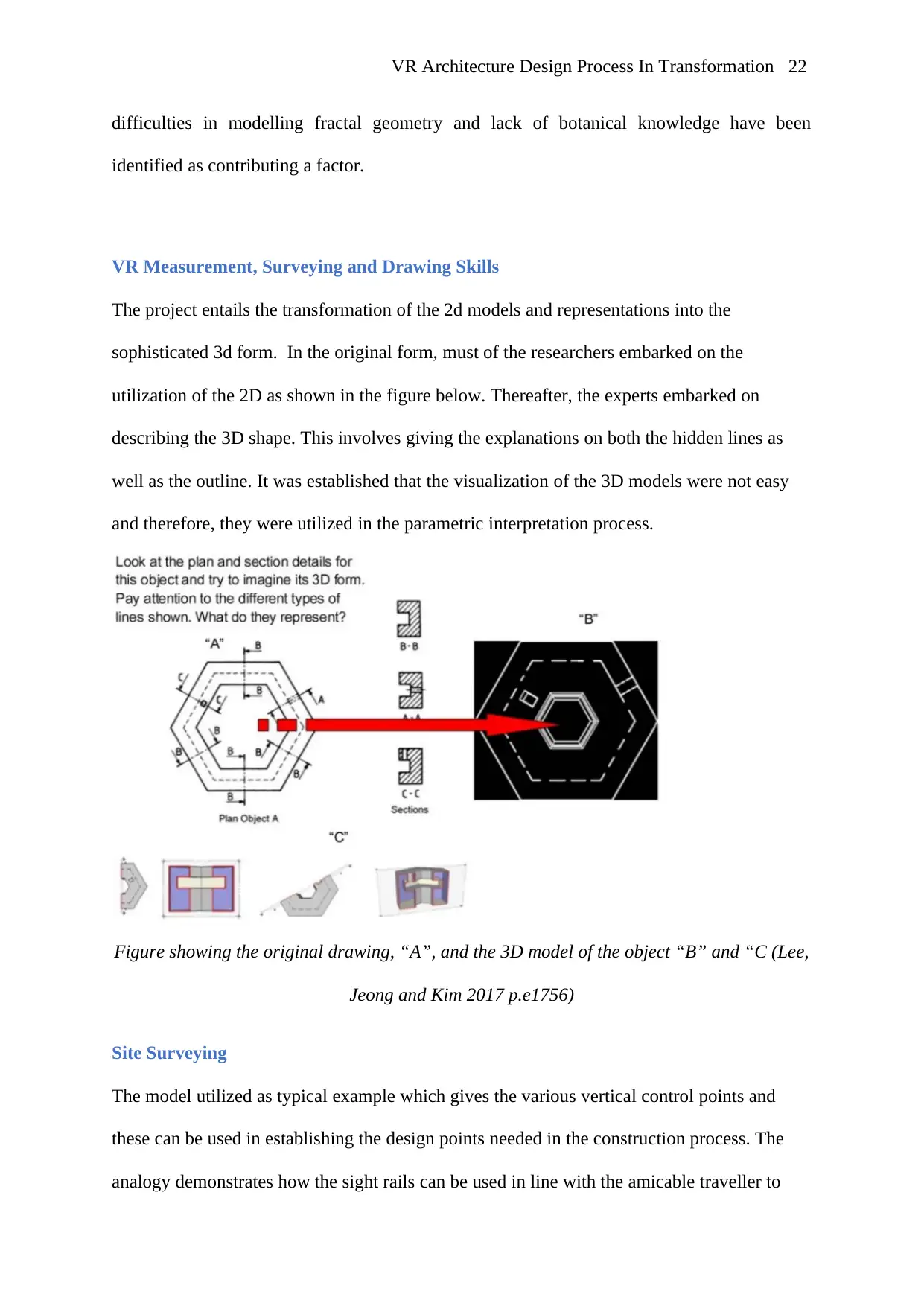
difficulties in modelling fractal geometry and lack of botanical knowledge have been
identified as contributing a factor.
VR Measurement, Surveying and Drawing Skills
The project entails the transformation of the 2d models and representations into the
sophisticated 3d form. In the original form, must of the researchers embarked on the
utilization of the 2D as shown in the figure below. Thereafter, the experts embarked on
describing the 3D shape. This involves giving the explanations on both the hidden lines as
well as the outline. It was established that the visualization of the 3D models were not easy
and therefore, they were utilized in the parametric interpretation process.
Figure showing the original drawing, “A”, and the 3D model of the object “B” and “C (Lee,
Jeong and Kim 2017 p.e1756)
Site Surveying
The model utilized as typical example which gives the various vertical control points and
these can be used in establishing the design points needed in the construction process. The
analogy demonstrates how the sight rails can be used in line with the amicable traveller to
Paraphrase This Document
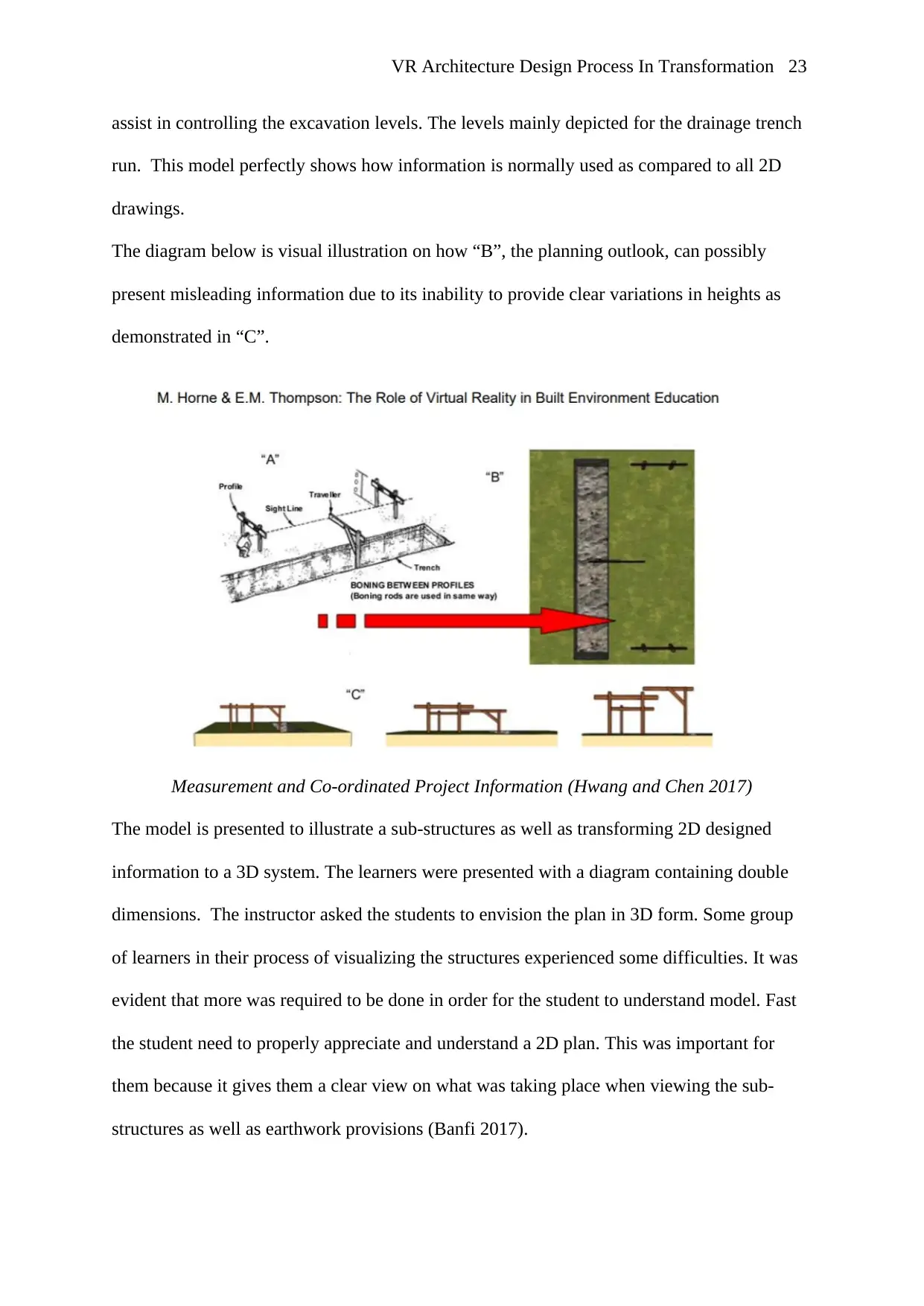
assist in controlling the excavation levels. The levels mainly depicted for the drainage trench
run. This model perfectly shows how information is normally used as compared to all 2D
drawings.
The diagram below is visual illustration on how “B”, the planning outlook, can possibly
present misleading information due to its inability to provide clear variations in heights as
demonstrated in “C”.
Measurement and Co-ordinated Project Information (Hwang and Chen 2017)
The model is presented to illustrate a sub-structures as well as transforming 2D designed
information to a 3D system. The learners were presented with a diagram containing double
dimensions. The instructor asked the students to envision the plan in 3D form. Some group
of learners in their process of visualizing the structures experienced some difficulties. It was
evident that more was required to be done in order for the student to understand model. Fast
the student need to properly appreciate and understand a 2D plan. This was important for
them because it gives them a clear view on what was taking place when viewing the sub-
structures as well as earthwork provisions (Banfi 2017).
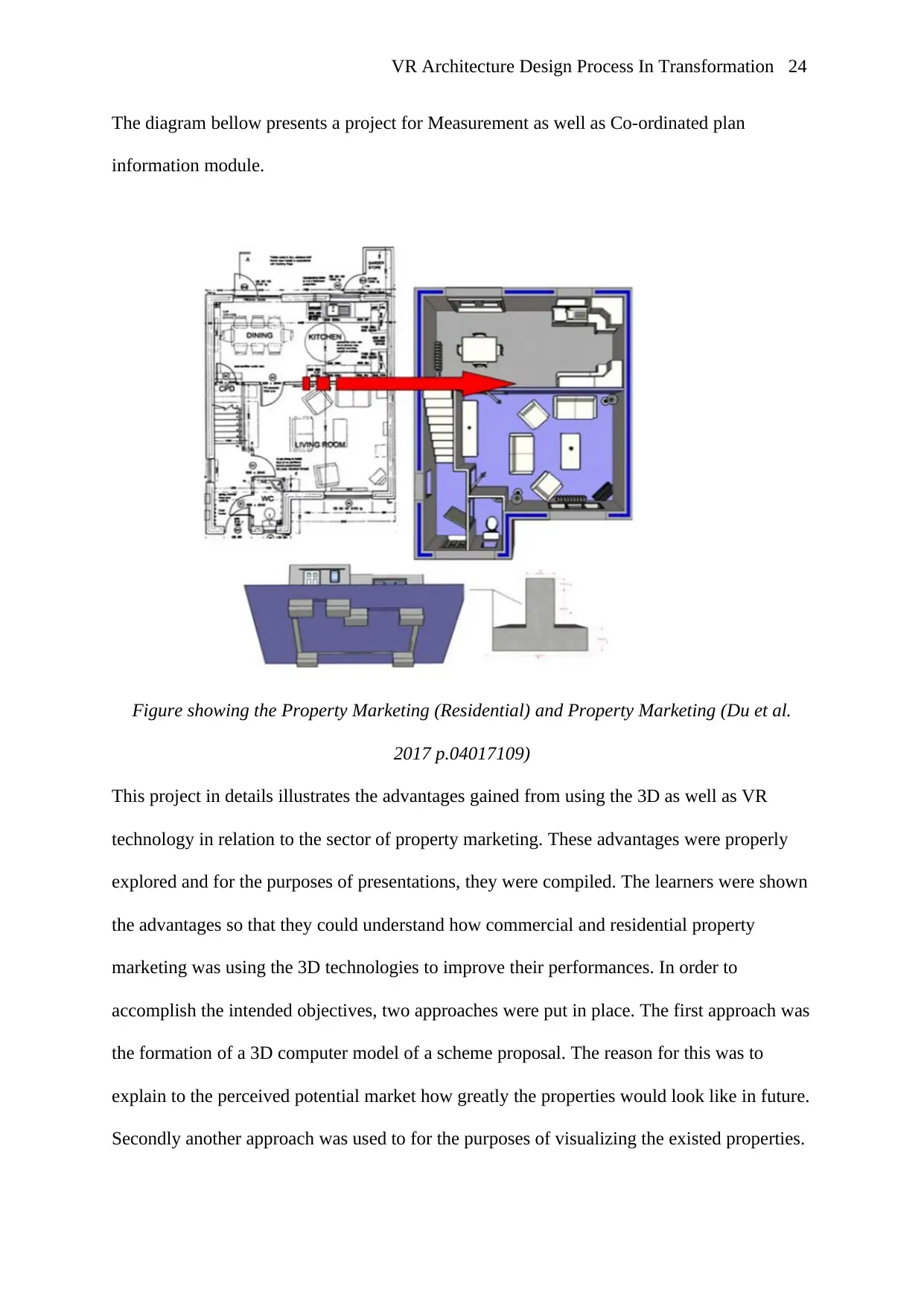
The diagram bellow presents a project for Measurement as well as Co-ordinated plan
information module.
Figure showing the Property Marketing (Residential) and Property Marketing (Du et al.
2017 p.04017109)
This project in details illustrates the advantages gained from using the 3D as well as VR
technology in relation to the sector of property marketing. These advantages were properly
explored and for the purposes of presentations, they were compiled. The learners were shown
the advantages so that they could understand how commercial and residential property
marketing was using the 3D technologies to improve their performances. In order to
accomplish the intended objectives, two approaches were put in place. The first approach was
the formation of a 3D computer model of a scheme proposal. The reason for this was to
explain to the perceived potential market how greatly the properties would look like in future.
Secondly another approach was used to for the purposes of visualizing the existed properties.
⊘ This is a preview!⊘
Do you want full access?
Subscribe today to unlock all pages.

Trusted by 1+ million students worldwide

Under this, the construction of Quick time VR models were manufactured using digitally
stitching bringing together more than one digital images.
Figure showing an example of a project for property marketing both for Residential and
Commercial property marketing modules (Arora et al. 2017 p. 5643)
Architectural Technology Design Project
The students of Architectural Technology in their final year normally have a special tusk of
resolving both the technical as well as designing matters for the purposes of ensuring finest
building and efficiency performances. Through this project, the learners are equipped with
the necessary knowledge about the VR, theoretically and in practical. In addition to this, the
project presents an opportunity for the students to extensively interact with the designing in a
manner that had never been possible before this project (Lin et al. 2019 p.40). Learners
inculcate behavior within their model and through this they are able to explore both the
Paraphrase This Document
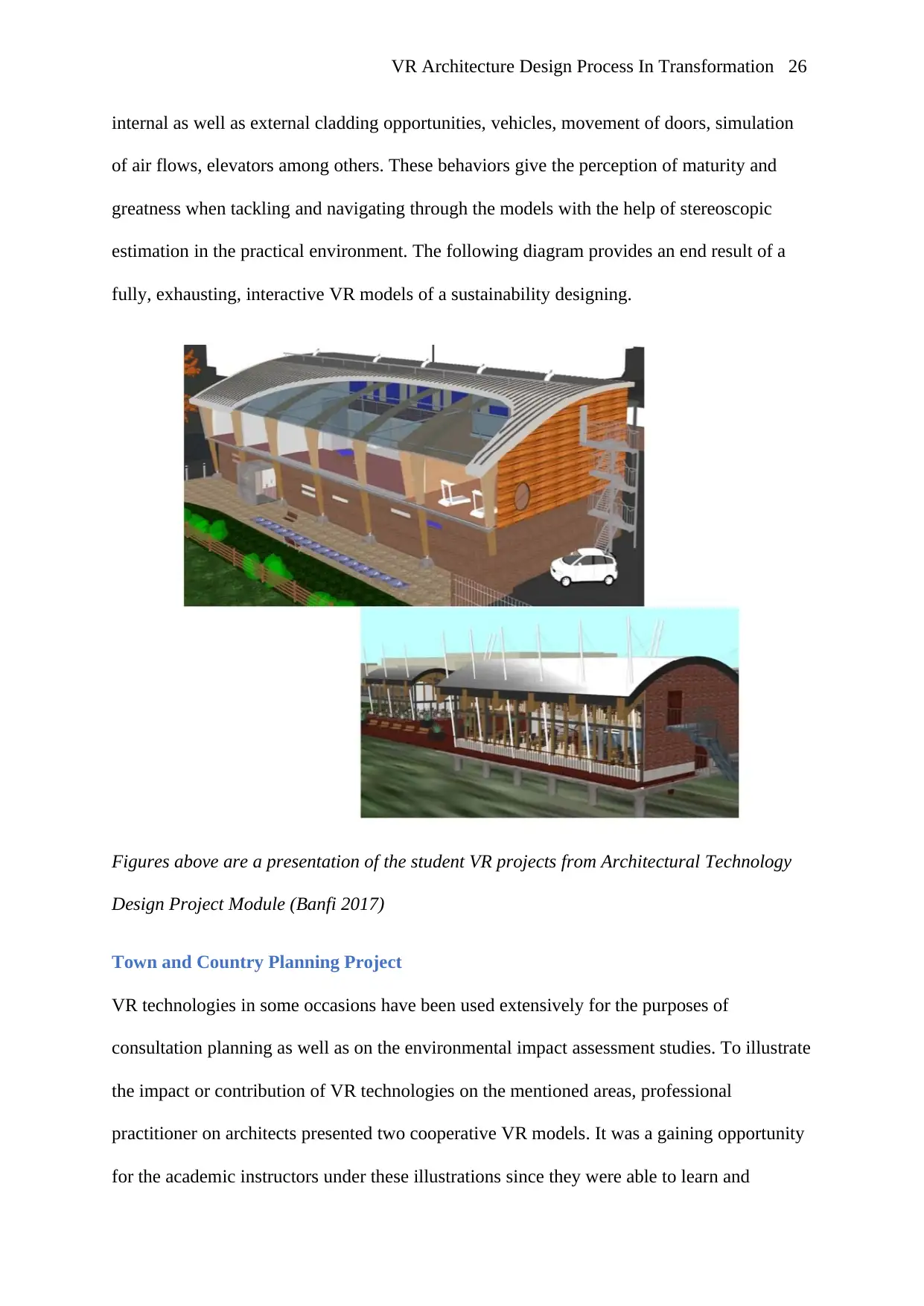
internal as well as external cladding opportunities, vehicles, movement of doors, simulation
of air flows, elevators among others. These behaviors give the perception of maturity and
greatness when tackling and navigating through the models with the help of stereoscopic
estimation in the practical environment. The following diagram provides an end result of a
fully, exhausting, interactive VR models of a sustainability designing.
Figures above are a presentation of the student VR projects from Architectural Technology
Design Project Module (Banfi 2017)
Town and Country Planning Project
VR technologies in some occasions have been used extensively for the purposes of
consultation planning as well as on the environmental impact assessment studies. To illustrate
the impact or contribution of VR technologies on the mentioned areas, professional
practitioner on architects presented two cooperative VR models. It was a gaining opportunity
for the academic instructors under these illustrations since they were able to learn and
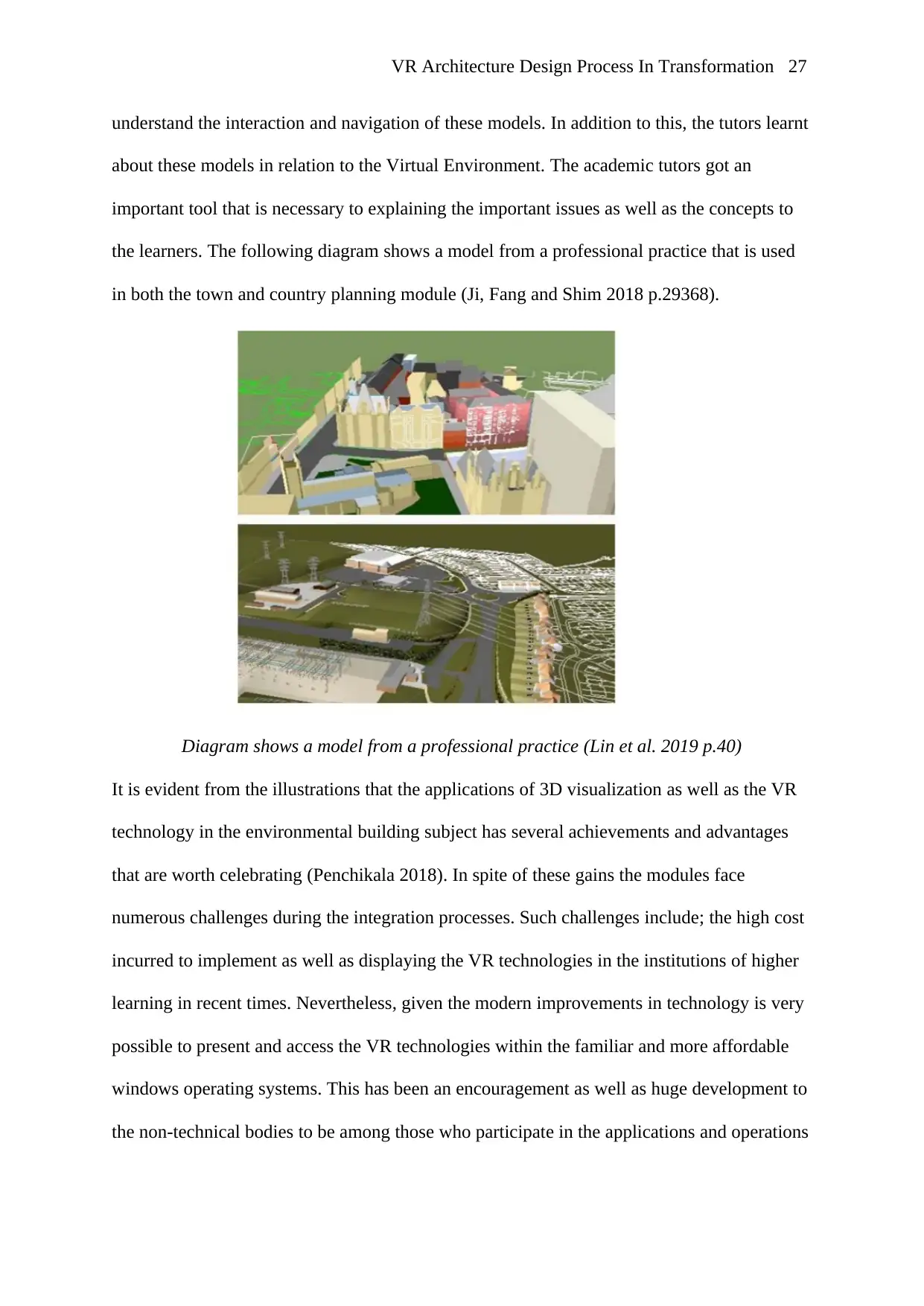
understand the interaction and navigation of these models. In addition to this, the tutors learnt
about these models in relation to the Virtual Environment. The academic tutors got an
important tool that is necessary to explaining the important issues as well as the concepts to
the learners. The following diagram shows a model from a professional practice that is used
in both the town and country planning module (Ji, Fang and Shim 2018 p.29368).
Diagram shows a model from a professional practice (Lin et al. 2019 p.40)
It is evident from the illustrations that the applications of 3D visualization as well as the VR
technology in the environmental building subject has several achievements and advantages
that are worth celebrating (Penchikala 2018). In spite of these gains the modules face
numerous challenges during the integration processes. Such challenges include; the high cost
incurred to implement as well as displaying the VR technologies in the institutions of higher
learning in recent times. Nevertheless, given the modern improvements in technology is very
possible to present and access the VR technologies within the familiar and more affordable
windows operating systems. This has been an encouragement as well as huge development to
the non-technical bodies to be among those who participate in the applications and operations
⊘ This is a preview!⊘
Do you want full access?
Subscribe today to unlock all pages.

Trusted by 1+ million students worldwide

of these projects. Secondly, the software selections as well as its up-date have also been a
challenge to much integration under visualization technology.
Although there are clear advantages in using 3D visualisation and VR technology in built
environment subjects, there are also several challenges in the integration process. Until
recently one of the major disincentives of implementing VR technology in higher education
was the cost of display equipment and computers. However, with recent technological
developments, it is now possible to base VR systems on familiar and affordable Windows
operating systems. This encourages non-technical staff to become involved and to consider
potential applications. Software selection and up-date is also a challenge for any integration
of visualisation technology. It is necessary to select the most appropriate software at the right
time, and to keep it up-to-date with the ever advancing technology. Extensive research should
be done before introducing any software, and good technical support is an essential part of
this process. Another major challenge is introducing change to a wider group where existing
working practices may need to be modified. A structured and consistent approach can
demonstrate the advantages of any new technologies. It is necessary to educate tutors in this
technology; this is increasingly difficult when time is limited because of existing
commitments (Rehring, Hoffmann and Ahlemann 2018).
VR Appliaction on the Built Envirnment for the Architects
The world is changing fast with the improvement in the technology taking a center stage
across the disciplines. Ecological system too has recorded tremendous changes in the face of
this new era. And for this reason, there is compelling need for the profession of architecture
to improve and fit in the multidisciplinary cooperation. It is these changes that have led to the
modern trajectory in the field of designing and planning as well (Lin et al. 2019 p.40). The
universal trends such as rapid development of cities and urban sprawl are calling for well
planning and designing that is capable of datasets integration together with ecological,
Paraphrase This Document
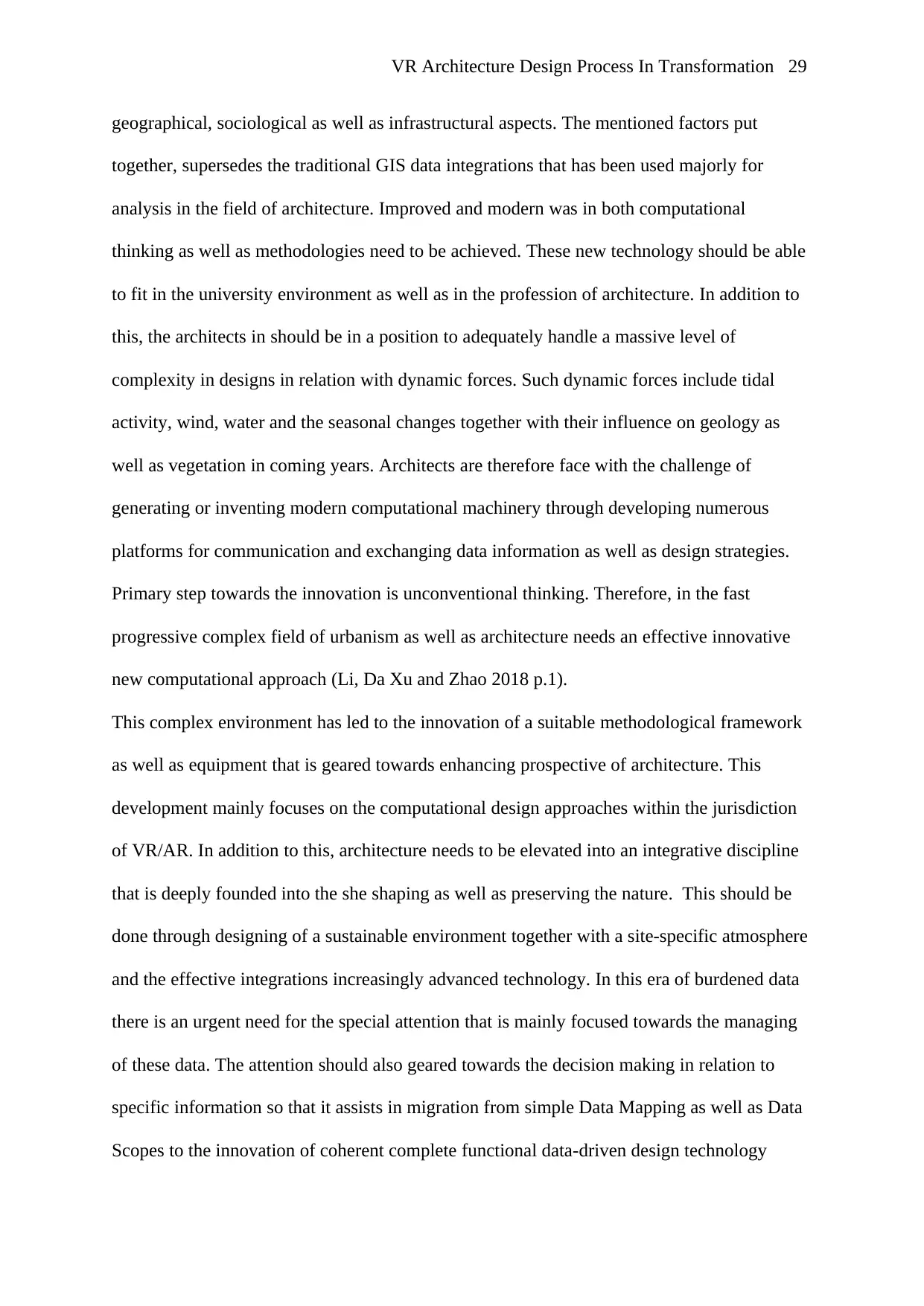
geographical, sociological as well as infrastructural aspects. The mentioned factors put
together, supersedes the traditional GIS data integrations that has been used majorly for
analysis in the field of architecture. Improved and modern was in both computational
thinking as well as methodologies need to be achieved. These new technology should be able
to fit in the university environment as well as in the profession of architecture. In addition to
this, the architects in should be in a position to adequately handle a massive level of
complexity in designs in relation with dynamic forces. Such dynamic forces include tidal
activity, wind, water and the seasonal changes together with their influence on geology as
well as vegetation in coming years. Architects are therefore face with the challenge of
generating or inventing modern computational machinery through developing numerous
platforms for communication and exchanging data information as well as design strategies.
Primary step towards the innovation is unconventional thinking. Therefore, in the fast
progressive complex field of urbanism as well as architecture needs an effective innovative
new computational approach (Li, Da Xu and Zhao 2018 p.1).
This complex environment has led to the innovation of a suitable methodological framework
as well as equipment that is geared towards enhancing prospective of architecture. This
development mainly focuses on the computational design approaches within the jurisdiction
of VR/AR. In addition to this, architecture needs to be elevated into an integrative discipline
that is deeply founded into the she shaping as well as preserving the nature. This should be
done through designing of a sustainable environment together with a site-specific atmosphere
and the effective integrations increasingly advanced technology. In this era of burdened data
there is an urgent need for the special attention that is mainly focused towards the managing
of these data. The attention should also geared towards the decision making in relation to
specific information so that it assists in migration from simple Data Mapping as well as Data
Scopes to the innovation of coherent complete functional data-driven design technology
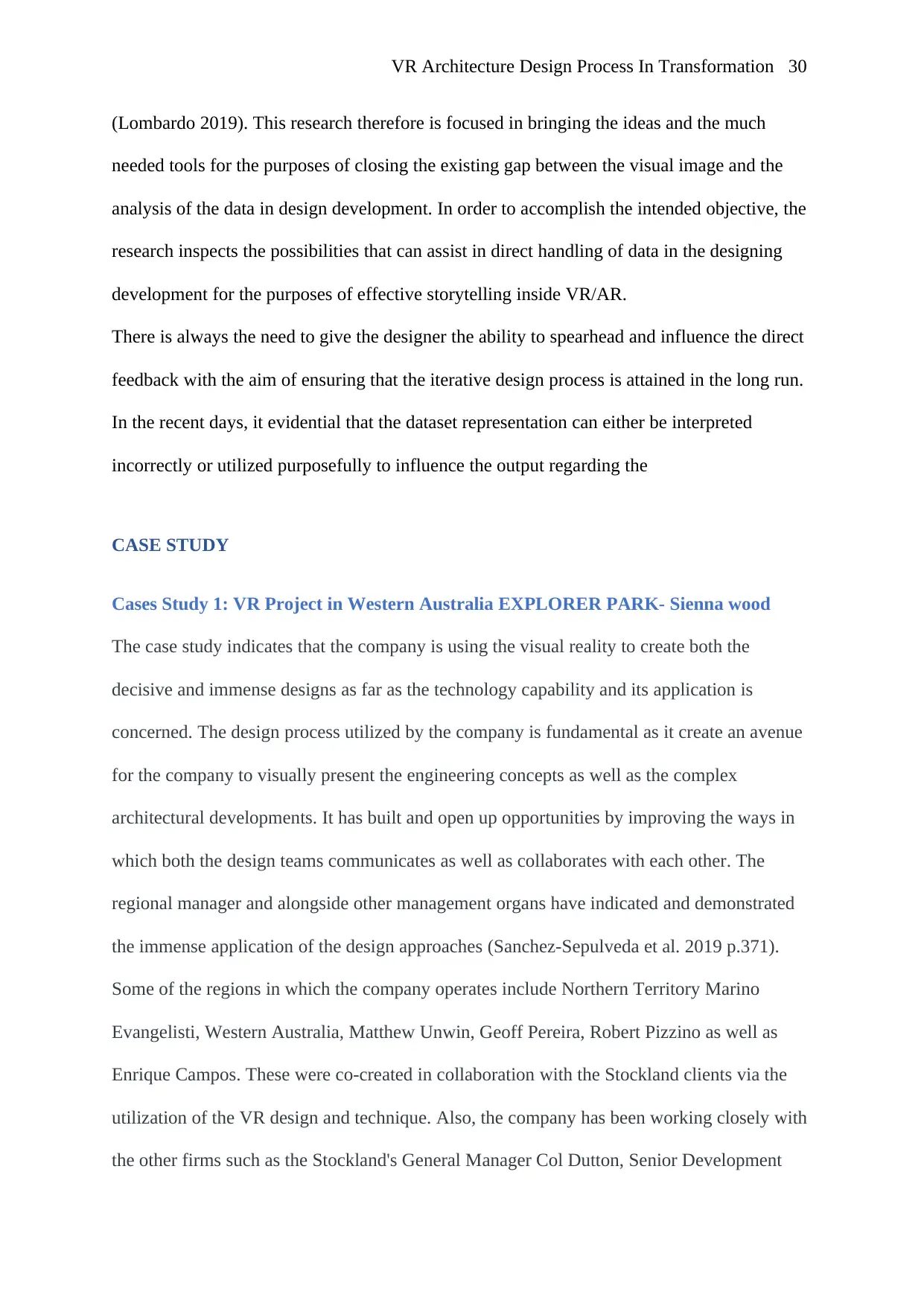
(Lombardo 2019). This research therefore is focused in bringing the ideas and the much
needed tools for the purposes of closing the existing gap between the visual image and the
analysis of the data in design development. In order to accomplish the intended objective, the
research inspects the possibilities that can assist in direct handling of data in the designing
development for the purposes of effective storytelling inside VR/AR.
There is always the need to give the designer the ability to spearhead and influence the direct
feedback with the aim of ensuring that the iterative design process is attained in the long run.
In the recent days, it evidential that the dataset representation can either be interpreted
incorrectly or utilized purposefully to influence the output regarding the
CASE STUDY
Cases Study 1: VR Project in Western Australia EXPLORER PARK- Sienna wood
The case study indicates that the company is using the visual reality to create both the
decisive and immense designs as far as the technology capability and its application is
concerned. The design process utilized by the company is fundamental as it create an avenue
for the company to visually present the engineering concepts as well as the complex
architectural developments. It has built and open up opportunities by improving the ways in
which both the design teams communicates as well as collaborates with each other. The
regional manager and alongside other management organs have indicated and demonstrated
the immense application of the design approaches (Sanchez-Sepulveda et al. 2019 p.371).
Some of the regions in which the company operates include Northern Territory Marino
Evangelisti, Western Australia, Matthew Unwin, Geoff Pereira, Robert Pizzino as well as
Enrique Campos. These were co-created in collaboration with the Stockland clients via the
utilization of the VR design and technique. Also, the company has been working closely with
the other firms such as the Stockland's General Manager Col Dutton, Senior Development
⊘ This is a preview!⊘
Do you want full access?
Subscribe today to unlock all pages.

Trusted by 1+ million students worldwide
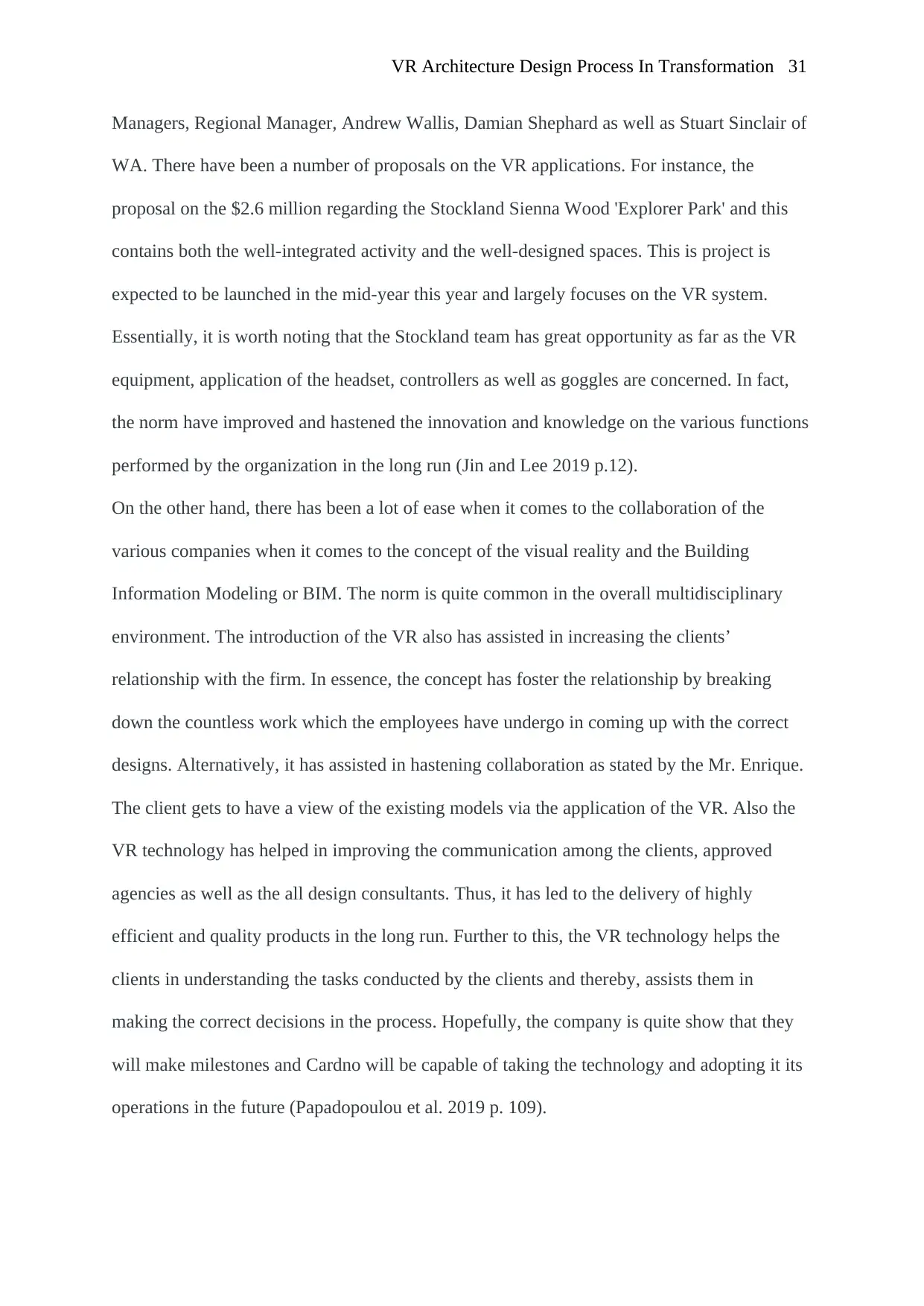
Managers, Regional Manager, Andrew Wallis, Damian Shephard as well as Stuart Sinclair of
WA. There have been a number of proposals on the VR applications. For instance, the
proposal on the $2.6 million regarding the Stockland Sienna Wood 'Explorer Park' and this
contains both the well-integrated activity and the well-designed spaces. This is project is
expected to be launched in the mid-year this year and largely focuses on the VR system.
Essentially, it is worth noting that the Stockland team has great opportunity as far as the VR
equipment, application of the headset, controllers as well as goggles are concerned. In fact,
the norm have improved and hastened the innovation and knowledge on the various functions
performed by the organization in the long run (Jin and Lee 2019 p.12).
On the other hand, there has been a lot of ease when it comes to the collaboration of the
various companies when it comes to the concept of the visual reality and the Building
Information Modeling or BIM. The norm is quite common in the overall multidisciplinary
environment. The introduction of the VR also has assisted in increasing the clients’
relationship with the firm. In essence, the concept has foster the relationship by breaking
down the countless work which the employees have undergo in coming up with the correct
designs. Alternatively, it has assisted in hastening collaboration as stated by the Mr. Enrique.
The client gets to have a view of the existing models via the application of the VR. Also the
VR technology has helped in improving the communication among the clients, approved
agencies as well as the all design consultants. Thus, it has led to the delivery of highly
efficient and quality products in the long run. Further to this, the VR technology helps the
clients in understanding the tasks conducted by the clients and thereby, assists them in
making the correct decisions in the process. Hopefully, the company is quite show that they
will make milestones and Cardno will be capable of taking the technology and adopting it its
operations in the future (Papadopoulou et al. 2019 p. 109).
Paraphrase This Document
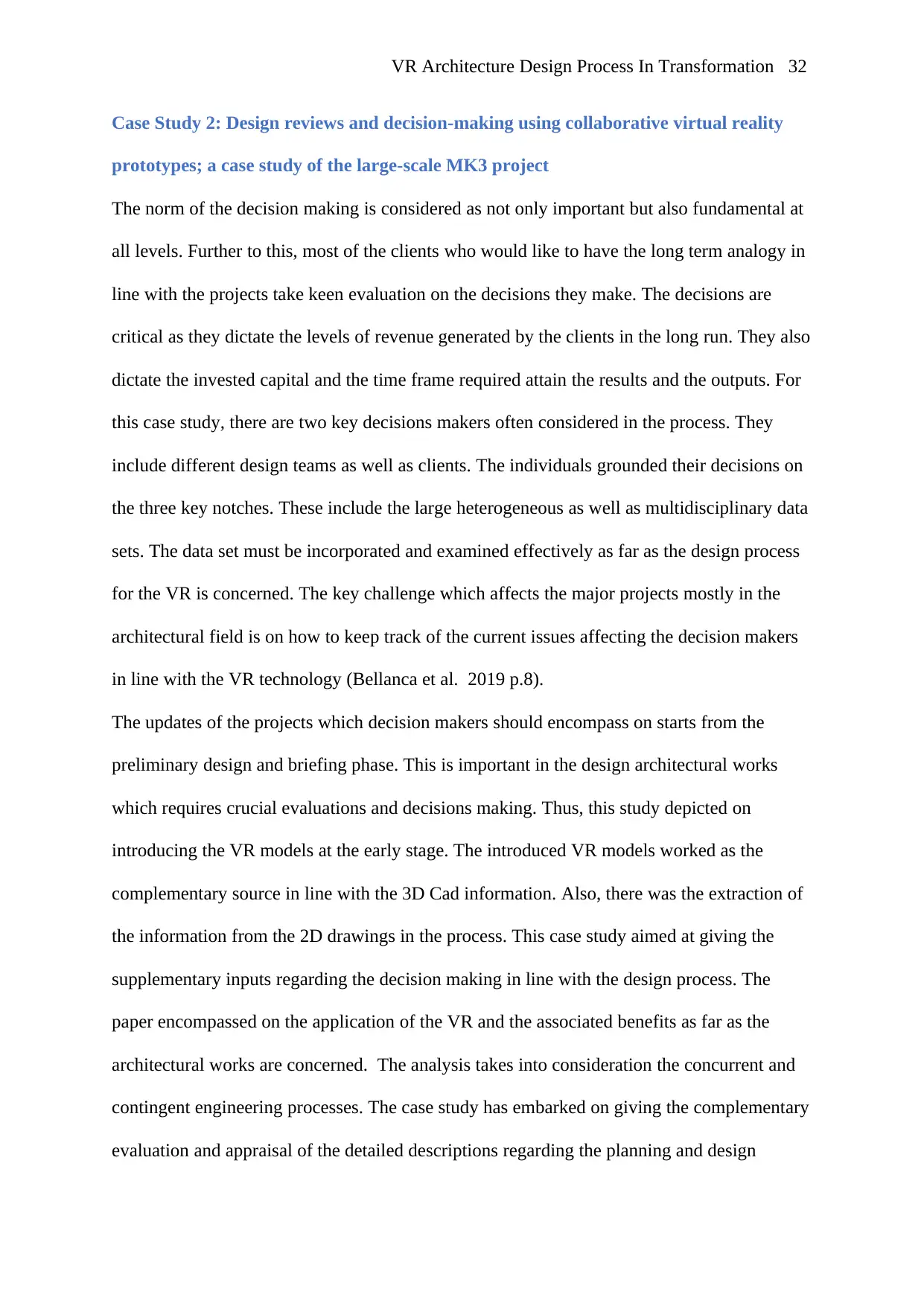
Case Study 2: Design reviews and decision-making using collaborative virtual reality
prototypes; a case study of the large-scale MK3 project
The norm of the decision making is considered as not only important but also fundamental at
all levels. Further to this, most of the clients who would like to have the long term analogy in
line with the projects take keen evaluation on the decisions they make. The decisions are
critical as they dictate the levels of revenue generated by the clients in the long run. They also
dictate the invested capital and the time frame required attain the results and the outputs. For
this case study, there are two key decisions makers often considered in the process. They
include different design teams as well as clients. The individuals grounded their decisions on
the three key notches. These include the large heterogeneous as well as multidisciplinary data
sets. The data set must be incorporated and examined effectively as far as the design process
for the VR is concerned. The key challenge which affects the major projects mostly in the
architectural field is on how to keep track of the current issues affecting the decision makers
in line with the VR technology (Bellanca et al. 2019 p.8).
The updates of the projects which decision makers should encompass on starts from the
preliminary design and briefing phase. This is important in the design architectural works
which requires crucial evaluations and decisions making. Thus, this study depicted on
introducing the VR models at the early stage. The introduced VR models worked as the
complementary source in line with the 3D Cad information. Also, there was the extraction of
the information from the 2D drawings in the process. This case study aimed at giving the
supplementary inputs regarding the decision making in line with the design process. The
paper encompassed on the application of the VR and the associated benefits as far as the
architectural works are concerned. The analysis takes into consideration the concurrent and
contingent engineering processes. The case study has embarked on giving the complementary
evaluation and appraisal of the detailed descriptions regarding the planning and design
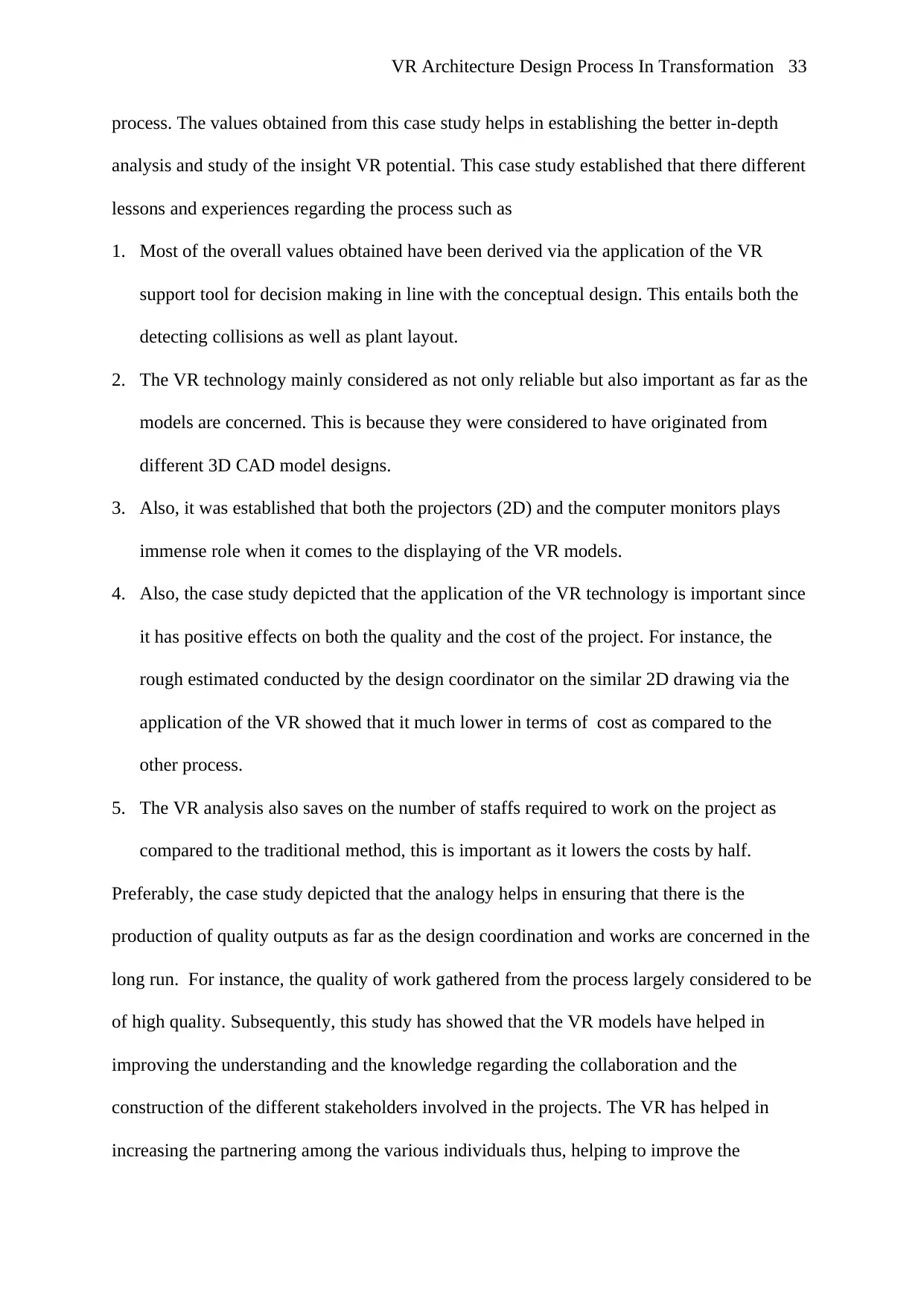
process. The values obtained from this case study helps in establishing the better in-depth
analysis and study of the insight VR potential. This case study established that there different
lessons and experiences regarding the process such as
1. Most of the overall values obtained have been derived via the application of the VR
support tool for decision making in line with the conceptual design. This entails both the
detecting collisions as well as plant layout.
2. The VR technology mainly considered as not only reliable but also important as far as the
models are concerned. This is because they were considered to have originated from
different 3D CAD model designs.
3. Also, it was established that both the projectors (2D) and the computer monitors plays
immense role when it comes to the displaying of the VR models.
4. Also, the case study depicted that the application of the VR technology is important since
it has positive effects on both the quality and the cost of the project. For instance, the
rough estimated conducted by the design coordinator on the similar 2D drawing via the
application of the VR showed that it much lower in terms of cost as compared to the
other process.
5. The VR analysis also saves on the number of staffs required to work on the project as
compared to the traditional method, this is important as it lowers the costs by half.
Preferably, the case study depicted that the analogy helps in ensuring that there is the
production of quality outputs as far as the design coordination and works are concerned in the
long run. For instance, the quality of work gathered from the process largely considered to be
of high quality. Subsequently, this study has showed that the VR models have helped in
improving the understanding and the knowledge regarding the collaboration and the
construction of the different stakeholders involved in the projects. The VR has helped in
increasing the partnering among the various individuals thus, helping to improve the
⊘ This is a preview!⊘
Do you want full access?
Subscribe today to unlock all pages.

Trusted by 1+ million students worldwide
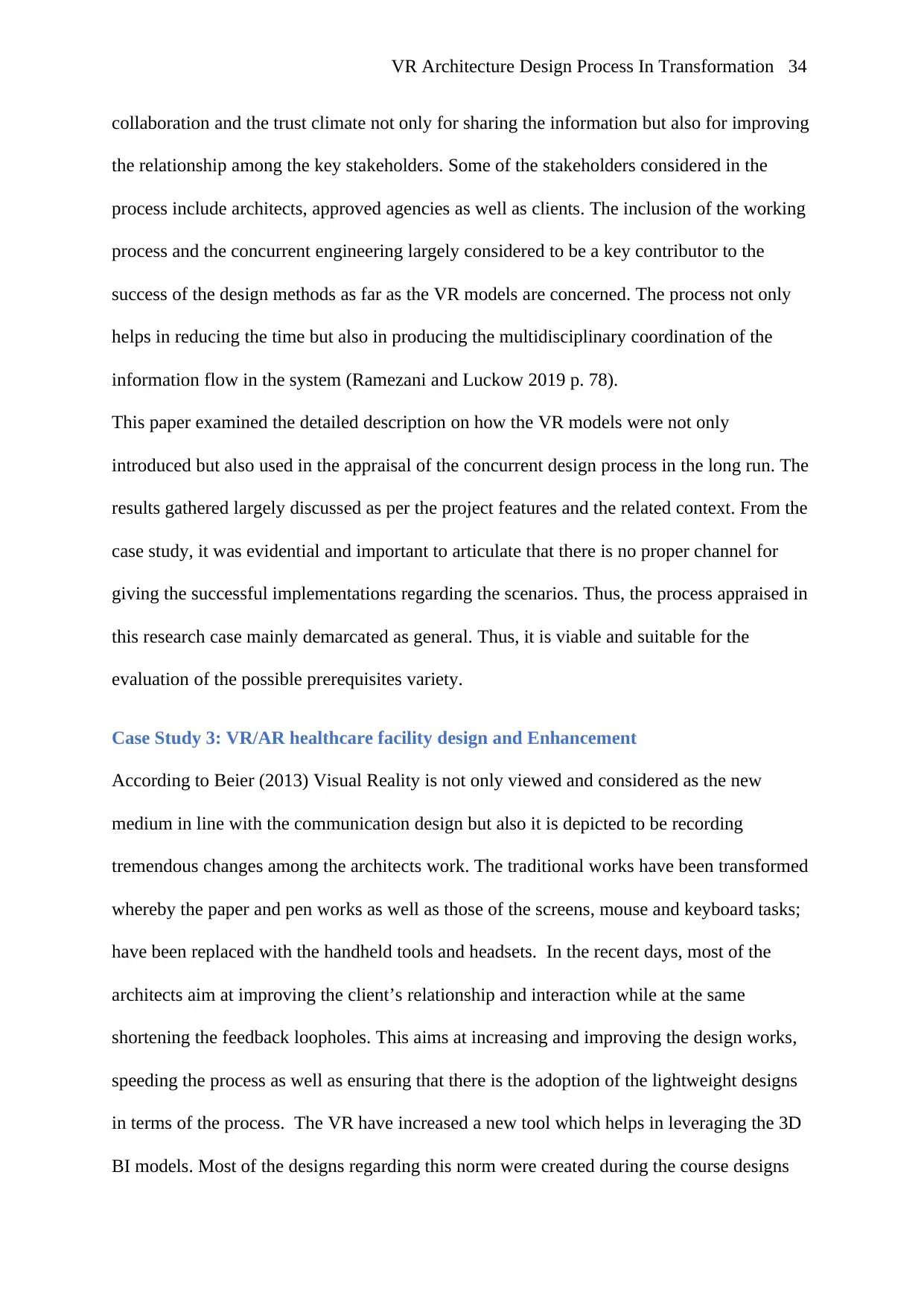
collaboration and the trust climate not only for sharing the information but also for improving
the relationship among the key stakeholders. Some of the stakeholders considered in the
process include architects, approved agencies as well as clients. The inclusion of the working
process and the concurrent engineering largely considered to be a key contributor to the
success of the design methods as far as the VR models are concerned. The process not only
helps in reducing the time but also in producing the multidisciplinary coordination of the
information flow in the system (Ramezani and Luckow 2019 p. 78).
This paper examined the detailed description on how the VR models were not only
introduced but also used in the appraisal of the concurrent design process in the long run. The
results gathered largely discussed as per the project features and the related context. From the
case study, it was evidential and important to articulate that there is no proper channel for
giving the successful implementations regarding the scenarios. Thus, the process appraised in
this research case mainly demarcated as general. Thus, it is viable and suitable for the
evaluation of the possible prerequisites variety.
Case Study 3: VR/AR healthcare facility design and Enhancement
According to Beier (2013) Visual Reality is not only viewed and considered as the new
medium in line with the communication design but also it is depicted to be recording
tremendous changes among the architects work. The traditional works have been transformed
whereby the paper and pen works as well as those of the screens, mouse and keyboard tasks;
have been replaced with the handheld tools and headsets. In the recent days, most of the
architects aim at improving the client’s relationship and interaction while at the same
shortening the feedback loopholes. This aims at increasing and improving the design works,
speeding the process as well as ensuring that there is the adoption of the lightweight designs
in terms of the process. The VR have increased a new tool which helps in leveraging the 3D
BI models. Most of the designs regarding this norm were created during the course designs
Paraphrase This Document
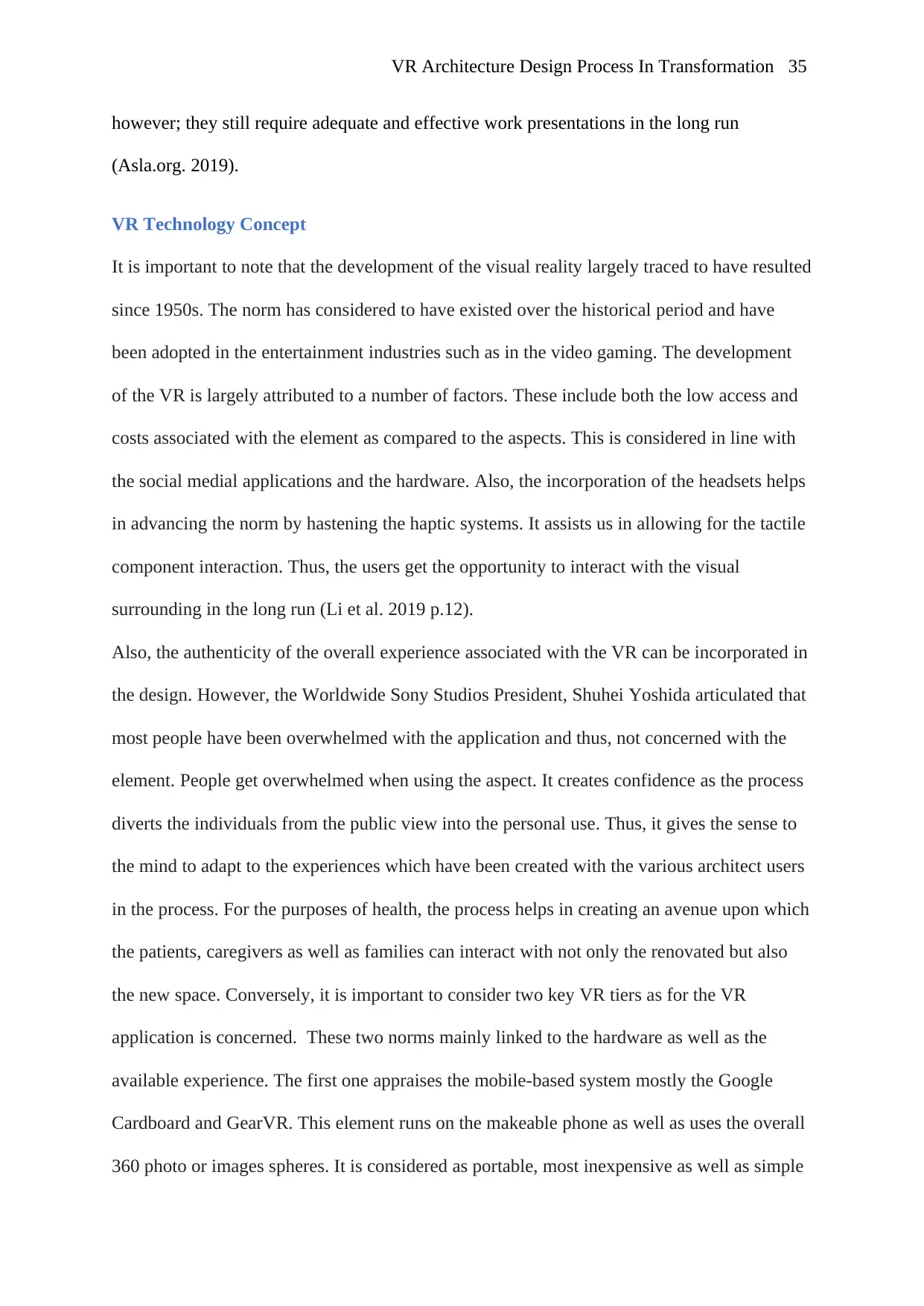
however; they still require adequate and effective work presentations in the long run
(Asla.org. 2019).
VR Technology Concept
It is important to note that the development of the visual reality largely traced to have resulted
since 1950s. The norm has considered to have existed over the historical period and have
been adopted in the entertainment industries such as in the video gaming. The development
of the VR is largely attributed to a number of factors. These include both the low access and
costs associated with the element as compared to the aspects. This is considered in line with
the social medial applications and the hardware. Also, the incorporation of the headsets helps
in advancing the norm by hastening the haptic systems. It assists us in allowing for the tactile
component interaction. Thus, the users get the opportunity to interact with the visual
surrounding in the long run (Li et al. 2019 p.12).
Also, the authenticity of the overall experience associated with the VR can be incorporated in
the design. However, the Worldwide Sony Studios President, Shuhei Yoshida articulated that
most people have been overwhelmed with the application and thus, not concerned with the
element. People get overwhelmed when using the aspect. It creates confidence as the process
diverts the individuals from the public view into the personal use. Thus, it gives the sense to
the mind to adapt to the experiences which have been created with the various architect users
in the process. For the purposes of health, the process helps in creating an avenue upon which
the patients, caregivers as well as families can interact with not only the renovated but also
the new space. Conversely, it is important to consider two key VR tiers as for the VR
application is concerned. These two norms mainly linked to the hardware as well as the
available experience. The first one appraises the mobile-based system mostly the Google
Cardboard and GearVR. This element runs on the makeable phone as well as uses the overall
360 photo or images spheres. It is considered as portable, most inexpensive as well as simple

solution. It thus, allows for the gathering of the quick feedback in line with the discrete areas
in the long run (Berg and Vance 2017 p.1).
On the other hand, tethered system, HTC Vive and think Oculus Rift is also considered as the
second element. This largely grounds on the connection of the computer with a viable and
powerful graphics card. Further to this, it can be used to track the motion around the
makeable room and thereby, facilitating the visual reality in space. Preferably, it worth
noting that the tethered systems often allows for the overall exploration as well as requires
both the hardware as well as setup bit in the long run.
Process and Application
There are various benefits which the use of the visual reality has in line with the health.
Essentially, one can note that the success reported as results of the visual reality designs in
line with the Health Architectures are immense and mainly discussed as follows
Virtual Design Reviews
The VR is largely conducted at the early design phase and thus, it creates an avenue for the
client team to visualize and give the feedbacks regarding the current design stage as far as the
proposal is concerned. Also, the use of the True-to-Scale VR models enables the designers
and the users to take a stroll over the room and test the various design parameters such as the
oft-used equipment. This helps in giving the feedbacks regarding the room layout in the long
run. The avenue creates an elusive win-win between the client and the architect. This is
because it lowers the reworks as well as the time required by the two parts to meet and
discuss the designs.
Marketing and Fund Raising
⊘ This is a preview!⊘
Do you want full access?
Subscribe today to unlock all pages.

Trusted by 1+ million students worldwide
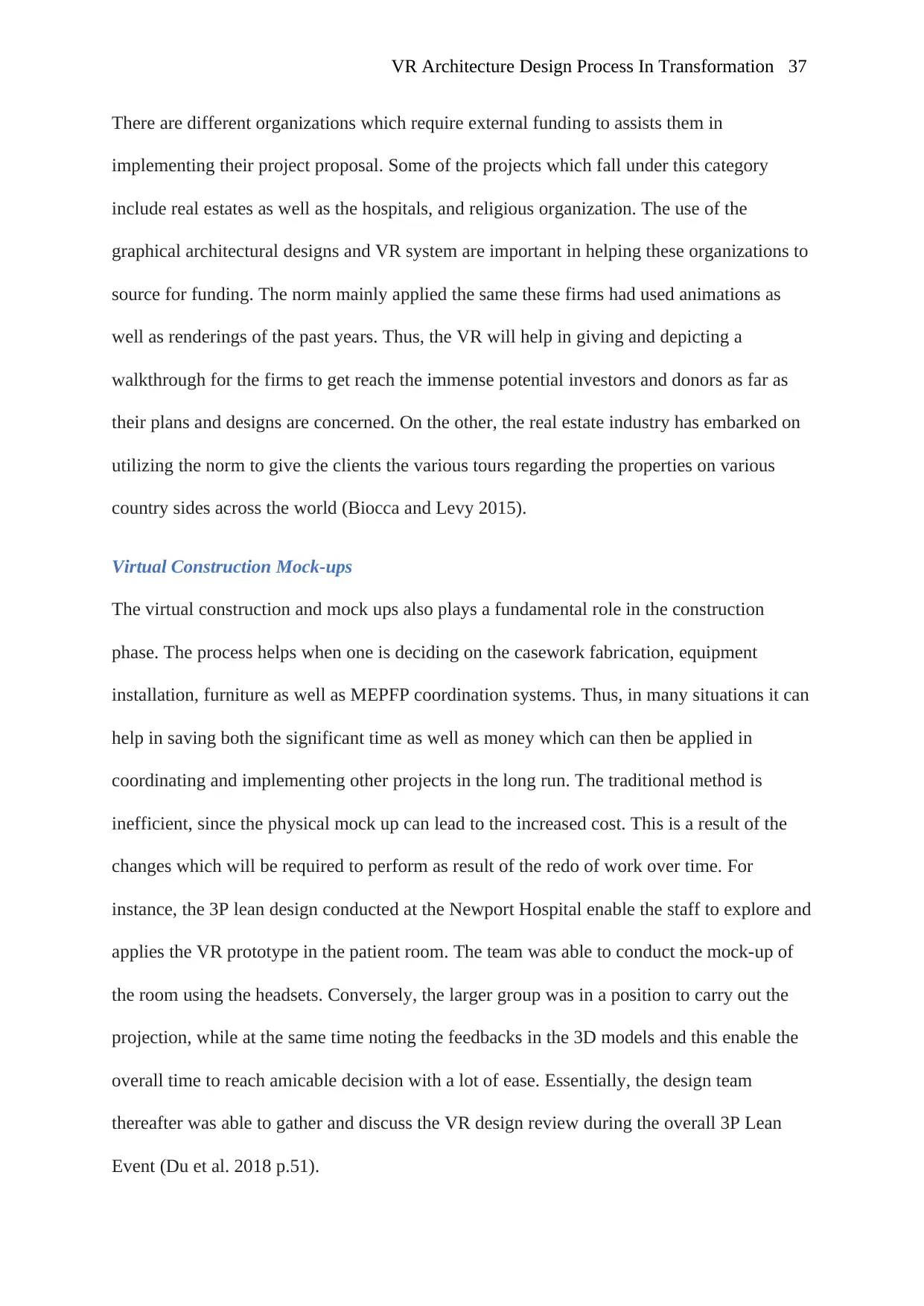
There are different organizations which require external funding to assists them in
implementing their project proposal. Some of the projects which fall under this category
include real estates as well as the hospitals, and religious organization. The use of the
graphical architectural designs and VR system are important in helping these organizations to
source for funding. The norm mainly applied the same these firms had used animations as
well as renderings of the past years. Thus, the VR will help in giving and depicting a
walkthrough for the firms to get reach the immense potential investors and donors as far as
their plans and designs are concerned. On the other, the real estate industry has embarked on
utilizing the norm to give the clients the various tours regarding the properties on various
country sides across the world (Biocca and Levy 2015).
Virtual Construction Mock-ups
The virtual construction and mock ups also plays a fundamental role in the construction
phase. The process helps when one is deciding on the casework fabrication, equipment
installation, furniture as well as MEPFP coordination systems. Thus, in many situations it can
help in saving both the significant time as well as money which can then be applied in
coordinating and implementing other projects in the long run. The traditional method is
inefficient, since the physical mock up can lead to the increased cost. This is a result of the
changes which will be required to perform as result of the redo of work over time. For
instance, the 3P lean design conducted at the Newport Hospital enable the staff to explore and
applies the VR prototype in the patient room. The team was able to conduct the mock-up of
the room using the headsets. Conversely, the larger group was in a position to carry out the
projection, while at the same time noting the feedbacks in the 3D models and this enable the
overall time to reach amicable decision with a lot of ease. Essentially, the design team
thereafter was able to gather and discuss the VR design review during the overall 3P Lean
Event (Du et al. 2018 p.51).
Paraphrase This Document
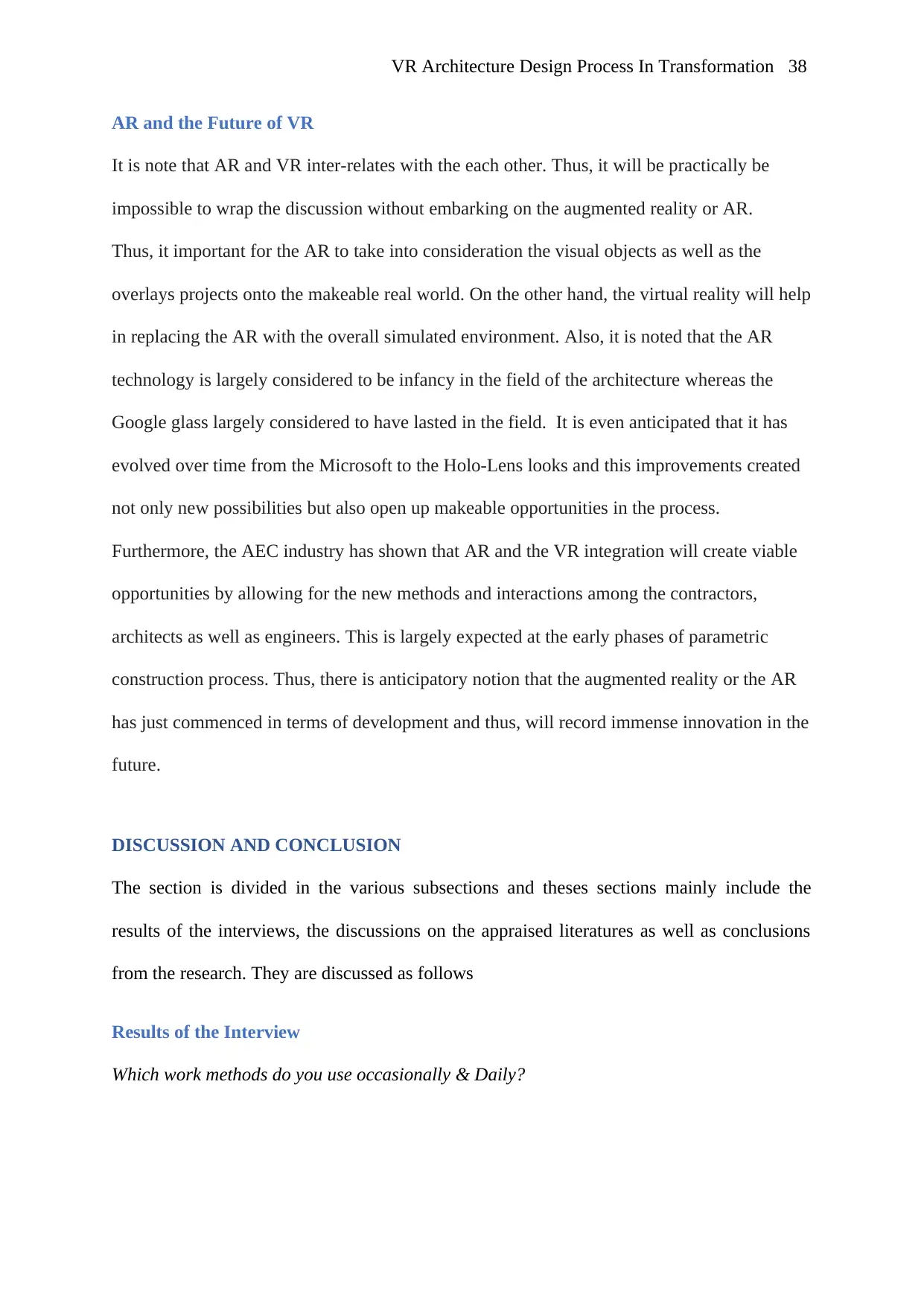
AR and the Future of VR
It is note that AR and VR inter-relates with the each other. Thus, it will be practically be
impossible to wrap the discussion without embarking on the augmented reality or AR.
Thus, it important for the AR to take into consideration the visual objects as well as the
overlays projects onto the makeable real world. On the other hand, the virtual reality will help
in replacing the AR with the overall simulated environment. Also, it is noted that the AR
technology is largely considered to be infancy in the field of the architecture whereas the
Google glass largely considered to have lasted in the field. It is even anticipated that it has
evolved over time from the Microsoft to the Holo-Lens looks and this improvements created
not only new possibilities but also open up makeable opportunities in the process.
Furthermore, the AEC industry has shown that AR and the VR integration will create viable
opportunities by allowing for the new methods and interactions among the contractors,
architects as well as engineers. This is largely expected at the early phases of parametric
construction process. Thus, there is anticipatory notion that the augmented reality or the AR
has just commenced in terms of development and thus, will record immense innovation in the
future.
DISCUSSION AND CONCLUSION
The section is divided in the various subsections and theses sections mainly include the
results of the interviews, the discussions on the appraised literatures as well as conclusions
from the research. They are discussed as follows
Results of the Interview
Which work methods do you use occasionally & Daily?
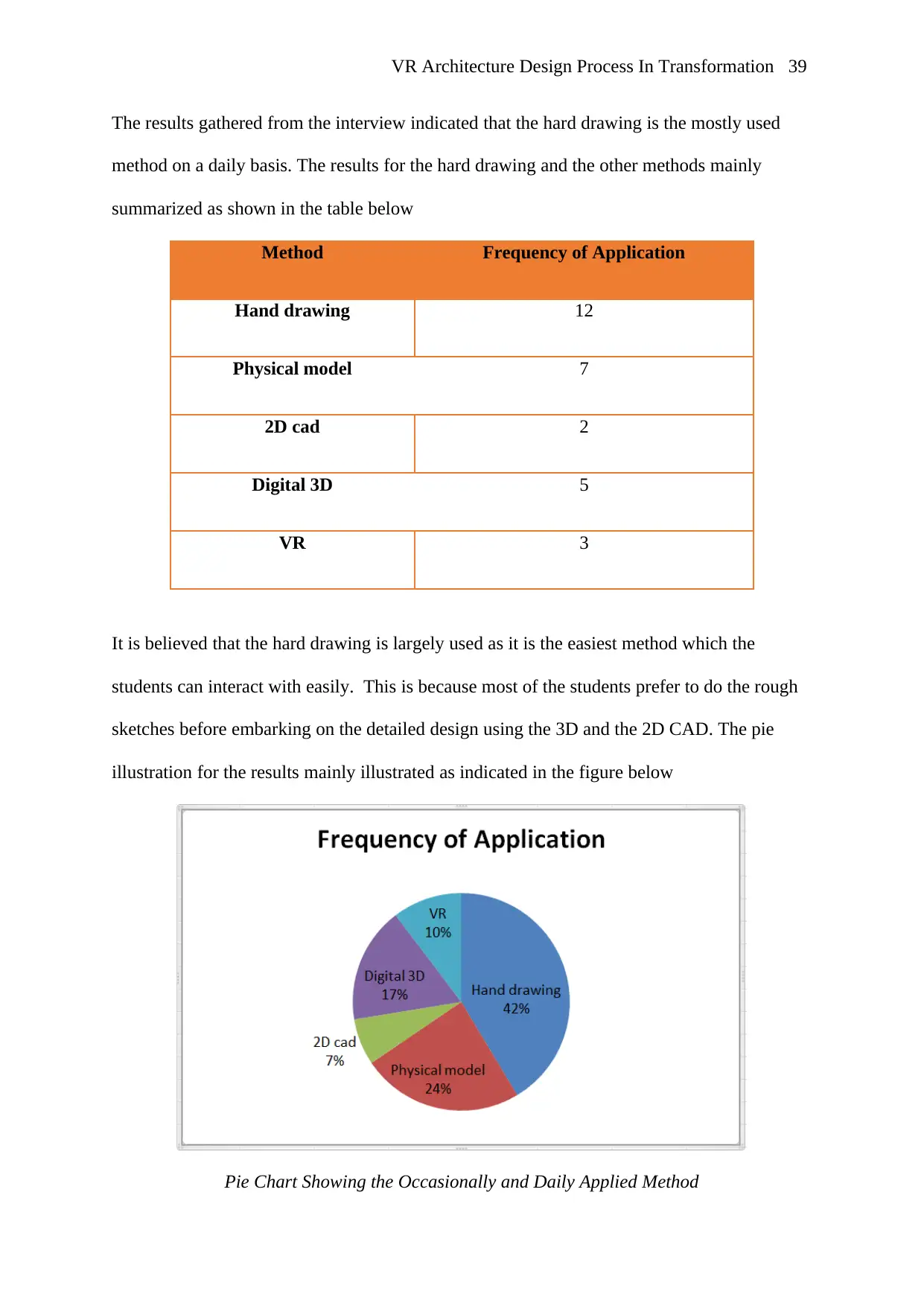
The results gathered from the interview indicated that the hard drawing is the mostly used
method on a daily basis. The results for the hard drawing and the other methods mainly
summarized as shown in the table below
Method Frequency of Application
Hand drawing 12
Physical model 7
2D cad 2
Digital 3D 5
VR 3
It is believed that the hard drawing is largely used as it is the easiest method which the
students can interact with easily. This is because most of the students prefer to do the rough
sketches before embarking on the detailed design using the 3D and the 2D CAD. The pie
illustration for the results mainly illustrated as indicated in the figure below
Pie Chart Showing the Occasionally and Daily Applied Method
⊘ This is a preview!⊘
Do you want full access?
Subscribe today to unlock all pages.

Trusted by 1+ million students worldwide
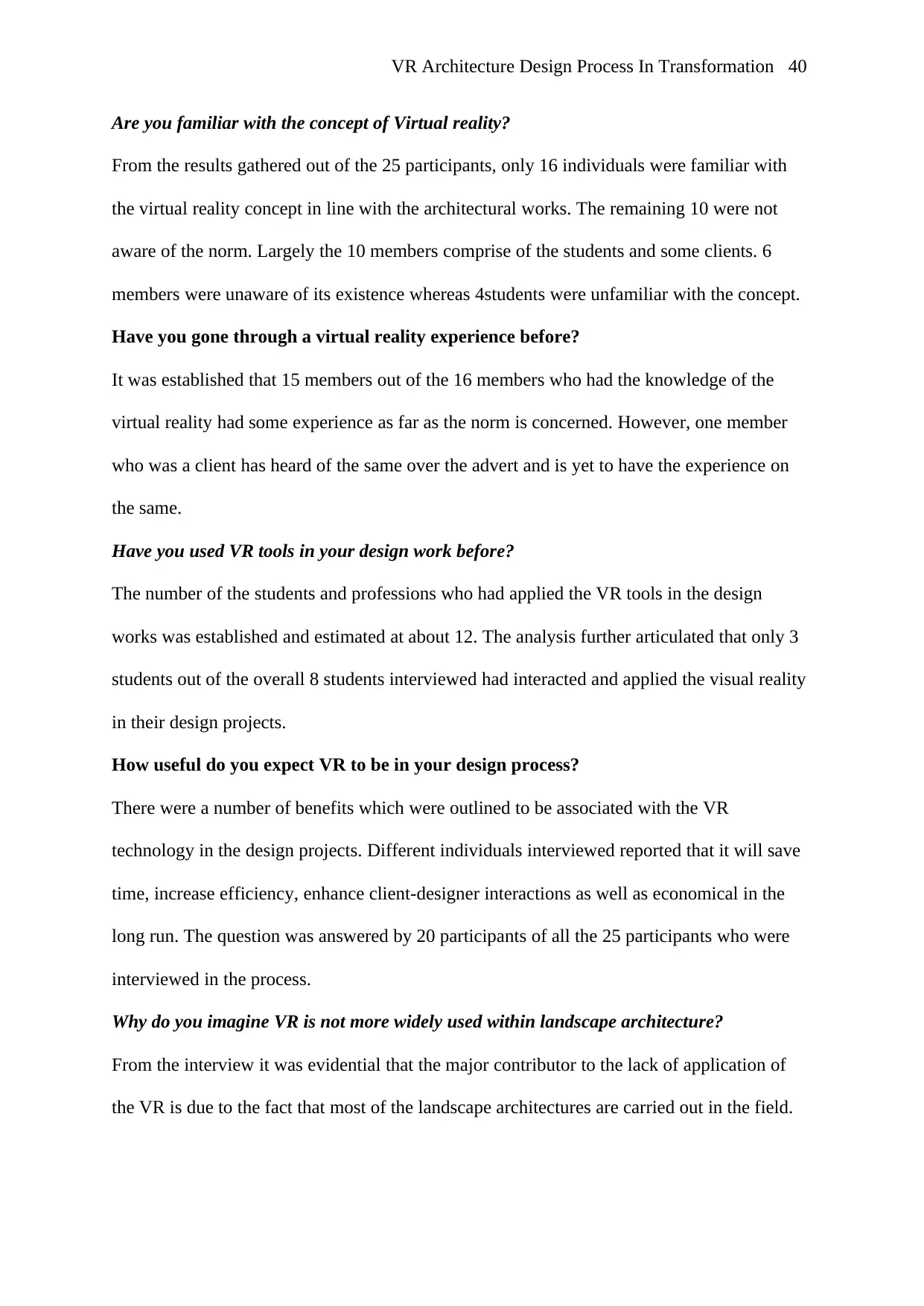
Are you familiar with the concept of Virtual reality?
From the results gathered out of the 25 participants, only 16 individuals were familiar with
the virtual reality concept in line with the architectural works. The remaining 10 were not
aware of the norm. Largely the 10 members comprise of the students and some clients. 6
members were unaware of its existence whereas 4students were unfamiliar with the concept.
Have you gone through a virtual reality experience before?
It was established that 15 members out of the 16 members who had the knowledge of the
virtual reality had some experience as far as the norm is concerned. However, one member
who was a client has heard of the same over the advert and is yet to have the experience on
the same.
Have you used VR tools in your design work before?
The number of the students and professions who had applied the VR tools in the design
works was established and estimated at about 12. The analysis further articulated that only 3
students out of the overall 8 students interviewed had interacted and applied the visual reality
in their design projects.
How useful do you expect VR to be in your design process?
There were a number of benefits which were outlined to be associated with the VR
technology in the design projects. Different individuals interviewed reported that it will save
time, increase efficiency, enhance client-designer interactions as well as economical in the
long run. The question was answered by 20 participants of all the 25 participants who were
interviewed in the process.
Why do you imagine VR is not more widely used within landscape architecture?
From the interview it was evidential that the major contributor to the lack of application of
the VR is due to the fact that most of the landscape architectures are carried out in the field.
Paraphrase This Document
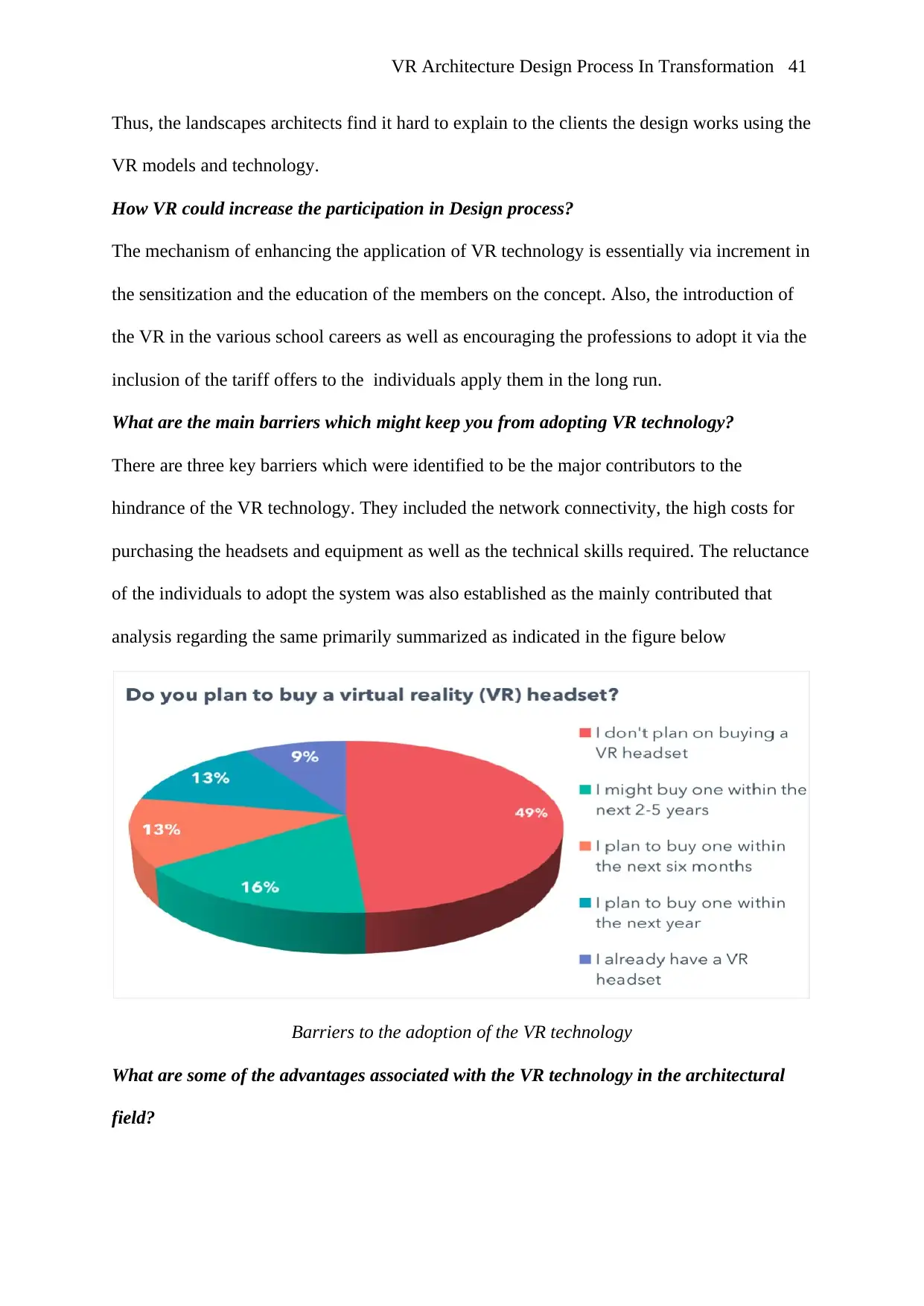
Thus, the landscapes architects find it hard to explain to the clients the design works using the
VR models and technology.
How VR could increase the participation in Design process?
The mechanism of enhancing the application of VR technology is essentially via increment in
the sensitization and the education of the members on the concept. Also, the introduction of
the VR in the various school careers as well as encouraging the professions to adopt it via the
inclusion of the tariff offers to the individuals apply them in the long run.
What are the main barriers which might keep you from adopting VR technology?
There are three key barriers which were identified to be the major contributors to the
hindrance of the VR technology. They included the network connectivity, the high costs for
purchasing the headsets and equipment as well as the technical skills required. The reluctance
of the individuals to adopt the system was also established as the mainly contributed that
analysis regarding the same primarily summarized as indicated in the figure below
Barriers to the adoption of the VR technology
What are some of the advantages associated with the VR technology in the architectural
field?
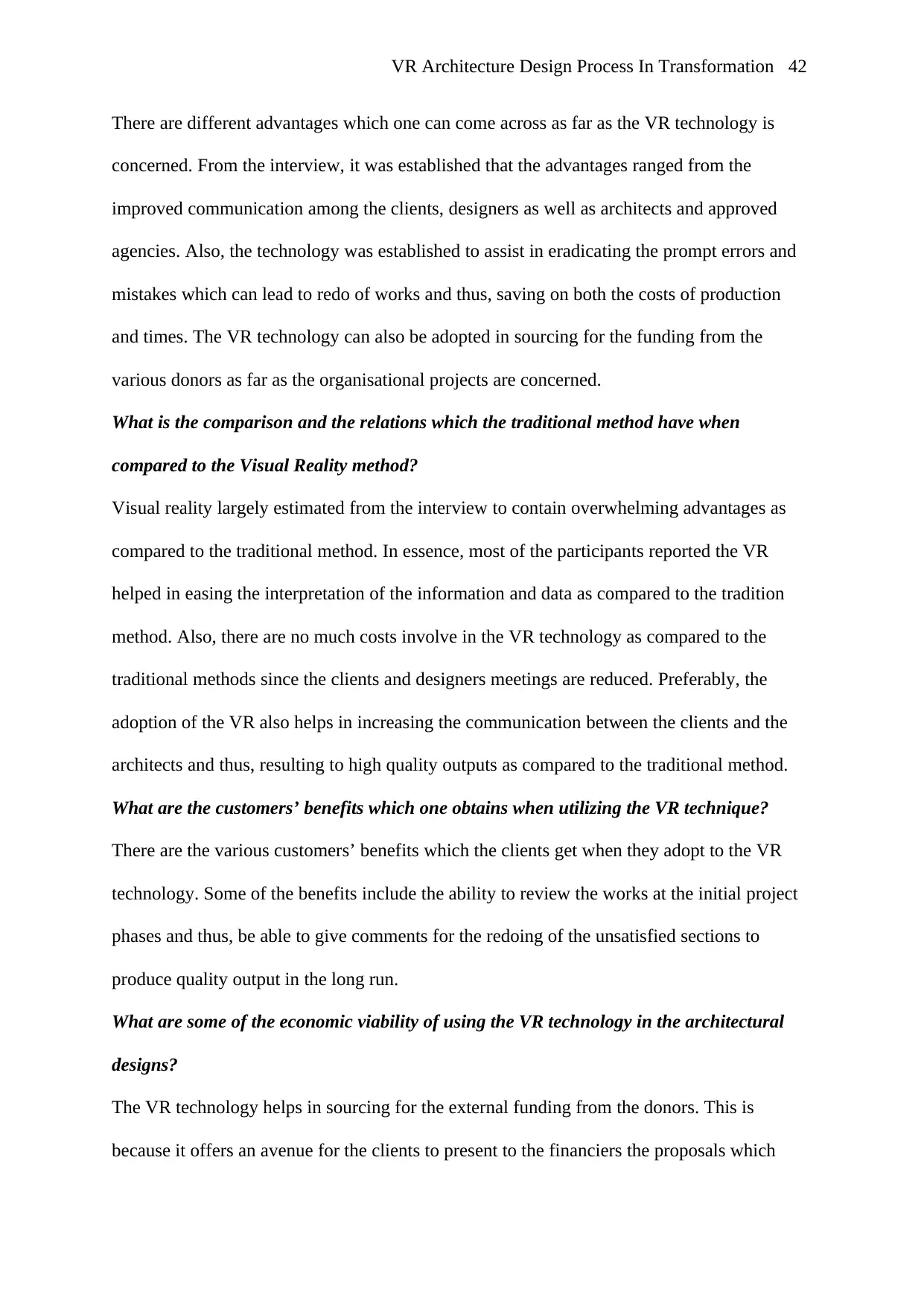
There are different advantages which one can come across as far as the VR technology is
concerned. From the interview, it was established that the advantages ranged from the
improved communication among the clients, designers as well as architects and approved
agencies. Also, the technology was established to assist in eradicating the prompt errors and
mistakes which can lead to redo of works and thus, saving on both the costs of production
and times. The VR technology can also be adopted in sourcing for the funding from the
various donors as far as the organisational projects are concerned.
What is the comparison and the relations which the traditional method have when
compared to the Visual Reality method?
Visual reality largely estimated from the interview to contain overwhelming advantages as
compared to the traditional method. In essence, most of the participants reported the VR
helped in easing the interpretation of the information and data as compared to the tradition
method. Also, there are no much costs involve in the VR technology as compared to the
traditional methods since the clients and designers meetings are reduced. Preferably, the
adoption of the VR also helps in increasing the communication between the clients and the
architects and thus, resulting to high quality outputs as compared to the traditional method.
What are the customers’ benefits which one obtains when utilizing the VR technique?
There are the various customers’ benefits which the clients get when they adopt to the VR
technology. Some of the benefits include the ability to review the works at the initial project
phases and thus, be able to give comments for the redoing of the unsatisfied sections to
produce quality output in the long run.
What are some of the economic viability of using the VR technology in the architectural
designs?
The VR technology helps in sourcing for the external funding from the donors. This is
because it offers an avenue for the clients to present to the financiers the proposals which
⊘ This is a preview!⊘
Do you want full access?
Subscribe today to unlock all pages.

Trusted by 1+ million students worldwide
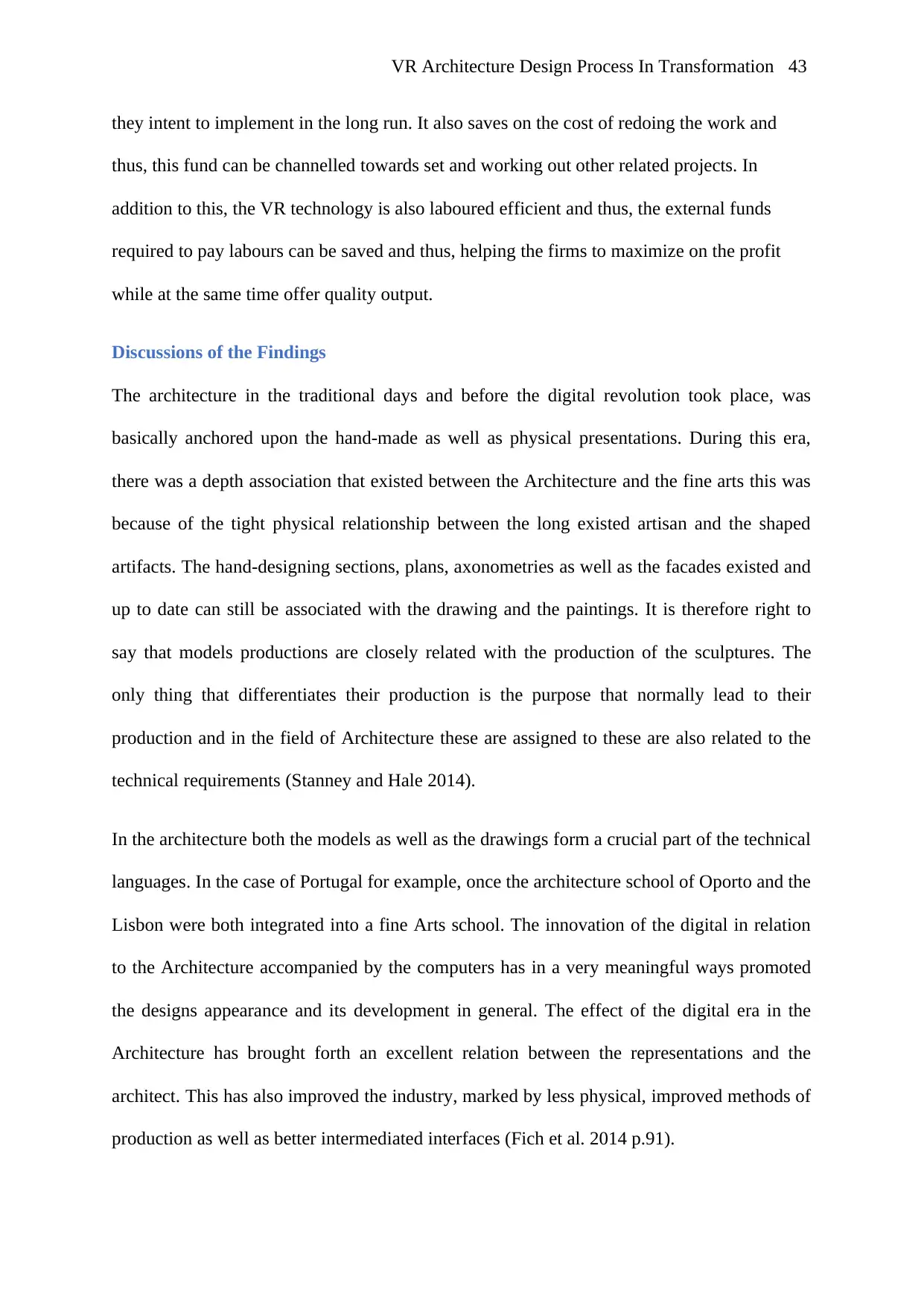
they intent to implement in the long run. It also saves on the cost of redoing the work and
thus, this fund can be channelled towards set and working out other related projects. In
addition to this, the VR technology is also laboured efficient and thus, the external funds
required to pay labours can be saved and thus, helping the firms to maximize on the profit
while at the same time offer quality output.
Discussions of the Findings
The architecture in the traditional days and before the digital revolution took place, was
basically anchored upon the hand-made as well as physical presentations. During this era,
there was a depth association that existed between the Architecture and the fine arts this was
because of the tight physical relationship between the long existed artisan and the shaped
artifacts. The hand-designing sections, plans, axonometries as well as the facades existed and
up to date can still be associated with the drawing and the paintings. It is therefore right to
say that models productions are closely related with the production of the sculptures. The
only thing that differentiates their production is the purpose that normally lead to their
production and in the field of Architecture these are assigned to these are also related to the
technical requirements (Stanney and Hale 2014).
In the architecture both the models as well as the drawings form a crucial part of the technical
languages. In the case of Portugal for example, once the architecture school of Oporto and the
Lisbon were both integrated into a fine Arts school. The innovation of the digital in relation
to the Architecture accompanied by the computers has in a very meaningful ways promoted
the designs appearance and its development in general. The effect of the digital era in the
Architecture has brought forth an excellent relation between the representations and the
architect. This has also improved the industry, marked by less physical, improved methods of
production as well as better intermediated interfaces (Fich et al. 2014 p.91).
Paraphrase This Document
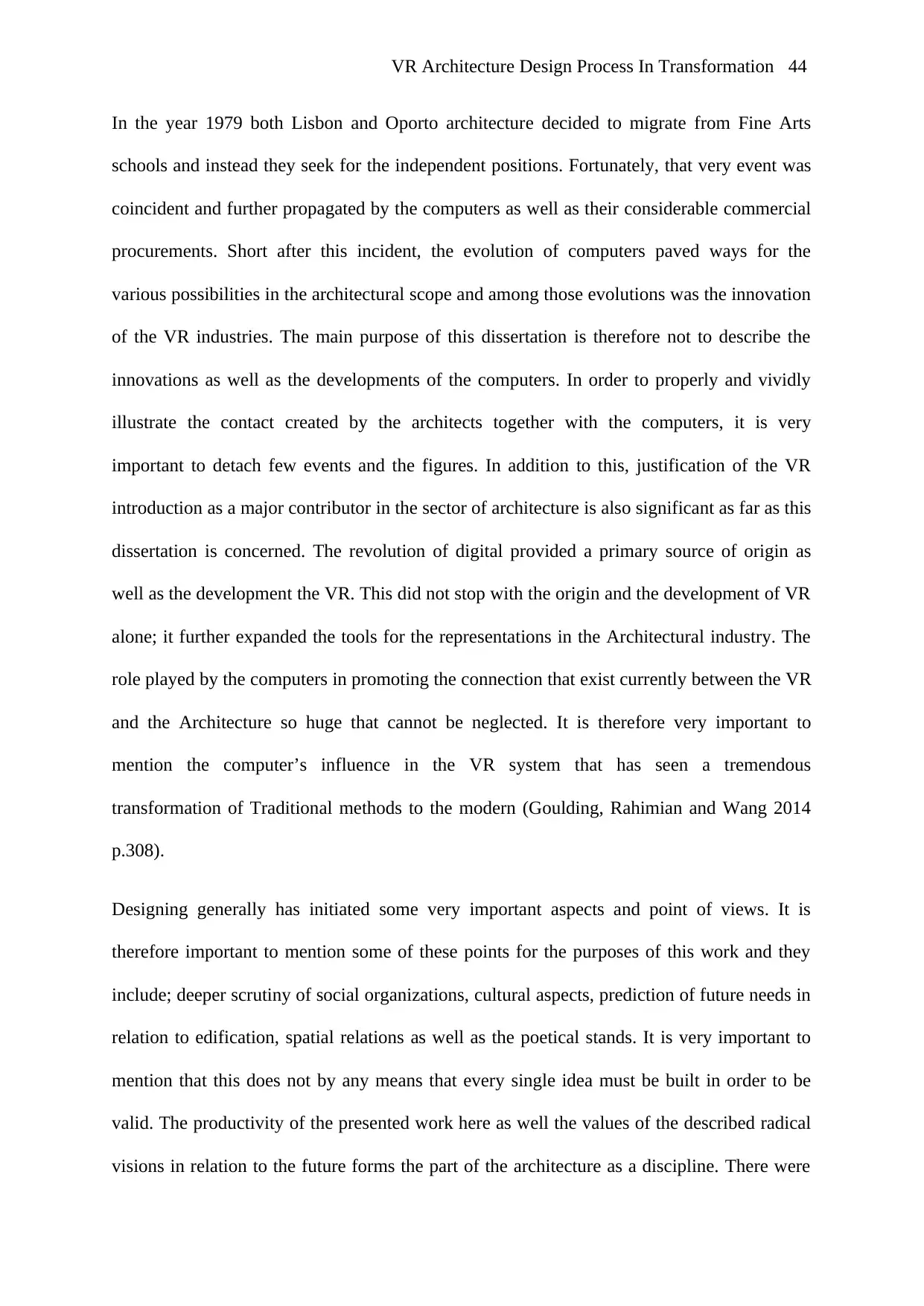
In the year 1979 both Lisbon and Oporto architecture decided to migrate from Fine Arts
schools and instead they seek for the independent positions. Fortunately, that very event was
coincident and further propagated by the computers as well as their considerable commercial
procurements. Short after this incident, the evolution of computers paved ways for the
various possibilities in the architectural scope and among those evolutions was the innovation
of the VR industries. The main purpose of this dissertation is therefore not to describe the
innovations as well as the developments of the computers. In order to properly and vividly
illustrate the contact created by the architects together with the computers, it is very
important to detach few events and the figures. In addition to this, justification of the VR
introduction as a major contributor in the sector of architecture is also significant as far as this
dissertation is concerned. The revolution of digital provided a primary source of origin as
well as the development the VR. This did not stop with the origin and the development of VR
alone; it further expanded the tools for the representations in the Architectural industry. The
role played by the computers in promoting the connection that exist currently between the VR
and the Architecture so huge that cannot be neglected. It is therefore very important to
mention the computer’s influence in the VR system that has seen a tremendous
transformation of Traditional methods to the modern (Goulding, Rahimian and Wang 2014
p.308).
Designing generally has initiated some very important aspects and point of views. It is
therefore important to mention some of these points for the purposes of this work and they
include; deeper scrutiny of social organizations, cultural aspects, prediction of future needs in
relation to edification, spatial relations as well as the poetical stands. It is very important to
mention that this does not by any means that every single idea must be built in order to be
valid. The productivity of the presented work here as well the values of the described radical
visions in relation to the future forms the part of the architecture as a discipline. There were
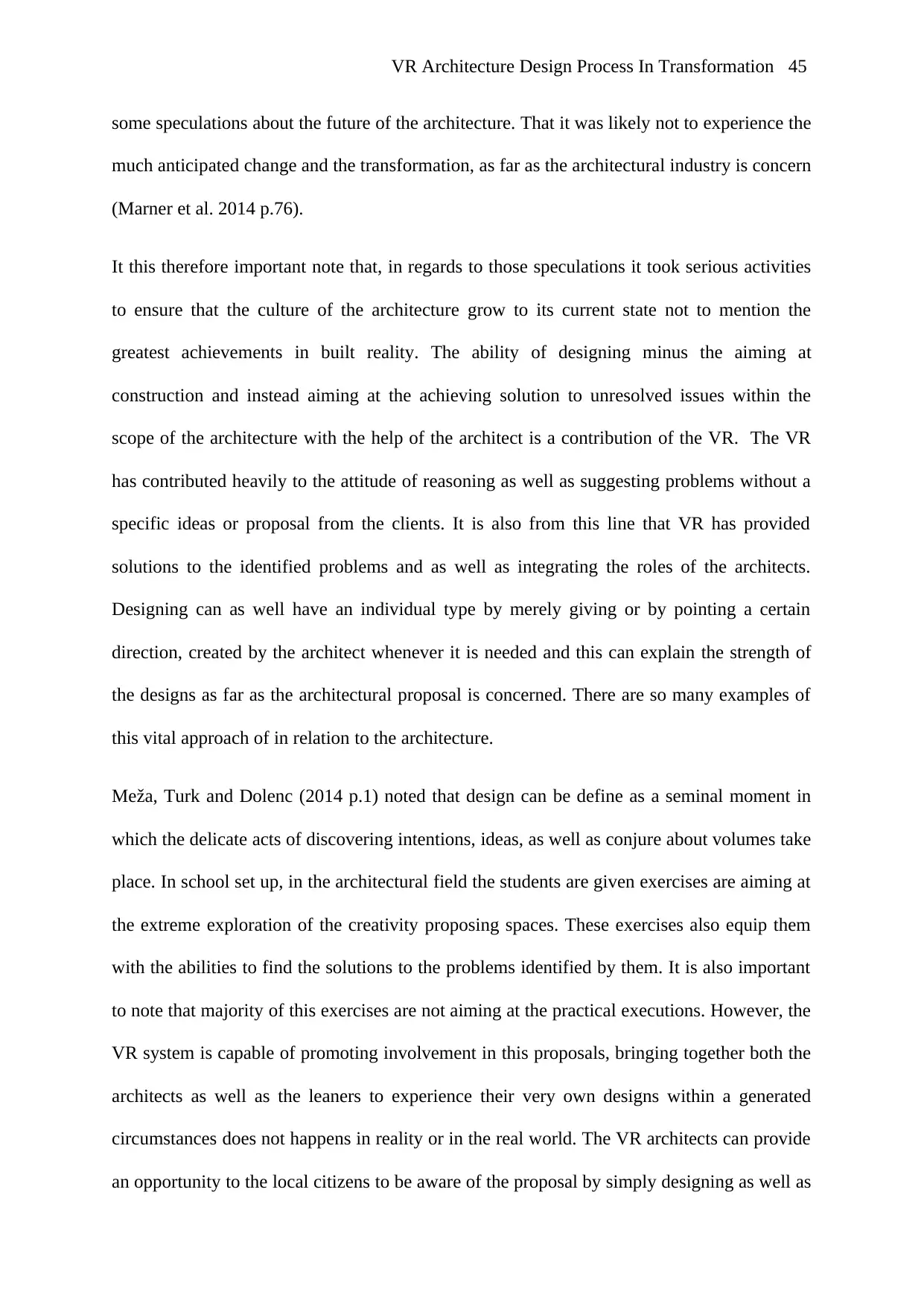
some speculations about the future of the architecture. That it was likely not to experience the
much anticipated change and the transformation, as far as the architectural industry is concern
(Marner et al. 2014 p.76).
It this therefore important note that, in regards to those speculations it took serious activities
to ensure that the culture of the architecture grow to its current state not to mention the
greatest achievements in built reality. The ability of designing minus the aiming at
construction and instead aiming at the achieving solution to unresolved issues within the
scope of the architecture with the help of the architect is a contribution of the VR. The VR
has contributed heavily to the attitude of reasoning as well as suggesting problems without a
specific ideas or proposal from the clients. It is also from this line that VR has provided
solutions to the identified problems and as well as integrating the roles of the architects.
Designing can as well have an individual type by merely giving or by pointing a certain
direction, created by the architect whenever it is needed and this can explain the strength of
the designs as far as the architectural proposal is concerned. There are so many examples of
this vital approach of in relation to the architecture.
Meža, Turk and Dolenc (2014 p.1) noted that design can be define as a seminal moment in
which the delicate acts of discovering intentions, ideas, as well as conjure about volumes take
place. In school set up, in the architectural field the students are given exercises are aiming at
the extreme exploration of the creativity proposing spaces. These exercises also equip them
with the abilities to find the solutions to the problems identified by them. It is also important
to note that majority of this exercises are not aiming at the practical executions. However, the
VR system is capable of promoting involvement in this proposals, bringing together both the
architects as well as the leaners to experience their very own designs within a generated
circumstances does not happens in reality or in the real world. The VR architects can provide
an opportunity to the local citizens to be aware of the proposal by simply designing as well as
⊘ This is a preview!⊘
Do you want full access?
Subscribe today to unlock all pages.

Trusted by 1+ million students worldwide

exhibiting the VR constructions or the VR cities. In such cases the VR can cat like a portal
for a VR modeling dimensions.
In addition to this, the 3D set-ups can as well be viewed and explored as the actual ones. For
example a professor of the Phenomenology and the theory of Architecture during the
interview with the Portuguese stated that the phenomenology has everything to do with the
creations, with the dreams, with the memories, with the abilities of inhibiting the unprompted
as well as the original innovations of ideas creation. The possibility of inhibiting the ideas
and demonstrating them in a virtual way is an incredible character of the VR. In the master
thesis and the VR is reported that in places like Louvre Museum that has a capacity of 26000
people visiting each and every day, with each individual spending approximately for hours
per session have a accumulatively time consumed of 12 years in a day. However, this stated
time contrasts with the collective duration consumed with the most recently played video
games such as Halo that has an average of 80.5 as well as 3700 years in every day
respectively. It is very evident from the stated figures that the in-built projects can as well be
occupied and experienced at the same time (Fonseca et al. 2014 p.438).
In addition to this, it also reveals that the duration consumed by the users into virtual spaces
can indeed surpass some of the renowned visited destinations in the world. It is important to
note that, this does not imply that virtual places could possibly compete with the physical
places. Instead, it provides an extra field within the Architecture scope for the people in this
field such as the architect further explore. The architect can therefore find an opportunity into
this space. This available opportunity does not lead to the development of more video games
but instead it leads to the possible advantages in people’s predisposition for the purposes of
facing the VR development (Zarka, Kochanovskaya and Pasmore 2019). The fact most of the
people available in that are very much willing to interact with the VR is strictly attached with
the video games. This interesting attitude can as well be associated with other present
Paraphrase This Document
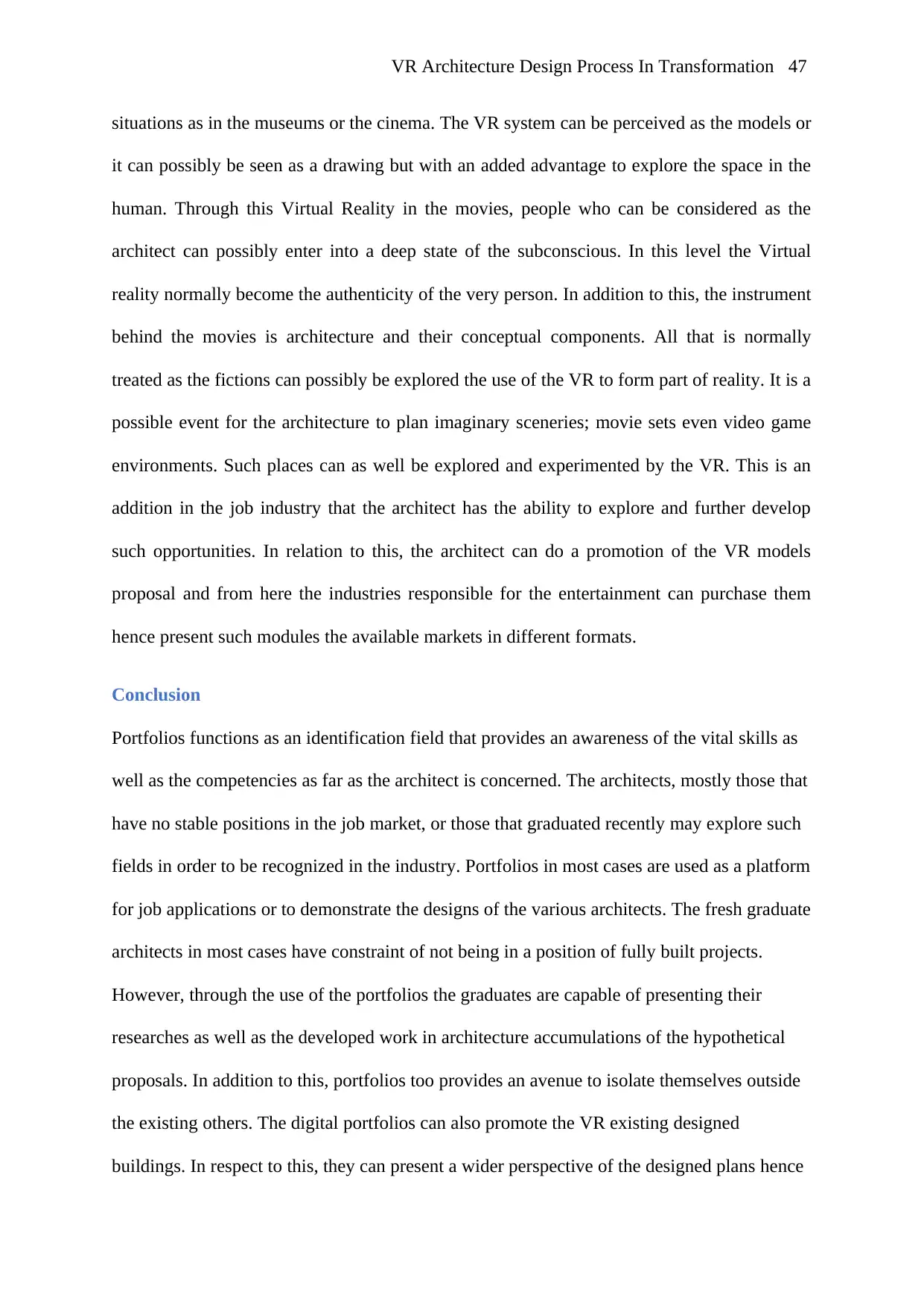
situations as in the museums or the cinema. The VR system can be perceived as the models or
it can possibly be seen as a drawing but with an added advantage to explore the space in the
human. Through this Virtual Reality in the movies, people who can be considered as the
architect can possibly enter into a deep state of the subconscious. In this level the Virtual
reality normally become the authenticity of the very person. In addition to this, the instrument
behind the movies is architecture and their conceptual components. All that is normally
treated as the fictions can possibly be explored the use of the VR to form part of reality. It is a
possible event for the architecture to plan imaginary sceneries; movie sets even video game
environments. Such places can as well be explored and experimented by the VR. This is an
addition in the job industry that the architect has the ability to explore and further develop
such opportunities. In relation to this, the architect can do a promotion of the VR models
proposal and from here the industries responsible for the entertainment can purchase them
hence present such modules the available markets in different formats.
Conclusion
Portfolios functions as an identification field that provides an awareness of the vital skills as
well as the competencies as far as the architect is concerned. The architects, mostly those that
have no stable positions in the job market, or those that graduated recently may explore such
fields in order to be recognized in the industry. Portfolios in most cases are used as a platform
for job applications or to demonstrate the designs of the various architects. The fresh graduate
architects in most cases have constraint of not being in a position of fully built projects.
However, through the use of the portfolios the graduates are capable of presenting their
researches as well as the developed work in architecture accumulations of the hypothetical
proposals. In addition to this, portfolios too provides an avenue to isolate themselves outside
the existing others. The digital portfolios can also promote the VR existing designed
buildings. In respect to this, they can present a wider perspective of the designed plans hence
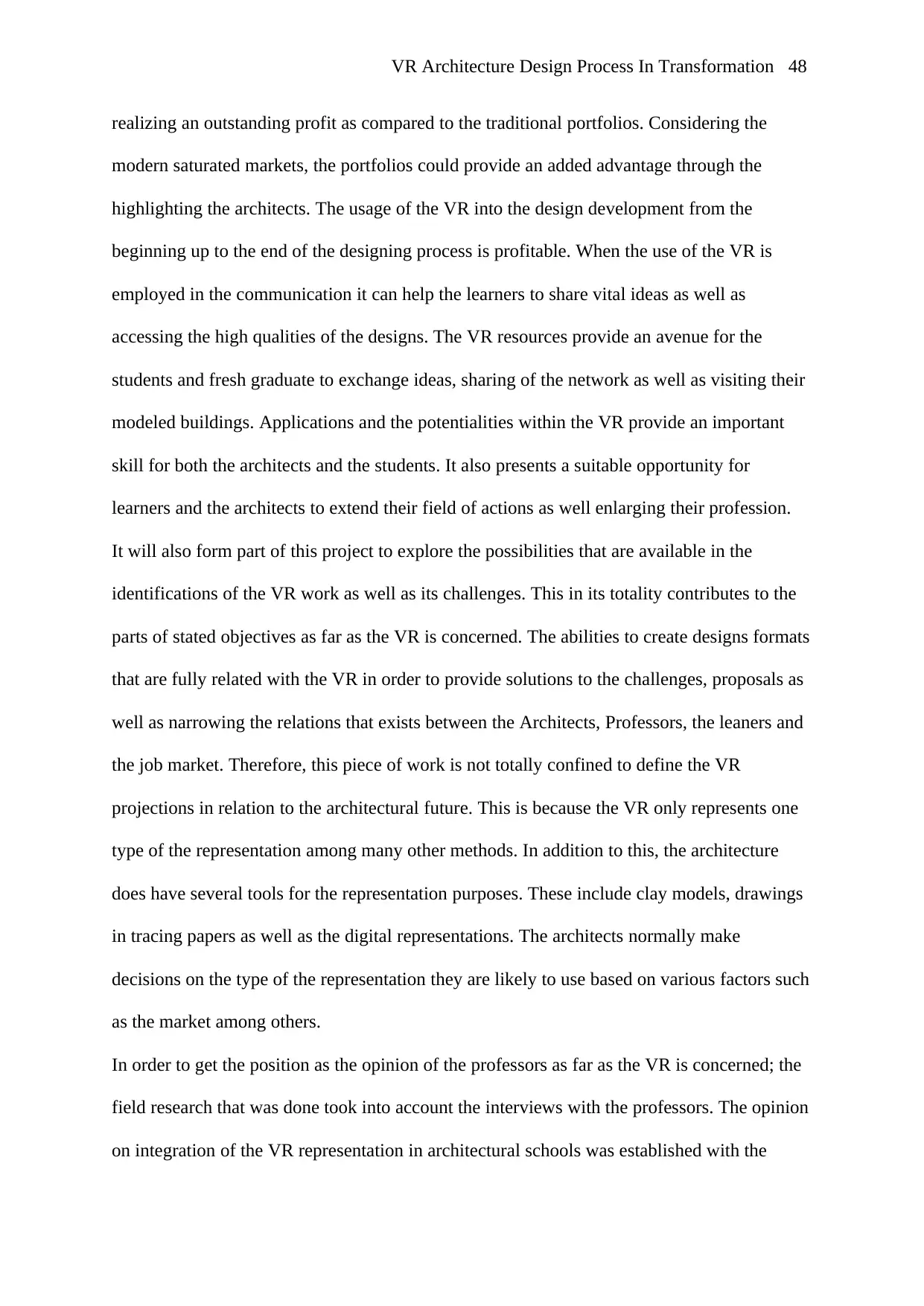
realizing an outstanding profit as compared to the traditional portfolios. Considering the
modern saturated markets, the portfolios could provide an added advantage through the
highlighting the architects. The usage of the VR into the design development from the
beginning up to the end of the designing process is profitable. When the use of the VR is
employed in the communication it can help the learners to share vital ideas as well as
accessing the high qualities of the designs. The VR resources provide an avenue for the
students and fresh graduate to exchange ideas, sharing of the network as well as visiting their
modeled buildings. Applications and the potentialities within the VR provide an important
skill for both the architects and the students. It also presents a suitable opportunity for
learners and the architects to extend their field of actions as well enlarging their profession.
It will also form part of this project to explore the possibilities that are available in the
identifications of the VR work as well as its challenges. This in its totality contributes to the
parts of stated objectives as far as the VR is concerned. The abilities to create designs formats
that are fully related with the VR in order to provide solutions to the challenges, proposals as
well as narrowing the relations that exists between the Architects, Professors, the leaners and
the job market. Therefore, this piece of work is not totally confined to define the VR
projections in relation to the architectural future. This is because the VR only represents one
type of the representation among many other methods. In addition to this, the architecture
does have several tools for the representation purposes. These include clay models, drawings
in tracing papers as well as the digital representations. The architects normally make
decisions on the type of the representation they are likely to use based on various factors such
as the market among others.
In order to get the position as the opinion of the professors as far as the VR is concerned; the
field research that was done took into account the interviews with the professors. The opinion
on integration of the VR representation in architectural schools was established with the
⊘ This is a preview!⊘
Do you want full access?
Subscribe today to unlock all pages.

Trusted by 1+ million students worldwide
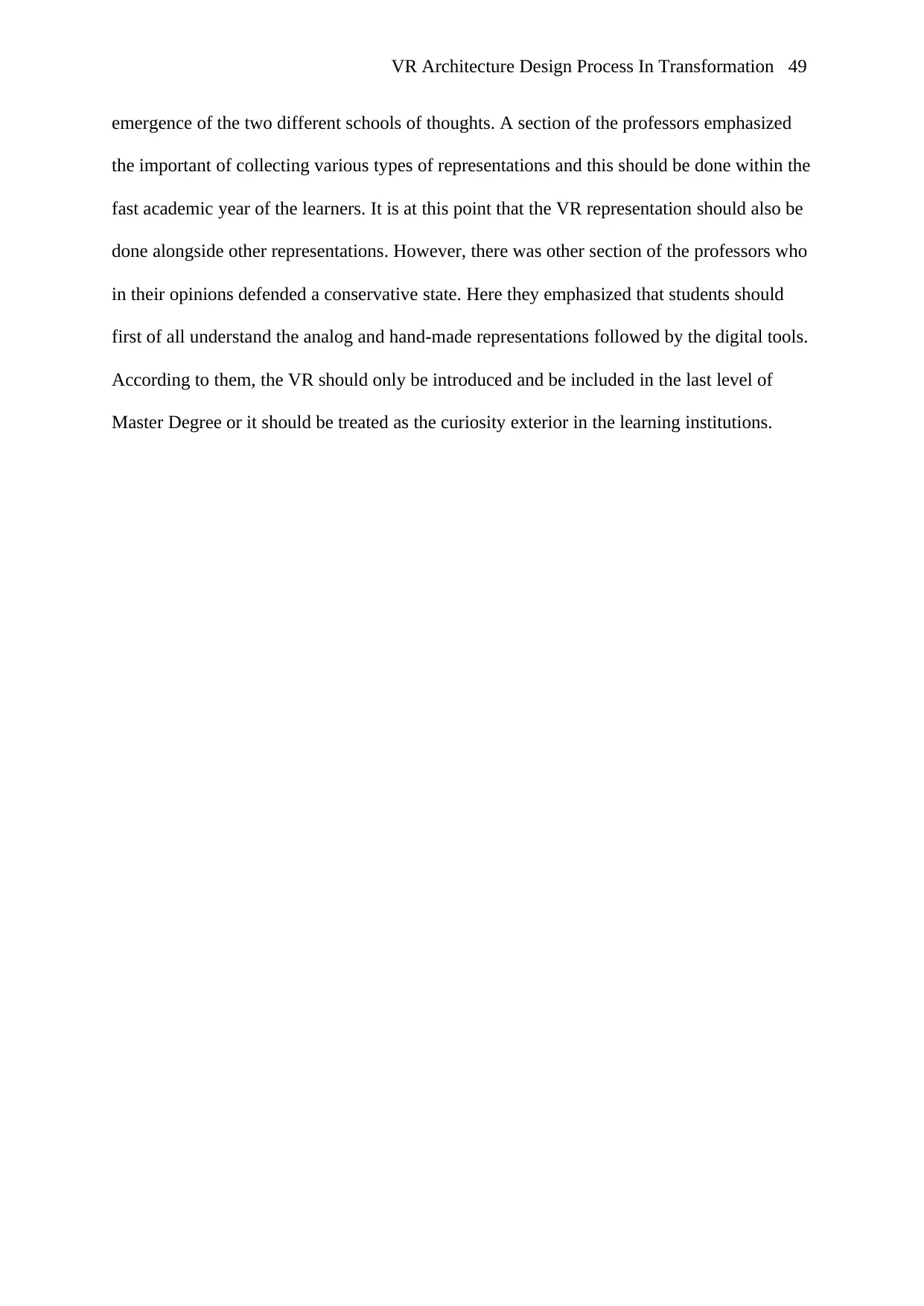
emergence of the two different schools of thoughts. A section of the professors emphasized
the important of collecting various types of representations and this should be done within the
fast academic year of the learners. It is at this point that the VR representation should also be
done alongside other representations. However, there was other section of the professors who
in their opinions defended a conservative state. Here they emphasized that students should
first of all understand the analog and hand-made representations followed by the digital tools.
According to them, the VR should only be introduced and be included in the last level of
Master Degree or it should be treated as the curiosity exterior in the learning institutions.
Paraphrase This Document
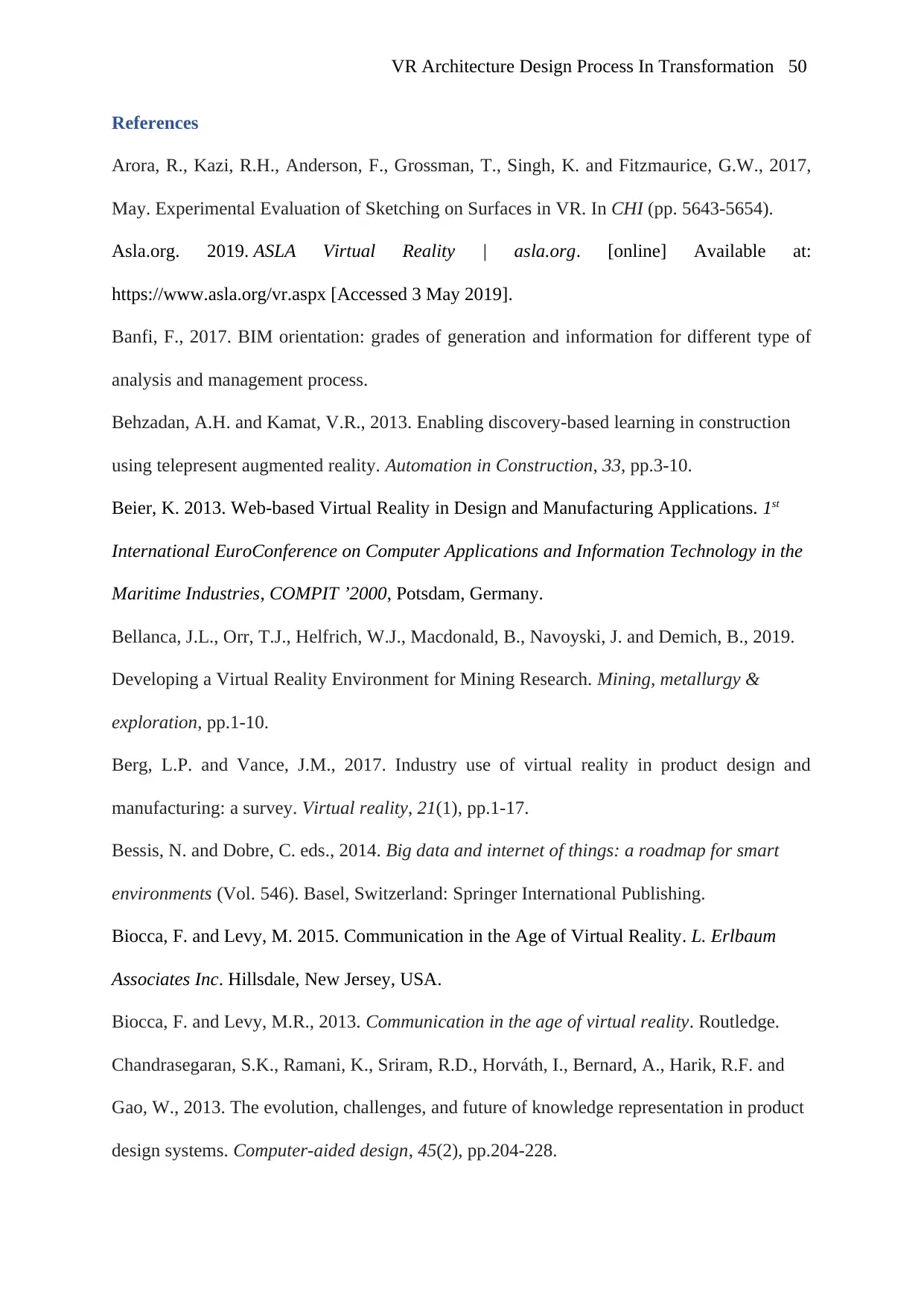
References
Arora, R., Kazi, R.H., Anderson, F., Grossman, T., Singh, K. and Fitzmaurice, G.W., 2017,
May. Experimental Evaluation of Sketching on Surfaces in VR. In CHI (pp. 5643-5654).
Asla.org. 2019. ASLA Virtual Reality | asla.org. [online] Available at:
https://www.asla.org/vr.aspx [Accessed 3 May 2019].
Banfi, F., 2017. BIM orientation: grades of generation and information for different type of
analysis and management process.
Behzadan, A.H. and Kamat, V.R., 2013. Enabling discovery‐based learning in construction
using telepresent augmented reality. Automation in Construction, 33, pp.3-10.
Beier, K. 2013. Web-based Virtual Reality in Design and Manufacturing Applications. 1st
International EuroConference on Computer Applications and Information Technology in the
Maritime Industries, COMPIT ’2000, Potsdam, Germany.
Bellanca, J.L., Orr, T.J., Helfrich, W.J., Macdonald, B., Navoyski, J. and Demich, B., 2019.
Developing a Virtual Reality Environment for Mining Research. Mining, metallurgy &
exploration, pp.1-10.
Berg, L.P. and Vance, J.M., 2017. Industry use of virtual reality in product design and
manufacturing: a survey. Virtual reality, 21(1), pp.1-17.
Bessis, N. and Dobre, C. eds., 2014. Big data and internet of things: a roadmap for smart
environments (Vol. 546). Basel, Switzerland: Springer International Publishing.
Biocca, F. and Levy, M. 2015. Communication in the Age of Virtual Reality. L. Erlbaum
Associates Inc. Hillsdale, New Jersey, USA.
Biocca, F. and Levy, M.R., 2013. Communication in the age of virtual reality. Routledge.
Chandrasegaran, S.K., Ramani, K., Sriram, R.D., Horváth, I., Bernard, A., Harik, R.F. and
Gao, W., 2013. The evolution, challenges, and future of knowledge representation in product
design systems. Computer-aided design, 45(2), pp.204-228.

Cheng, T. and Teizer, J., 2013. Real-time resource location data collection and visualization
technology for construction safety and activity monitoring applications. Automation in
Construction, 34, pp.3-15.
Du, J., Shi, Y., Zou, Z. and Zhao, D., 2017. CoVR: Cloud-based multiuser virtual reality
headset system for project communication of remote users. Journal of Construction
Engineering and Management, 144(2), p.04017109.
Du, J., Zou, Z., Shi, Y. and Zhao, D., 2018. Zero latency: Real-time synchronization of BIM
data in virtual reality for collaborative decision-making. Automation in Construction, 85,
pp.51-64.
Fich, L.B., Jönsson, P., Kirkegaard, P.H., Wallergård, M., Garde, A.H. and Hansen, Å., 2014.
Can architectural design alter the physiological reaction to psychosocial stress? A virtual
TSST experiment. Physiology & behavior, 135, pp.91-97.
Fonseca, D., Martí, N., Redondo, E., Navarro, I. and Sánchez, A., 2014. Relationship
between student profile, tool use, participation, and academic performance with the use of
Augmented Reality technology for visualized architecture models. Computers in human
behavior, 31, pp.434-445.
Goulding, J.S., Rahimian, F.P. and Wang, X., 2014. Virtual reality-based cloud BIM platform
for integrated AEC projects. Journal of Information Technology in Construction, 19, pp.308-
325.
Hwang, K. and Chen, M., 2017. Big-data analytics for cloud, IoT and cognitive computing.
John Wiley & Sons.
Ji, X., Fang, X. and Shim, S.H., 2018. Design and development of a maintenance and virtual
training system for ancient Chinese architecture. Multimedia Tools and Applications, 77(22),
pp.29367-29382.
⊘ This is a preview!⊘
Do you want full access?
Subscribe today to unlock all pages.

Trusted by 1+ million students worldwide
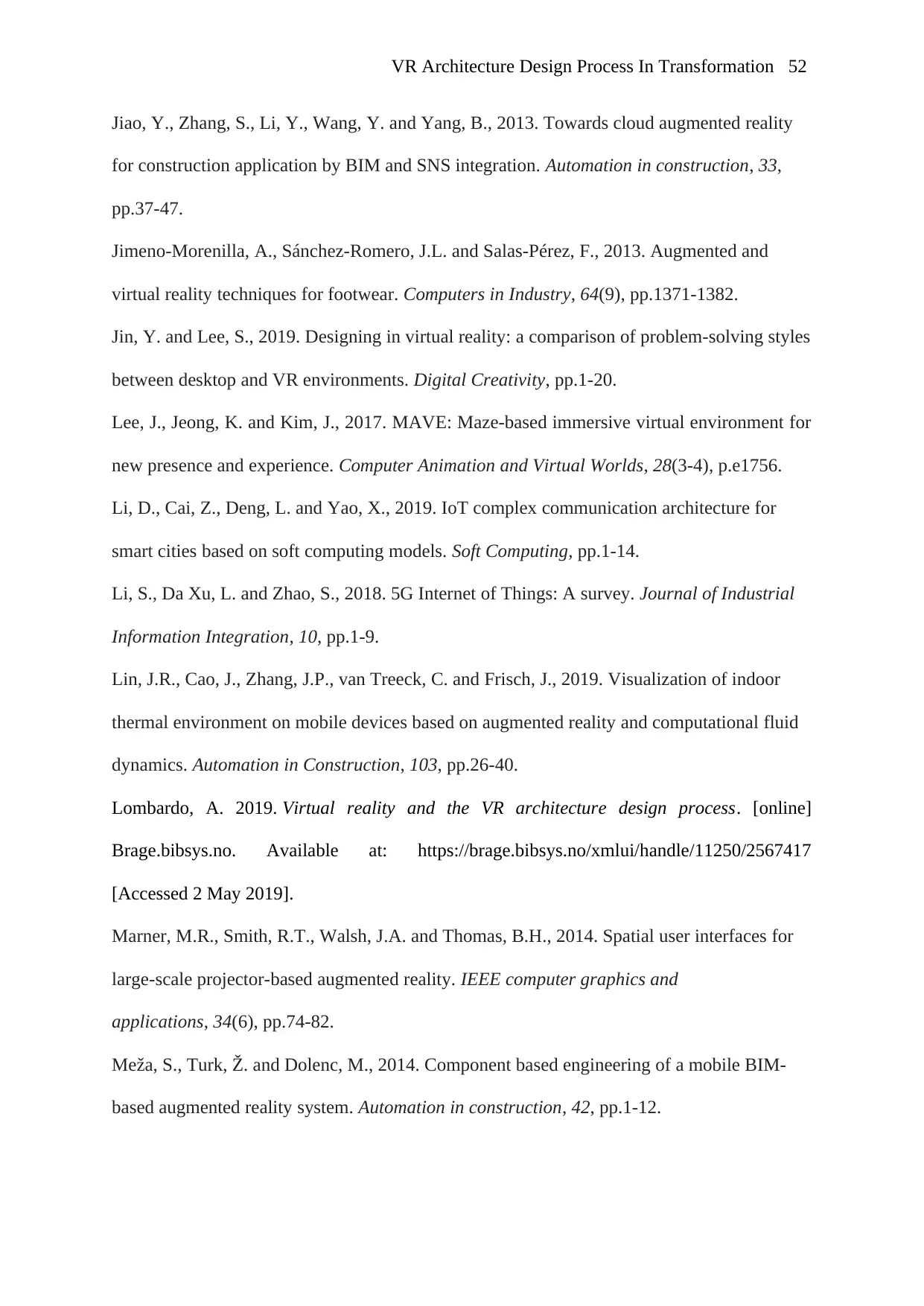
Jiao, Y., Zhang, S., Li, Y., Wang, Y. and Yang, B., 2013. Towards cloud augmented reality
for construction application by BIM and SNS integration. Automation in construction, 33,
pp.37-47.
Jimeno-Morenilla, A., Sánchez-Romero, J.L. and Salas-Pérez, F., 2013. Augmented and
virtual reality techniques for footwear. Computers in Industry, 64(9), pp.1371-1382.
Jin, Y. and Lee, S., 2019. Designing in virtual reality: a comparison of problem-solving styles
between desktop and VR environments. Digital Creativity, pp.1-20.
Lee, J., Jeong, K. and Kim, J., 2017. MAVE: Maze‐based immersive virtual environment for
new presence and experience. Computer Animation and Virtual Worlds, 28(3-4), p.e1756.
Li, D., Cai, Z., Deng, L. and Yao, X., 2019. IoT complex communication architecture for
smart cities based on soft computing models. Soft Computing, pp.1-14.
Li, S., Da Xu, L. and Zhao, S., 2018. 5G Internet of Things: A survey. Journal of Industrial
Information Integration, 10, pp.1-9.
Lin, J.R., Cao, J., Zhang, J.P., van Treeck, C. and Frisch, J., 2019. Visualization of indoor
thermal environment on mobile devices based on augmented reality and computational fluid
dynamics. Automation in Construction, 103, pp.26-40.
Lombardo, A. 2019. Virtual reality and the VR architecture design process. [online]
Brage.bibsys.no. Available at: https://brage.bibsys.no/xmlui/handle/11250/2567417
[Accessed 2 May 2019].
Marner, M.R., Smith, R.T., Walsh, J.A. and Thomas, B.H., 2014. Spatial user interfaces for
large-scale projector-based augmented reality. IEEE computer graphics and
applications, 34(6), pp.74-82.
Meža, S., Turk, Ž. and Dolenc, M., 2014. Component based engineering of a mobile BIM-
based augmented reality system. Automation in construction, 42, pp.1-12.
Paraphrase This Document
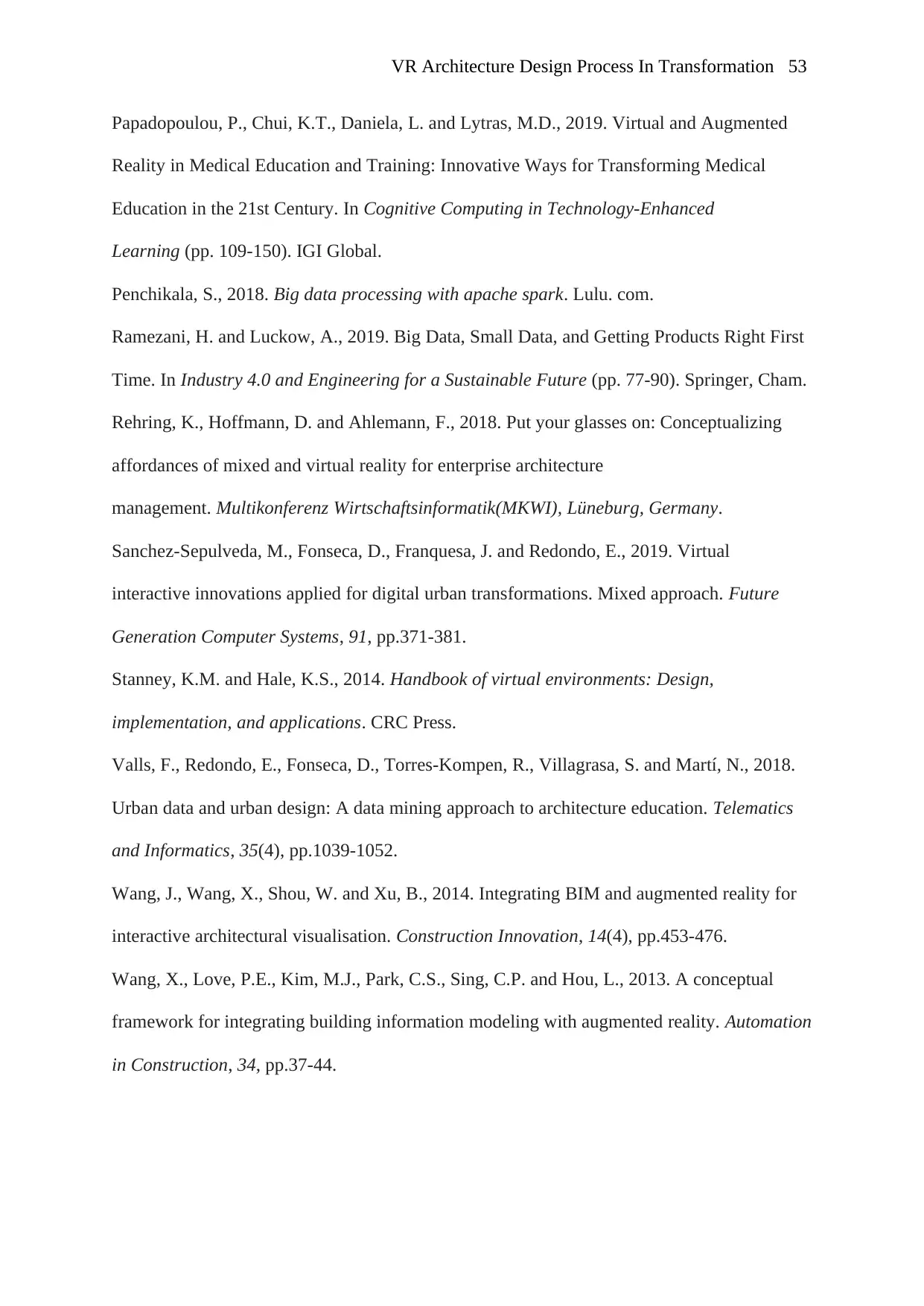
Papadopoulou, P., Chui, K.T., Daniela, L. and Lytras, M.D., 2019. Virtual and Augmented
Reality in Medical Education and Training: Innovative Ways for Transforming Medical
Education in the 21st Century. In Cognitive Computing in Technology-Enhanced
Learning (pp. 109-150). IGI Global.
Penchikala, S., 2018. Big data processing with apache spark. Lulu. com.
Ramezani, H. and Luckow, A., 2019. Big Data, Small Data, and Getting Products Right First
Time. In Industry 4.0 and Engineering for a Sustainable Future (pp. 77-90). Springer, Cham.
Rehring, K., Hoffmann, D. and Ahlemann, F., 2018. Put your glasses on: Conceptualizing
affordances of mixed and virtual reality for enterprise architecture
management. Multikonferenz Wirtschaftsinformatik(MKWI), Lüneburg, Germany.
Sanchez-Sepulveda, M., Fonseca, D., Franquesa, J. and Redondo, E., 2019. Virtual
interactive innovations applied for digital urban transformations. Mixed approach. Future
Generation Computer Systems, 91, pp.371-381.
Stanney, K.M. and Hale, K.S., 2014. Handbook of virtual environments: Design,
implementation, and applications. CRC Press.
Valls, F., Redondo, E., Fonseca, D., Torres-Kompen, R., Villagrasa, S. and Martí, N., 2018.
Urban data and urban design: A data mining approach to architecture education. Telematics
and Informatics, 35(4), pp.1039-1052.
Wang, J., Wang, X., Shou, W. and Xu, B., 2014. Integrating BIM and augmented reality for
interactive architectural visualisation. Construction Innovation, 14(4), pp.453-476.
Wang, X., Love, P.E., Kim, M.J., Park, C.S., Sing, C.P. and Hou, L., 2013. A conceptual
framework for integrating building information modeling with augmented reality. Automation
in Construction, 34, pp.37-44.

Wenge, R., Zhang, X., Dave, C., Chao, L. and Hao, S., 2014. Smart city architecture: A
technology guide for implementation and design challenges. China Communications, 11(3),
pp.56-69.
Yuen, S.C.Y., Yaoyuneyong, G. and Johnson, E., 2013. Augmented reality and education:
Applications and potentials. In Reshaping Learning (pp. 385-414). Springer, Berlin,
Heidelberg.
Zarka, M., Kochanovskaya, E. and Pasmore, W., 2019. Braided Organizations: Designing
Augmented Human-Centric Processes to Enhance Performance and Innovation. IAP.
Zarka, M., Kochanovskaya, E. and Pasmore, W., 2019. Braided Organizations: Designing
Augmented Human-Centric Processes to Enhance Performance and Innovation. IAP.
⊘ This is a preview!⊘
Do you want full access?
Subscribe today to unlock all pages.

Trusted by 1+ million students worldwide
Your All-in-One AI-Powered Toolkit for Academic Success.
+13062052269
info@desklib.com
Available 24*7 on WhatsApp / Email
![[object Object]](/_next/static/media/star-bottom.7253800d.svg)
© 2024 | Zucol Services PVT LTD | All rights reserved.


